Australian
and international
exploratory
performance and
media arts
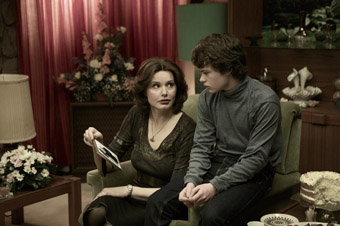
Harrison Gilbertson, Geena Davis, Accidents Happen
GRIEVING—ITS NATURE, ITS STAGES (AS IN THE DISPUTED KÜBLER-ROSS MODEL), AVOIDANCE OR REFUSAL TO LET GO OF IT—IS ONE OF LIFE’S MORE IMPONDERABLE STATES OF BEING. ITS SENSE OF LOSS IS DEEPLY BOUND UP WITH REFLECTIONS ON LOST OPPORTUNITIES AND UNFULFILLED DREAMS AND IS SOMETIMES IMBUED WITH FEELINGS OF GUILT, OF HAVING CAUSED HURT OR EVEN DEATH.
This is the raw material for director Andrew Lancaster and writer Brian Carbee’s remarkable feature film, Accidents Happen, a nervy, funny suburban parable about a family and their neighbours enmeshed in a web of accidents, the causes sometimes innocent, and the complexities of grieving, loyalty and responsibility. Gradually the film’s tone shifts from ironic detachment to demanding emotional engagement as grieving and denial each reach critical mass.
The film opens in 1974 in lower middle class American suburbia with a nasty accident—a neighbour sets fire to himself and stumbles in slow motion, flaming, towards a small boy, Billy, playing beneath a garden sprinkler. It’s an ugly scene but a curiously beautiful one, as if a child’s dreamlike recollection. A little later the boy’s family go to a drive-in where they watch The Three Stooges (with their trademark mix of malice and accident) and suffer eldest son Gene’s bad public behaviour, enacted with his close friend Doug, a neighbour’s son. On the way home the resulting argument plus Billy’s move to the front seat and the father’s distracted driving result in a serious crash. These early scenes, a retrospective prelude, establish the initial mood of the film, brisk, shocking, witness to the role of chance and the complexities of cause, effect and responsibility.
Now it’s 1982: Billy (Harrison Gilbertson) is 15. His father (Joel Tobeck) has left the family for a new marriage, his mother Gloria (Geena Davis) is in bitter denial, keeping the world at bay with dark witticisms and refusing to see Gene, who is in care and visited regularly by Larry (Harry Cook), the second eldest boy, who blames Billy for the car crash (and, cruelly, for the fiery death of their neighbour). Billy, in the manner of his own grieving, emulates Gene by befriending Doug (Sebastian Gregory) and tempting him into misadventure, but their brief partnership causes a very serious accident. From this flow the events that—regardless of the resistance of the protagonists—will bring not today’s much vaunted ‘closure’ but at least release from the stranglehold of grief.
As tense and explosive as this scenario later becomes, the filmmakers nonetheless sustain just enough distance (Gloria’s jibes, Billy’s retorts, glimpsed character eccentricities, coincidences and smaller accidents) to maintain an essentially comic rather than tragic vision. There’s even a touch of deus ex machina in the plot resolution, but in the meantime the emotional drama deepens—trust is betrayed, physical pain inflicted on self and other and relationships are sundered, but equanimity is finally achieved and frozen lives are allowed to thaw and begin again.
A great strength of the film is its ensemble playing with uniformly good performances, script and directorial attention foregrounding each of the characters. It’s quietly done, for example, in the case of Dottie (Sarah Woods), whose suspicions never corrupt her neighbourliness, and more acutely with Ray, Billy’s feckless father, who comes into clearer focus as the film progresses: “But we can’t just wait for Gene to die, Gloria. We’ll waste away with him…Lose all feeling. Turn into vegetables. Make a salad.” Even the most minor figures are deftly sketched: the girl who must hug everyone suddenly and too vigorously at a wake, or Aunt Louise who disruptively appears there too: “Here’s to the living. You know what they say? When God closes a door he opens a beer.” Another neighbour, Mrs Smolensky, the wife of the immolated man, appears briefly if recurrently in what becomes a key symbolic role in a tightly crafted screenplay.
Geena Davis’ Gloria is central to the film, although she’s not always on the screen. Gloria’s loss of two of her children, then her husband to another woman, of her uterus to a hysterectomy and later her trust in Billy is a load she struggles to bear when not withdrawn—playing Bingo with friends, going on a date, always joking (“If I’m lucky, the Department of Health will board me up”). There are revealing moments when she cracks, for example after the wake: “I always think the next funeral will be Gene’s. I can’t go home,” she weeps. When she fears that Billy is turning into the delinquent Gene she atypically can barely speak. When Billy says he can’t recall much about his dead sister Linda, Gloria’s fury demands that he think again, which apologetically he does, because he can with his mother.
The relationship between Billy and Gloria is of easy intimacy, in the way he advises on the choice of earrings before her date or joins in droll exchanges: “Gloria: I’m so hungry I could eat a crowbar and shit a jungle gym. Billy: Good. All those loose screws you have will finally come in handy.” Davis invests power in Gloria’s facade, reveals its fragility and displays a warmth in her relationship with Billy. But hoping to see the overt smiling charm of Davis in this tough mother role risks missing the subtleties of a strong performance.
When Billy finally confesses the full extent of his sins, he argues, “I was trying to protect you.” Gloria retorts, “I don’t need protecting, Billy. I need someone who is on my side, damn it.” In Harrison Gilbertson’s fine performance as Billy, we see an adolescent trapped by accidents not all of his own making, but complicated by lies and loyalties and a rapidly escalating number of ethical crises—dealing almost simultaneously with discrete problems involving his mother, father and Doug and the police. Gilbertson plays Billy with a quiet charm, who at his lowest point sounds not unlike his mother: “I’m sorry you lost your father but this could turn into a great big shit shower with, like…no soap.”
Afforded the luxury of two viewings of the film and a reading of the screenplay, I’m convinced that Accidents Happen is a significant Australian film. Yes, it’s written by an American about his America of the early 1980s, and, yes, Geena Davis aside, it’s directed, acted and otherwise made by Australians and filmed here. For some that’s a problem. But the writer has lived in Australia for 15 years and the film is faithful to his vision. The actors’ accents are largely fine, as accurate if not more so than certain Australian actors who frequently play in Hollywood films with their trans-Pacific accents. Some criticism of the film reminds me of the rejection of Frank Moorhouse’s novel Grand Days from consideration for the Miles Franklin Award on the grounds that it was set in Europe, even though the principal character was Australian. Other criticism finds it difficult to locate the film, as if it’s totally alien. Surely, if with its own idiosyncrasies, it sits firmly in the tradition of the domestic dramas of American indie filmmaking (recently, Little Miss Sunshine, The Savages, Before The Devil Knows You’re Dead, Juno etc) and more commercial ventures in the same idiom like American Beauty and Revolutionary Road (both by British director Sam Mendes).
Accidents Happen is bracing cinema—funny, cruel, suspenseful and wise, never letting the viewer off the moral hook with loveable characters and a predictable tale. Its tonal, structural and thematic integrity is supported by the slightly heightened aesthetic of the production and art design (Elizabeth Mary Moore, Angus MacDonald) and the cinematography (Ben Nott), evoking the 80s while intensifying the everyday in what is a very contemporary, shadowy parable—and something more than mere realism. It’s a tale underscored with an essentially comic vision that allows for redemption and regeneration in a small suburban cosmos, if against the considerable odds of an accidental universe. Great writing, directing and acting make Accidents Happen’s wickedly tough, idiosyncratic vision of grieving a truly memorable experience.
The world premiere of Accidents Happen was in April 2009 at the Tribeca Film Festival in New York and in June 2009 it was shown in the Sydney Film Festival. Australian screenings commenced April 22, 2010.
Accidents Happen, director Andrew Lancaster, writer Brian Carbee, cinematography Ben Nott, editor Roland Gallois, composer Antony Partos, producer Anthony Anderson, production design Elizabeth Mary Moore, art direction Angus MacDonald, Redcarpet Productions; http://www.accidentshappenthemovie.com/
This article first appeared online April 27
RealTime issue #97 June-July 2010 pg. 19
© Keith Gallasch; for permission to reproduce apply to realtime@realtimearts.net
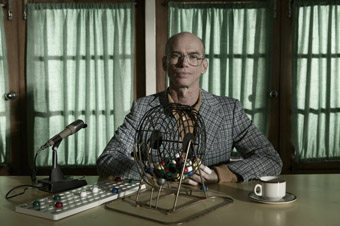
Brian Carbee as Bingo caller in Accidents Happen
BRIAN CARBEE IS THE WRITER OF DIRECTOR ANDREW LANCASTER'S FIRST FEATURE FILM, ACCIDENTS HAPPEN. IT'S ALSO CARBEE'S FEATURE DEBUT, A SCREENPLAY THAT EVOLVED FROM A DANCE WORK INTO A NOVEL AND INTO A SCRIPT.
The film premiered in 2009 at the Tribeca Film Festival in New York and then at the Sydney Film Festival. I met with Carbee as the film’s Australian season was about to be launched prior to American distribution in cinemas and on demand. I asked Carbee to detail the evolution of the film and to place it in the context of his career as an actor, dancer and choreographer and how those roles have influenced the way he writes for a film and collaborates on its making.
background
Born in the United States, Brian Carbee trained as an actor at the University of Connecticut, worked as a dancer and choreographer in Boston and New York and then migrated to New Zealand in 1986 where he created works for Limbs Dance Company, danced with Douglas Wright Dance Company and produced works for his own company, The Jump Giants. Carbee moved to Sydney in 1997 and made In Search of Mike, a 30-minute dance theatre piece which he adapted into an eight-minute film (see RT44) directed by Andrew Lancaster. He created Glory Holy! (see RT41), a much praised text-based dance work for One Extra’s 2000 season of Foursome and the following year made Stretching it Wider (see RT42) in collaboration with Dean Walsh. In 2004 he won the IF Award for Best Unproduced Screenplay for Accidents Happen and in 2005 the script was chosen to be part of the FTO NSW Aurora screenplay development project.
early evolution
How did the film evolve?
Its genesis was an exploration of language in the relationship I had with my mother. At that point it was a duet with a choreographic and a large textual element. I have a background as an actor. That’s where I started dancing, in drama school. So over the years I started to develop work that incorporated text because that was another skill I had and it was really interesting melding the two. It started to morph into various other forms. I did a bit of the material as stand-up once.
I moved to Sydney in 1997. I was approached by Leisa Shelton to be part of Inter-Steps at Performance Space. I thought, let’s re-work it. I was new here and I just wanted to land on something I felt secure with. So I made it into a solo and expanded the choreographic element and kept much of the textual component. Andrew Lancaster was in the audience one night—one of four. He just bailed me up afterwards and said, “Look that was really interesting. I’m a filmmaker and I’d like to make a short film out of it.” And I thought, who is this guy? But he was serious, though it took us quite a while, til 2000, to make In Search of Mike. It kinda sat around on various funding bodies’ desks. It didn’t quite fit the model of what short films were at that point.
Did it involve dance?
I’d basically eliminated the dance element. There’s one little dance piece in it. Up to that point Andrew had made short films, using sound and movement, and music videos and he wanted to branch into dramatic storytelling. He liked the material and thought this would be an interesting way to go. He hooked me up with a computer for the first time and I wrote a script. I wasn’t quite sure what I was doing but he got me through it. In Search of Mike was a big hit. It did really well, sold overseas. We even made a bit of money, which is unheard of. And it actually made the funding bodies take notice. First they weren’t going to fund it at all…then [someone] called us and said, “This is fantastic. Ask for more money.” It was completely surreal. I took all the choreographic elements out [which meant] we were left with the kind of harsher elements of the story which I didn’t feel did my mother much justice. It was a very ‘rough’ piece.
My mother was quite ill at the time. I loved our relationship. I thought it was a great, full relationship. It wasn’t easy but it was rewarding in so many ways. And I just thought, hang on…So I wrote a novel and Andrew read it and optioned it. As the screenplay was nearing production, it really separated quite strongly from the book. The book is quite epic.
The necessary economising that comes with a screenplay.
Yes. Characters went flying out of it—all that stuff. So, 1995-2010, for 15 years the story has been kind of shifting through various media and forms.
developing the script
I wrote a first draft and got money [from Screen Australia, then the Australian Film Commission] to write the second draft. Then after another two drafts, it was accepted into the FTO’s Aurora Script Development initiative. So we had a year focusing and that was the stage that was meant to bring it up to finance-ready, and it did.
Was Aurora helpful?
We had a good year. It worked really well for us. Not that it gives you any answers. It just ups the ante around the film, it shifts your thinking. And it brings a lot of interest to bear on it, which causes you to lift your game as well. As a new writer it really made me feel I had business doing it because, you know, Gus Van Sant was there giving me feedback, and John Sayles and Alison Tilson. It was really confidence-building because they liked it. They thought it had lots of potential, which was the reason it was there.
structure and emotion
What kinds of issues were you addressing in script development?
The real shift that Aurora made was that the script had been a black comedy. At that point it shifted to really bringing up the emotional core of the characters. That was really satisfying to me. It kind of went back to why I wrote the book, which was to bring more depth into what the relationship initially was. They helped mine that.
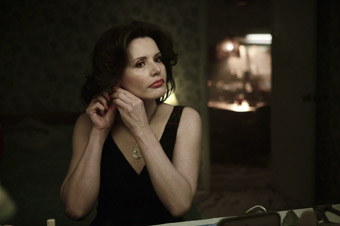
Geena Davis, Accidents Happen
The gradual tonal shift in the film is very interesting, from grimly comic to deeply emotional as the repressed grieving opens out.
It was a real challenge to mix that and to varying degrees of success. People criticise it either way. It’s a tough little balance to get. I think what little tragedy unfortunately I’ve had in my life has been the source of quite amazing humour. How we deal around those extremes of existence is quite broad.
Gloria (played by Geena Davis) puts up so many shields about grief that at the funeral, she’s asking [about the overweight dead man], “What did he do, eat an ice cream truck?” She’s so good at insulating. Then after the wake she breaks down. That wall is such a façade. The trick with her is to find the humour that’s a weapon, but mostly it’s a shield. It’s what keeps her from falling to bits.
So the structure was constantly being addressed so you could get closer to this depth?
And the whole causal effect that really starts to kick in in the film, once the boys make up lies about where they were—it all starts to unwind.
location, location
We were really keen to make the film in America because it’s an American story. It appealed to our sense of adventure and enterprise to do it there. But then, upon investigation and very close to production, the fringe costs and the labour costs and travel costs just blew the budget to such a degree that the percentage of the budget that was actually going to make it onto the screen was so minimal compared to what was going to be spent. Then we talked about, well, can we do it here? You know, there have been enough films made here, set in America, that we have the infrastructure to do it. When we started auditioning, we discovered the kids’ American accents were much better than the older actors. They grow up with it now. So it became an interesting possibility to do it here.
And that was embraced, was it?
It was a hard fight because you go back to funding bodies [who ask] “Why are we making it here? Why are we funding the second-best version of this film, the best being one made in America?” Fortunately, we’d been down that road and we could say, this is actually the best version because we can put a better quality film on the screen for the budget we have. So that was persuasive. In the meantime, Geena Davis got involved because we had been going to make it in the US and that suddenly lifted the finance possibilities.
It was interesting when we were doing Aurora, part of the process near the end of the year involved a follow-up workshop when actors came in and read the workshopped scenes. We said “just use your voices; don’t try to make accents.” And as they were reading, they naturally went into the American vernacular. There was something about the language for them to feel true doing it, they needed the accent. And many of the set pieces, whether about the bowling ball, the baseball, the drive-in, felt much more American than Australian iconic. We had to find the last drive-in in this country to shoot the film in! Then when Geena became involved, we thought well, we’re not gonna have her doing an Australian accent. That would be silly. She jokes that she came over here and her Australian accent was so bad everyone else had to learn American accents.
We got some private money. A British company called Bankside [also handling international sales] and quite a new Australian film funding group, Abacus Film Fund—we’re the first cab off the rank for them.
the re-writing mindset
Were you still writing at this stage?
I was writing right up to production. As it gets closer, all kinds of budget considerations come into play, location and scheduling issues happen. “We can’t afford to go to that location. We have to travel too far. The schedule doesn’t permit it. We need to combine those scenes.” All that stuff. But as a story it was settled.
You didn’t find this stressful?
No, there were so many changes over the years for various reasons and, because it had changed form, I was used to it. My promise to myself was that at any point the challenge wasn’t to change it but to make it better, to accommodate the change. I really feel I was able to achieve this. Even though we had “You can’t go there” and “We have to chop that scene.” It’s like, okay, well how is that a blessing?
When the film was being shot, were you present?
I visited very sparingly. That’s the kind of culture there. It was difficult, but prior to filming I had a great deal of influence really, during casting and location decisions and design.
the writer as collaborator
Andrew and I have a long history, and I was the resident American, the ‘expert’ if you will. The autobiographical nature of the film has been played up, but it’s a fictionalised memoir to a ridiculous extent. But there’s a basic truth to it because elements of it bleed through in terms of the basis of some of the characters. It was important that I have an input into the casting, to really understand and to secure the right people. So I was really lucky. Writers don’t normally get that kind of influence. They’re usually kept to the kerb.
What about in post-production?
Back into the game again. I was giving notes on picture edits, sound, music and marketing—I had a hand in some of that. So from one film, I’ve got a pretty broad knowledge of how the system works.
the dancer's vision
What did your experience in dance and other performance bring to filmmaking?
Over the years I’ve directed shows and had dance companies so I’m used to the production role and working collaboratively. Dance is the great collaborative artform, particularly contemporary dance. Film is also incredibly collaborative. But I think on the dancer level, the great evolution of dance over the last 30 years has been the empowering of the dancer and their artistic expression.
Rather than being the tool of the choreographer. So is dance still a part of your life?
I still perform with Chunky Move when they do Tense Dave. Hopefully they haven’t retired it because I think it still has legs. We had a month in New York with it at one point and a couple of small tours around the States and around Australia. I teach contemporary technique at Sydney Dance Company, and stretch classes and yoga around various gyms. I make my living in a very physical way. The writing is new. I’m still trying to get the novel published and that could finally put that story to bed and I can move on.
Is there a relationship between writing and choreography?
Well I’ve had two writing experiences, one is the book which was very solitary, with the occasional agent or friend’s feedback. The film screenplay has continual feedback, weekly. Both work really well. I really like the collaborative element with the film. It’s how I’m used to working historically. As a dancer, you’re constantly criticised. It’s just part of how it works. So I kind of fell into that. It’s nice having that energy. I’ve read thousands of books but I hadn’t read many screenplays, so it was nice to have that support in terms of the language. I discovered I’m quite good at imagining what something is going to look like on the screen. Being a choreographer, I’m used to seeing visual images. So it played into one of my strengths.
You know when words are not needed.
That’s one of the things that dance has taught me, the power of an image and that the whole comprises many things, not just a performance. There’s a soundtrack, there’s lighting, the composition of each scene. So I intrinsically understand that and know that all the pieces make the story.
film or dance?
The film adventure came along and it was very seductive because suddenly there was all this support and interest and funding and I got swept up in it. At the same time, the dance world was really difficult to penetrate for me. Funding was impossible without going through years of development funding and all this step by step funding. I’ve been doing this work for so long, I’m just not interested in that. I’m a mature artist and I want to make work. And I’ve applied in the past and I got so discouraged because the whole process of asking for funding actually encourages you to lie. And that’s just no way to start an artistic contract. Or if not lie, to fantasise about “What do you hope to learn?” If I knew I wouldn’t need to do this. “How will it benefit the community?” “Why do you want to work with these people?” Well, because they’re fantastic and brilliant and they’ll inspire me and they’re people I want to spend time with.
going deeper
Lastly, I'd like to come back to what you were saying about moving the script away from black comedy into more something more deeply emotional.
That actually brought me home in terms of what I wanted to achieve with the relationship between mother and son and the power of Gloria, who is ball-breaking and totally devoted at the same time.
Did Geena Davis live up to your expectations?
The great thing about Geena is that while the role is at times so unpalatable, she brings a history of likeability. So you cut her a break because you can’t help but like her. She’s adorable. So you go, okay I’m gonna stick with her.
Conversely, Billy appears likeable, but when he starts lying and covering up, if sometimes from altruistic motives, you think that perhaps Gloria's right, that he's selfish, or heading that way. But that's unfair and her wit is cruel: “I’d always hoped you’d amount to something. Maybe I wasn’t specific enough!”
It’s like he doesn’t know quite how to be bad. It’s like the scene with him and the girl next door, Katrina, with the cigarette and the kisses. They’re both trying to act up but they don’t really have the DNA for it.
When Gloria asks Billy about remembering his dead sister, he confesses to a blank—until he’s made to think about it. This amongst others of the later scenes adds considerable depth of feeling.
It was one of the struggles. Early in development, they wanted me to lose Linda altogether. She’s one of the ones I fought for. I thought poor Linda has never been grieved for because she’s been eclipsed by this person, Gene, who’s in limbo, keeping the family in stasis. The double grave is half-empty, waiting for him.
next: the american market
How is the US distribution of Accidents Happen being handled?
That’s the next hurdle, which will happen sometime late their summer. At the moment, we’ve negotiated a couple of screens in major cities and a 12-city tour of Australian films, with Accidents Happen being the headline film. The cinema release will allow Geena again to do publicity tours. Two companies have been contracted in the US, one does the theatrical release and the other is doing ‘movies on demand,’ which is the new basic avenue for getting independent films distributed. It comes via the internet to your TV. It eliminates all the costs of cinemas and prints and publicity. Hopefully it will allow a return somewhere down the line and allow the film to find its own audience.
For more on Accidents Happen see the RealTime+OnScreen review and go to http://www.accidentshappenthemovie.com/; http://en.wikipedia.org/wiki/Accidents_Happen
This article first appeared online April 27
RealTime issue #97 June-July 2010 pg. 18-19
© Keith Gallasch; for permission to reproduce apply to realtime@realtimearts.net
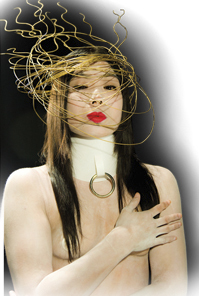
Dante's Inferno, Zen Zen Zo Physical Theatre
zen zen zo: dante’s inferno
Zen Zen Zo's engagement with the classics has included intensely physical realisations of Dracula (see RT80) and The Tempest (see RT92). Now it's The Inferno, the first part of The Divine Comedy by mediaeval Italian poet Dante Alighieri (1265-1321), a wonderful opportunity for the company, in a long line of artists across the centuries, to conjure its own images of Hell.
I asked Stephen Atkins, associate director with Brisbane's Zen Zen Zo, why the company had chosen The Inferno in particular. He explained, “It's been on the backburner for the directors for a number of years and fits the trademark image of the company—the naked form of the human body, images of the grotesque, but always alluding to hope and light in the darkness. That's their performance aesthetic and it really does parallel the content of Dante's poem. The company has tackled classic texts for a long time and they work especially well with physical theatre of a visual and edgy kind. It's a perfect fit. When I came over here from Canada in 2007 to do an internship they asked me to come back and eventually do The Inferno.”
The press release for the show says that The Inferno will be re-imagined in terms of modern Australia. Atkins explains how this transposition is being achieved: “It's done through reading the heart of the poem. It's a secular poem, one of the first ever written in the new language of Italian instead of Latin and was meant for the common man. It's also a political satire, a dark criticism of contemporary Florence. Dante was a philosopher as well as a poet, had many political enemies and a stern point of view, opposing corrupt clergy including the popes. However, a literal transposition that would include the personalities he criticises would have been alienating for a contemporary audience.
“We have taken Dante's concept—the geography of hell, each one of the nine circles punishing more progressively serious sins—and transposed this to our society but with a wry sense of humour, an edgy cabaret sense in the way that Weill and Brecht could make fun as well as poke fun. It's not the poem so much as its shape, although there are condensed sections guiding the viewers through the performance. The audience is going through the same hell as Dante, but 700 years on.”
I ask if the audience will have a guide—Dante has Virgil. “Yes, but updated,” says Atkins. “Dante's text is not very theatrical and a bit like a travelogue, so our guides are tour guides.”
The Divine Comedy is secular is the sense of being written in the vernacular, but it is deeply religious. How, I wonder, will the viscerality of the mode of Zen Zen Zo performance capture more than the punishing torments of Hell. Atkins replies, “Hell is a place of punishment so that performance aesthetic of viscerality and visual impact is very present in our production. But also Hell is a just place where punishments fit the crime. Also, people arrive there from their own choices and a misguided sense of self—they're not sent there by an authority. I think this is what makes it appealing to a secular, humanist audience—it doesn't follow the popular idea of Hell, of the devil on a throne dishing out punishment. According to Dante, Lucifer is the most punished person. If Hell is created by people from their own choices, the light at the end of the tunnel is that we have the keys to our own well being. So we must have the courage to go deeper into dark places in order to come out.”
I ask Atkins to describe something of the performance. He chooses The Circle for Heretics scene: “These are the followers of false wisdom and the corrupters of beauty, meaning of creation. The circle is one of the most severe in upper Hell. Where we have tweaked it is through using images of the distortions of the beauty industry—plastic surgery and the bodies beautiful of models—and what it does to people's self-esteem. These are projected onto the bodies of the dancers. In each of the little vignettes in the work we see the core of the misguided soul and what brought them there. We also see that the soul is unable to get itself out of its state and see beyond. We don't just want to see people being punished—it's about falling into states without examining them.”
I'm curious if, with his large-ish cast, Atkins can also capture some of the epic scope of Dante's Inferno. “The original has images that go from horizon to horizon, with millions of souls,” says Atkins. “But we'll concentrate more on the ideas and the emotional journey through each of these hells. I've tried to incorporate the scale with a couple of large numbers with the entire cast of 19. In the middle of the show, which we have nicknamed “the feeding frenzy”, the whole cast is choreographed by one the company's core members. Dale Hubbard's musical score for the work is as rich and varied as the visual influences from Dante's poem, from swamps to flaming deserts to ice cold wasteland.”
The Inferno will be performed in the heritage-listed Old Museum Building in Bowen Hills, Brisbane offering the audience a distinctive journey through the circles of Hell. Atkins says that circularity is important in the work, “Many of the stations we're setting up are circular.”
Stephen Atkins is the director of Vancouver's Human Theatre and teaches at the Capilano University, but currently spends half his year in Brisbane as Associate Director with Zen Zen Zo: “I'm lucky. And the art scene here is very vibrant, young and very inclusive and accepting of new ideas. I'm having a fantastic time working with the company and we look forward to a very long relationship.” Zen Zen Zo Physical Theatre, Dante’s Inferno—Living Hell, Old Museum Building, Bowen Hills, Brisbane, May 8-20, www.zenzenzo.com
melbourne international jazz festival
With a theme of “celebrating the common chord”, the festival embraces a remarkably wide range of jazz forms and experiences curated by Michael Tortoni and Sophie Brous in a huge program with 400 performers, 95 events and 20 free concerts, 16 world premieres and 21 Australian premieres incorporating film, visual art, public art installations, forums and master classes.
Famed participants include Charles Lloyd, Zakir Hussain, Ahmad Jamal, Mulatu Astatke, Avishai Cohen, John Hollenbeck, Theo Bleckmann and John Abercrombie. But for those looking for edgier jazz and cross-overs, a variety of spaces in Melbourne Town Hall will be home to Overground which features European improvisers Peter Brotzmann (a festival coup, from Germany), Han Bennink (Holland), Brian Chase (Yeah Yeah Yeahs, USA) with Seth Misterka (USA), My Disco (Australia), Mick Turner (The Dirty Three, Australia); Kim Salmon (Australia); Kram (Spiderbait, Australia), Cor Fuhler (Holland), Kim Myhr (Norway) and Oren Ambarchi, Evelyn Morris AKA Pikelet, Bum Creek, Anthony Pateras, Paul Grabowsky with Sean Baxter (Australia).
Elsewhere on the program The Australian Art Orchestra and Paul Grabowsky will present a tribute concert: Miles Davis—Prince of Darkness. Paul Capsis will perform Songs of Love and Death with the Alister Spence Trio and the Melbourne Symphony Orchestra will embrace “the interaction between exploratory improvisation and symphonic music with the Metropolis Series.
At the National Gallery of Victoria, as part of the cross-artform Visions of Sound program, Hybrids & Folklore features The Dead Notes, Hi God People, Joel Stern, Snawklor and Clocked Out Duo working with David Chesworth, in an interactive installation curiously described as “focusing on psycho-folkloric sound-making and improvisation in the natural environment.” The Places In Between features Chris Abrahams of The Necks in an immersive sound and light installation in Federation Square. Melbourne International Jazz Festival, May 1-8, www.melbournejazz.com
lynette wallworth does opera
Among video works for live opera, Bill Viola created enormous images for Peter Sellars' production of Wagner's Tristan & Isolde, and now Australian artist Lynette Wallworth has been commissioned to make works for new opera productions in Europe by major composers. In April, The Netherlands' company De Doelen toured a production of Gyorgy Kurtag's Kafka Fragmente, in which the writers' texts are scored for piano and soprano, with Wallworth's projections as “a third protagonist, a woman making art.” London's Young Vic, in a co-production with the ENO (English National Opera), is currently presenting Hans Werner Henze's Elegy for Young Lovers, directed by Fiona Shaw. For this production Wallworth has created an interactive video installation, responding to the actions of the performers and “inviting the audience to directly engage with the video.” Elegy for Young Lovers, Young Vic, London, April 24-May 8; www.youngvic.org/whats-on/elegy-for-young-lovers
adam geczy performs in gent, belgium
Remember to Forget the Congo is a five-day gallery performance (also webcast) by Australian artist Adam Geczy in Belgium. In a blackened room, he will write in white paint the entirety of Andre Gide's Voyage au Congo, an early 20th century text exposing the iniquity of the Belgian imperial exploitation of the Congo. The consequences live on. Geczy says that although Gide's text has been little remembered it was quite influential when published. The artist describes his action as “simultaneously enact[ing] political and social remembrance of trauma, whilst at the same time being complicit in its repression, since the end result is a white room…a dense palimpsetic residue of words, a skein, that is both beautiful and menacing, acting as both conscience and amnesia.” A performance by Adam Geczy, Croxhapox Gent, May 1-5; presentation May 6-30; www.croxhapox.org; webcast www.ustream.tv/channel/croxhapox
RealTime issue #96 April-May 2010 pg. web
© RealTime ; for permission to reproduce apply to realtime@realtimearts.net
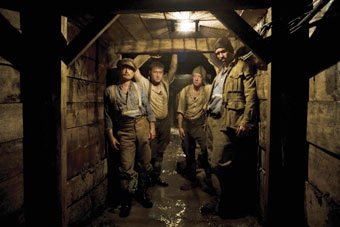
Beneath Hill 60
photo Wendy McDougall
Beneath Hill 60
“TUNNELLING WAS CONSIDERED AN UNGENTLEMANLY WAY OF CONDUCTING WARFARE, IT WASN’T CONSIDERED HONOURABLE. THE GENTLEMANLY WAY TO CONDUCT WARFARE WAS TO CLIMB OUT OF A TRENCH, OVER A PARAPET AND RUN TOWARDS ENEMY LINES WITH A RIFLE…WITH AN AVERAGE AGE OF 42, A LOT OF THE TUNNELLERS HAD DUST ON THEIR LUNGS FROM THEIR MINING DAYS. THEY WERE SICK AND DYING MEN WHEN THEY WENT TO WAR…AFTER THE HOSTILITIES THEY FADED AWAY VERY QUICKLY.” Ross Thomas, Executive Producer, Beneath Hill 60
Jeremy Sims’ first feature Last Train to Freo (2006) was notable for its intense sense of foreboding. A woman caught on a train late at night, trapped by the cat-like menace of an unpredictable man fresh out of prison and hell-bent on confrontation, the film’s real-time unravelling created an acute atmosphere of fear and isolation, that moment when life suddenly spins out of your control. Producer Bill Leimbach (who directed the documentary Gallipoli: The Untold Stories) imagined Sims might be the perfect director for another claustrophobic tale—but here on an epic scale—about a group of Australian civilian miners, called up in World War I, given two weeks rudimentary training, and sent to the hellhole Western front, to start digging and laying mines under the German-held Hill 60.
With the opening scene—a soldier tying his bootlaces up, adjusting his belt, putting his sword in its sheath—we are introduced to the detail of soldierly life. But mining engineer Oliver Woodward (Brendan Cowell) is not your regular soldier. As a civilian, he (and the audience) are rapidly deposited into the tunnels near Armentières, northern France, 30 feet below, where carrying a candle through the darkness, scuttering about like a rat in a maze, his introduction to the men, as their new commanding officer, is: :I can’t seem to find my way out.”
The men use an instrument like a stethoscope to hear through the walls, catching any sounds that may be Germans digging tunnels themselves, or sinking mine shafts. A young boy, Frank Tiffin (Harrison Gilbertson, outstanding as Daniel in Ana Kokkinos’ Blessed [2009], and starring in Andrew Lancaster’s recently released Accidents Happen alongside Geena Davis), paralysed with fear and alone in the dark, is introduced to Woodward. He says he thinks he hears something. With a tap tap, Woodward reveals to the boy that he’s hearing his own heartbeat. As bombs explode around them and rattle the scaffolding, the men hold their cups of tea steady.
Although the underground world is dank and closed in, at least it’s sheltered from noise and rain. As Woodward surfaces for air, his short walk to the officers’ dug-outs (dramatically realised by DOP Toby Oliver, who also worked on Last Train to Freo and, more recently, David Field’s The Combination [2009]) brings home the true horror of men in the trenches, squirming in the mud and rain, bloody body parts left to rot, the continual sonic assault. An introduction to British officer Clayton (Leon Ford) is a reminder of other Australian classics of the war genre, Gallipoli (1981) and Breaker Morant (1980), with laconic Aussies pitted against the English class system in the shape of officers with little pity for the soldiers they’re overseeing. I wish for shades of grey here, beyond the clichés, some insight into these obnoxious Brits, but it’s clearly the way they were seen by many Australian soldiers—the stereotypes persist.
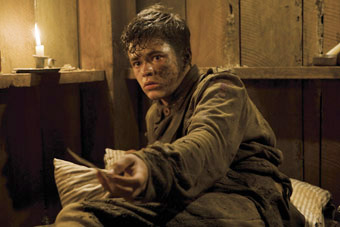
Harrison Gilbertson, Beneath Hill 60
photo Wendy McDougall
Harrison Gilbertson, Beneath Hill 60
Sims has extensive theatrical experience and his strength as a director is clearly in terms of working with actors, especially the younger cast, and ensuring wonderful delivery of idiomatic Aussie dialogue, which rises above sentimentality or uber-nostalgia and goes beyond the well-worn treads of mateship. Although a fine actor, always exciting on screen, the casting of Cowell, however, just doesn’t quite fit: he’s been through so much 30-something angst (the TV series Love My Way; Matthew Saville’s Noise [2007]) that all the soft lighting and makeup in the world can’t make him a believable lad in his 20s, coveting a 16-year-old girl.
The flashbacks to the Queensland homestead, where he teases and seduces the girl (Bella Heathcote), take away crucial pace from a film trying to recreate the dramatic tension of men risking their lives underground. It’s such a long and complicated plotline that by the time the men actually reach the Hill (the bloodiest battle on the Western Front, along the Messines Ridge in Belgium), where the tension should be peaking, the dramatics have started to soak back into the soil, slowly oozing out rivulets from the mine, like the reluctant pump Woodward sets up in front of his superiors. I longed for the tension created in a similar film caught in confined spaces, Das Boot (Wolfang Petersen, 1091), and think with a more focused script and fewer ‘diversions’, Sims and writer David Roach could have achieved it. He also chooses to focus on two German miners on the other side of the wall and while this could have made a wonderfully dramatic connection between the Germans and Australians, the narrative device too leaks the tension rather than building it.
The men, by tunnelling into the blue clay of Flanders beneath enemy lines, are able to lay enough explosives so that the bang, when it arrives, is the largest that the world has ever seen. Sims does well to give a big budget feel to a film that doesn’t have one, transforming sunny Townsville via a rain machine into the quagmires of France and Belgium. It’s an immensely ambitious project with a captivating story that’s taken 90 years to reach the surface. For the most part, Sims and his strong ensemble cast bring the feature to life with more force than many US action flicks can manage.
Beneath Hill 60, director Jeremy Hartley Sims, producer Bill Leimbach, writer David Roach, cinematographer Toby Oliver, composer Cezary Skubiszewski, editor Dany Cooper, production designer Clayton Jauncey, www.beneathhill60movie.com.au
RealTime issue #96 April-May 2010 pg. web
© Kirsten Krauth; for permission to reproduce apply to realtime@realtimearts.net
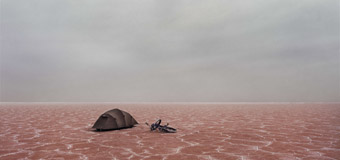
Murray Fredericks, Salt
courtesy the artists
Murray Fredericks, Salt
SALT BEGINS WITH ONE OF THE MOST ASTONISHING OPENING SHOTS OF RECENT FILM. WE’RE ON LAKE EYRE. LIKE THE MIRROR LAKES NEAR MILFORD SOUND IN NEW ZEALAND, WHEN LAKE EYRE HAS WATER, THE SKY REFLECTED IS SO CRYSTAL CLEAR THE JOIN BETWEEN LAND AND SKY MAKES A NEW LANDSCAPE.
A black speck emerges from right of frame. It’s difficult to make out as it glides towards us. An ambiguous image. Like a Rorschach inkblot brought to life. Is it a sea creature? An alien? A two-headed monster? As the speck hurtles towards the screen, it becomes a man on a bike, carting his photographic equipment on a trailer. It’s like he’s cycled down from the clouds.
Murray Fredericks is a landscape photo-artist. For six years he has been camping on Lake Eyre (alone for up to six weeks each time, often twice a year) and setting up his tripod, searching for “a landscape devoid of features,” pointing his camera “into pure space.” From 2006 to 2008 he also took a video camera, capturing his day to day musings on art, nature, family, grief and the complexities of surviving as an artist—in a video diary interwoven with time-lapse photography and stunning images of the lake.
Salt, a joint effort by Fredericks and co-director Michael Angus, is an amazingly accomplished short documentary considering the isolation and the difficulties of shooting in various weather conditions on the lake. With no crew on board, the lone Fredericks frames each shot carefully, capturing stillness rather than motion. His monologuing, his intimacy with the camera as we sit in the tent with him, capture his moods, etch into the silent landscape. Fredericks has a talent for words as well as images, and there’s poetry in his everyday observations or in his conversations with his wife on the phone, describing meals (his favourite, porridge, over a camp stove), honestly questioning his art-making or meditating on the nature of self and loss in such an overpowering landscape.
As with the documentaries, Contact (Martin Butler, Bentley Dean, 2009; see RT93) and Night (Lawrence Johnston, 2003, see RT83), in Salt the landscape takes over the frames, dwarfing the protagonist and his tent. Fredericks describes how being completely alone, “to the point where [he] can’t see land any more” for 360 degrees, brings him into a dream state, immersed in a void, where even the smallest sounds—brushing his teeth—become magnified, where you end up “watching your thoughts…like a television.” He drifts into a life of rituals—preparing meals, cleaning his camera equipment, continuing to work at all costs—to fight off the “negative spiral” of depression that nips at his heels, the fear that he’ll surface at the end of the trip with no wonderful images: “Is there anything lasting?”
This short film is elegantly structured with the answer to that question revealed at the very end, after the video camera is switched off. As an artist Murray Fredericks is interested in exploring “why landscapes (or images of them) move people.” His still frames are so subtle, delicate and Rothko-esque they become impossible to forget.
Salt had its world premiere at the Adelaide Film Festival in 2009 and screened in March 2010 on ABC TV’s Artscape program. The DVD can be purchased from www.saltdoco.com.
Salt, director, producer Michael Angus, director, camera Murray Fredericks, original music Aajinta, editors Lindi Harrison, Ingunn Jordansen, sound design Tom Heuzenroeder, James Currie; Jerrycan Films, 2009
This article first appeared online April 27
RealTime issue #97 June-July 2010 pg. 20
© Kirsten Krauth; for permission to reproduce apply to realtime@realtimearts.net
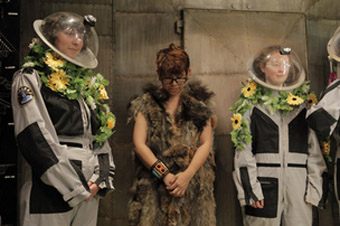
Tape Projects. 100 Proofs the Earth is not a Globe
courtesy Next Wave
Tape Projects. 100 Proofs the Earth is not a Globe
CONSCIOUSLY OR NOT, ARTISTS HAVE LONG PUT AT RISK THEIR BODIES AND SOULS, AND SOMETIMES THOSE OF THEIR AUDIENCES. THEY HAVE TEMPTED THE DISFAVOUR OF CRITICS, AUDIENCES, GOVERNMENTS, MONARCHS AND DICTATORS AND LOST INCOME AND CAREERS.
For much of the 20th century, risk-taking was encapsulated in the notion of a formally and politically disruptive avant garde. In the 21st century the avant garde has been replaced by a multiplicity of agents for change, now busily reclaiming the right to risk as an aesthetic prerogative, and with utopian potential. Such an agent is Melbourne’s increasingly international Next Wave Festival, for and by young adults, directed, for the second time, by the ever energetic and clear-sighted Jeff Khan.
In an era when the artistic manifesto has been usurped by the business plan and society has become increasingly risk-averse (while contrarily wreaking environmental and financial destruction in the name of the free market), the call to experimentation is growing. If hardly a new concept for the arts, the ways in which artistic risk are being realised are evolving differently from their Modernist avant-garde antecedents. I asked Khan about the kinds of risk entailed in the works in this year’s festival.
The theme of the 2010 Next Wave Festival is, rather grandly, “No Risk Too Great.” It’s easy to say, but who and what are at risk in your program?
People inside and outside of the arts have become increasingly ‘risk averse’ so we wanted to open up a space within the festival to critically look at risk from many different angles, including the micro-management of ourselves and our behaviour in a broader cultural context—OH&S, fear of crime and all of that, which are focused on the individual, our rights, our property. We need to look beyond that in our fraught times, of environmental meltdown, of the big systems which are proving to be untenable. We need to be citizens who can step outside of our own comfort zones.
You’re doing this through art but also through talks and discussions.
Where we can drill down into the subject and address the complexity of risk.
Aesthetic risk?
Every act of creation is a risk—starting with nothing and taking a position. A risk averse culture is contrary to the artistic process putting at risk, in turn, the scale and ambition of artists’ projects.
Since at least the 1970s and 80s risk has increasingly manifested as cross-artform, intercultural and multimedia, entailing new performer-audience relationships and a pervasive engagement with media technologies. What kinds of aesthetic risks are being taken in Next Wave 2010?
It’s definitely about the dissolution of boundaries between artforms, collaborations between complementary and sometimes contradictory practices, and especially the engagement with art in a non-art context. One of the things that most excites me has been a real ramp up, for this festival, in the number and rigour of site works that make interventions into the public arena.
What are the risks for site-specific work?
It’s about making meaningful interventions but it’s also about speaking to a non-arts audience at the same time as to an arts audience.
It takes courage as well, or foolhardiness. Both are aspects of risk-taking.
It’s also about the choice of sites, of public spaces. This year’s Sports Club Project evolved out of using night clubs as sites in the last festival. This time we’re establishing a deep engagement with two sports club spaces: George Knott Athletics Reserve, which is a suburban track and field training facility and the MCG, one of the most iconic sports venues in Australia. To really meaningfully intervene in these spaces with integrity is a huge challenge. The artists visited each venue once a week for six weeks, not only getting to know the architecture, but meeting with the sports people and the stakeholders—sports administrators, little athletics clubs, security guards, operations people—to learn about the function of the space both in an operational and a cultural sense. So the artists’ works will be genuine responses to these sites.
Now they’ve assimilated these places, what will they then do in them?
There’ll be a durational event in each venue over eight hours beginning in the afternoon and comprising roving and spot performances and media art works installed in nooks and crannies. People can come and go at any time and will find themselves immersed in these altered environments.
Immersion, sensory deprivation or amplification, one-on-one performances, mass durational events, unusual locations—these are increasingly indicative of the tasks artists set themselves to attract or challenge audiences, to build them into the work.
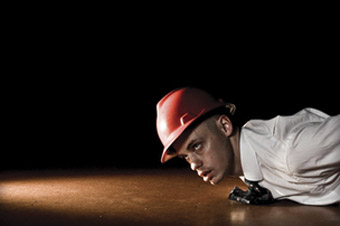
Ashley Dyer, And Then Something Fell On My Head
courtesy Next Wave
Ashley Dyer, And Then Something Fell On My Head
Parts of the program are very immersive, very experiential, like Great Heights, which is staged across Melbourne rooftops. There are performances which are very physically confronting—Ashley Dyer’s And Something Fell On My Head is a full-length performance made entirely of objects that are choreographed to fall from the ceiling of the space towards the audience who are fitted out with safety goggles and hard hats. There are also works where audiences will become participants in unfamiliar places. The Melbourne new media arts collective Tape Projects’ 100 Proofs the Earth is not a Globe is essentially a tour of the Victorian Space Science Education Centre with performance, video and sound, transforming the educational tools. It’s a work that requires the curiosity of the audience as well as a real sense of adventure. A lot of the festival’s projects have a sense of stepping into the unknown.
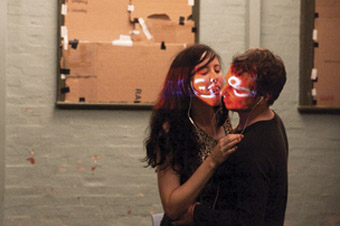
Mish Grigor, Jackson Castiglione, The Short Message Service
© www.maxmilne.com
Mish Grigor, Jackson Castiglione, The Short Message Service
We’re used to the idea of performers tempting fate, as in physical theatre, but now different kinds of risks are being broached. What about Mish Grigor and Jackson Castiglione in The Short Message Service (a collaboration with Lachlan Tetlow-Stuart and Leah Shelton), where the audience text the performers instructions they must carry out? In performance art this kind of approach has sometimes been physically dangerous for the performer.
The success of the show will depend on the fearlessness of Mish and Jackson and how they handle the SMS commands from the audience. The risk is that the premise could result in something banal or something completely out of control, but what tempers it is that fearlessness and the performers’ incredible proficiency in channelling the instructions into creating situations that are dramatic and spontaneous.
And doubtless their skills at improvisation in interpreting the commands.
There’s such a complicated backend tech and media system which underpins the performance, but what elevates it is the quality of the two performers.
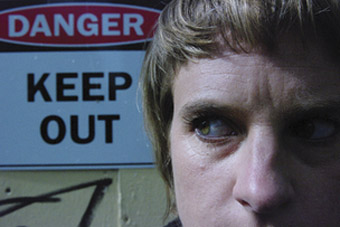
Paula van Beek, Dangerous Melbourne
courtesy Next Wave
Paula van Beek, Dangerous Melbourne
I’m intrigued by Dangerous Melbourne, an advisory session on how to handle the city’s perils.
It follows the format of a community information night and will be presented in a series of town halls across Melbourne where Neighborhood Watch meetings might normally happen. It’s equally a photography and performance event. Paula van Beek’s been doing surveys and research to establish what various samples of the Melbourne population find dangerous about the city. Her photography is a sometimes literal, sometimes abstract interpretation of those fears. People will be given tea or coffee and name tags and a slide show which will accurately represent their fears but also poke fun at big irrational fears in the collective consciousness.
This criss-crossing of fact and fiction is fascinating. Doomsday Vanitas likewise engages with the facticity of fear by being located in Melbourne laneways inhabited by works of art: “sharp, hologram-like projections [creating] a series of ominous still lives” in “a video game-like labyrinth.”
There’s a lovely connection with Dangerous Melbourne here, because Nicole Breedon takes iconography from literature, film and largely computer gaming culture—the icons you ‘collect’ on your visit are everyday objects but become weapons and tools of survival. Both Dangerous Melbourne and Doomsday Vanitas are about being held in thrall by our fears but also about being entertained by them while the world around us melts. What kind of gothic fantasies, for example, will be spun out of the recent volcanic eruption in Iceland?
Managing the growing scale of Next Wave must in itself involve risks. It see that your international project is aptly titled Structural Integrity.
Structural Integrity is the biggest exchange that Next wave has undertaken, with artists from the Asia-Pacific region in residence at the Meat Market. We’ve brought together 11 artist run initiatives and art collectives from across Australia and around Asia. Each is building a pavilion structure to house or represent emerging art in their region. It’s been conceived as a melancholic world fair [LAUGHS] rather then celebrating the values of nationalism. It looks at how grassroots cultures balance their work with their geopolitical position. There’ll be different takes on this. Post-Museum from Singapore are apparently meeting with 20 non-profit organisations from around Melbourne—climate change, anti-domestic violence, arts groups and charities who all believe they can change the world for the better—to organise a collective action which will determine the structure of their pavilion. It’s a utopian collectivity which really reflects the group’s position in Singapore where they support arts projects and live art but also provide a meeting point for activist organisations, as an intersection of art and politics.
The utopian aspect looks like a seriously appealing antidote to risk-aversion.
There’s a strong sense in Structural Integrity of art collectives and artist-run initiatives as providing an alternative social structure. The project is bigger than Ben Hur but it’s looking pretty stunning at the moment.
**********
In a speech about Next Wave 2010, Jeff Khan cited as inspirational the words of French philosopher Simone Weil who in 1943 wrote of risk as an “essential need of the soul,” arguing that “[t]he absence of risk produces a type of boredom which paralyses in a different way from fear, but almost as much.” Next Wave invites its audiences to accept exciting and unnerving challenges—to enter unusual non-art spaces, to become essential ingredients in or agents of creation, to be open to new forms and experiences and to talk risk, in the Risk Talkers program, as well as engage with it as art.
The demands are sometimes epic: Ultimate Time Lapse Megamix is an eight-hour dusk-til-dawn video art marathon on Federation Square’s big screen with works from Australia, Asia and the Pacific. Others are intimate: in Private Dances “audiences will be indulged with a lavish banquet and immersed in a series of private rooms, for one-on-one encounters with some of Australia’s most brilliant young dance artists.” Stranger is Bennett Miller’s Dachshund UN which will “convene a meeting of the UN Commission on Human Rights populated entirely by live dachshunds.” While I Thought A Musical Was Being Made promises “a large-scale performance on the intersection of Russell and Lonsdale Streets that the audience will watch from windows high above the on-street action.” Or you might choose to be spooked in a church crypt by the Sisters Hayes’ A Good Death or find yourself literally inside the performance of Hole in the Wall (RT95). Dive in.
The full 2010 Next Wave program can be found at http://2010.nextwave.org.au/festival/program. Participants in Structural Integrity are: Art Center Ongoing (Tokyo), Boxcopy Contemporary Art Space (Brisbane), FELTspace (Adelaide), House of Natural Fiber (Jogyakarta), Locksmith Project Space (Sydney), Post-Museum (Singapore), Six_a Artist Run Initiative (Hobart), TUTOK (Manila), Vitamin Creative Space (Guangzhou), West Space (Melbourne) and Y3K (Melbourne).
Next Wave Festival, No Risk Too Great, Melbourne, May 13-30; http://2010.nextwave.org.au
RealTime issue #96 April-May 2010 pg. web
© Keith Gallasch; for permission to reproduce apply to realtime@realtimearts.net
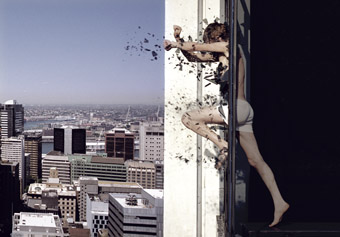
We Have Decided Not To Die
2010 MARKS TEN YEARS SINCE THE FIRST REELDANCE INTERNATIONAL DANCE ON SCREEN FESTIVAL. THE EVENT HAS GROWN ENORMOUSLY IN SCOPE SINCE THEN, BECOMING AN INDEPENDENT ENTITY, OUT FROM THE UMBRELLA OF ONE EXTRA DANCE CO AND PERFORMANCE SPACE IN 2008, AND AN EMERGING KEY ORGANISATION THROUGH THE AUSTRALIA COUNCIL IN 2009.
In May, Reeldance will launch its sixth International Dance on Screen festival and tour under the banner “A Collision of Art, Dance and Film”, the first to be curated by new artistic director, Tracie Mitchell who replaced founding director Erin Brannigan in February last year.
Mitchell’s background is primarily as a dance filmmaker. Her career spans over 20 years and her films are in the collections of the Tanz Museum, Cologne, La Cinematheque de la Danse, Paris, and at the Australian Centre for the Moving Image, Melbourne. She is currently completing a practice based PhD at Victoria University, researching new critical frameworks to describe dance for camera. The basis of her work as a dance filmmaker, researcher, mentor and curator is the broad question “What is dance for screen?” and it is this provocation, as well as her interest in process, experimentation, play and deep passion for the form, that she brings to her role as director for this year’s festival.
Mitchell’s program is diverse. Many of the strands that Reeldance has traditionally offered, like the documentary session (this year Paris is Burning and In Bed with Madonna), international shorts sessions and Reeldance International Dance on Screen Awards, are still in place, but there seems a broader sweep of both high end and low budget films, as well as films made specifically by choreographers and more general art films with an interest in the body and movement. Aptly, the theme for the festival is space—physical, emotional, imaginative space and tensions held in space.
The opening night of the festival represents the high end with the films We have decided not to die by Daniel Askill and The Rape of the Sabine Women by Eve Sussman and the Rufus Corporation (which premiered in Australia at the Melbourne International Arts Festival in 2008; RT87). Both have enjoyed wide audiences internationally outside of the dance on screen genre, but Mitchell enthuses about seeing them within the context of the Reeldance festival. Askill is a filmmaker with a strong interest in fashion, and therefore Mitchell notes an interest in the body, movement and composition. “I think what’s so interesting about the film is the subtleties of movement and the intimacy of the camera to be able to express the coming together of those forms, to actually express something with meaning, rather than an audience looking at something going ‘oh, isn’t that beautiful’.”
Mitchell first saw Sussman’s film as an installation in North Carolina and then again in feature film format at the Melbourne Festival, and was excited about how it addresses elements of dance for the screen. She is interested in the ways Sussman holds the tension between people and space, people to people, and to the camera.
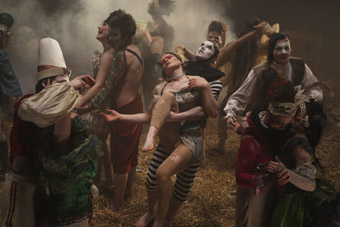
The Forgotten Circus
There will be a retrospective of films by UK artist, Shelly Love, who will be attending the festival as an international guest and hosting labs in Sydney and Melbourne. These will focus on the festival theme of space and will create an environment for testing ideas, embracing spontaneity and play without the pressure of an outcome. Love trained at the Laban Centre in London and is among what Mitchell calls the first generation of choreographers to come out of training into the strong dance screen culture in the UK in the 90s (such as the BBC’s Dance for Camera series, South East Dance, Dance Video at The Place) and to utilise such opportunities. Love received the first dance screen residency at The Place and has ‘crossed over’ into making video clips for bands. Mitchell hesitates to use the word whimsy in relation to Love’s films, but describes watching her work as similar to dropping into Love’s imagination. Mitchell is also interested in Love as an artist whose first language is dance, and whose filmic choices are made through this dancerly perception.
Send The Cameras Out will launch the second stage of Reeldance’s Indigenous Initiative, taking place over a three-year period and providing opportunities for Indigenous dancemakers, editors and composers to engage with making dance for screen works. The session will screen six new dance works made over the last year as part of an intriguing experimental process. Each of the six choreographers was given a camera and one month to respond to the questions “What is dance for camera?” and “What is space?” The raw footage was handed to six editors who created a six-minute edit over a month, and then in turn handed the films to six composers who created a score. The screening will be the first time the 18 artists will see the finished works, and there will be a forum for the artists to respond to the project. Mitchell sees this as an initial experiment to begin to build infrastructure for the ongoing program, and there will be much consultation with the artists on where to go from here.
Out of The Hat is another session with emphasis on experimentation and chance, and comes out of Mitchell’s recognition that there is little opportunity for Australian dance filmmakers to have public screenings of their work. Based loosely on the chance procedures of Merce Cunningham and John Cage, artists are able to register their works and at the beginning of the session an hour’s worth of films will literally be pulled out of the hat for public screening. Each artist whose work is shown will be afforded time for public response to their work.
From the Archives will launch the opening of the Moving Image Collection (MIC), Reeldance’s database project initiated by former director Erin Brannigan, archiving the accumulation of work in the organisation’s history over the past decade for public access and screening works drawn from the collection. In conjunction, there is currently a window installation at the Australia Council building in Sydney with 10 screens showcasing works from the archives. This installation will tour to Chunky Move in Melbourne and the Judith Wright Centre, Brisbane as the festival travels from state to state.
Beyond the individual sessions, Mitchell is interested in the overarching concept of a festival. She reminisces about days spent at the Valhalla Cinema in Melbourne in the 70s with a thermos of tea and packet of shortbread biscuits, watching films from morning to night, submerging herself in the filmic world. She speaks of the importance for her as an artist early in her career of attending festivals overseas to “meet, be inspired, critically respond, investigate, network and be fed” and to create the connections she felt difficult to maintain in Australia at that time. Mitchell’s vision for the Reeldance Festival is to provide a platform where artists and audiences alike can immerse themselves in the world of dance on screen.
To increase the sense of national convergence and conversation, Mitchell has created Artbus, two buses travelling overnight from Melbourne and Brisbane respectively with dance film screenings every hour and places for 48 people on each, who will be guests of the festival in Sydney with access to all screenings, forums and talks. Mitchell wants the festival to be not only about screening dance film, but about process and community too. She likens the process of her curation to creating a fabulous dinner party: you meet great people who give you stories; the surroundings are divine; the lighting’s perfect; you are served a degustation menu, with each taste like an amazing adventure; and you leave exhausted with all your senses satisfied.
Reeldance International Dance on Screen Festival; Performance Space, Carriageworks, Sydney, May 13-16. See www.reeldance.org.au for national tour dates: Perth, Adelaide, Alice Springs, Darwin, Cairns, Brisbane.
RealTime issue #96 April-May 2010 pg. 28
© Jane McKernan; for permission to reproduce apply to realtime@realtimearts.net
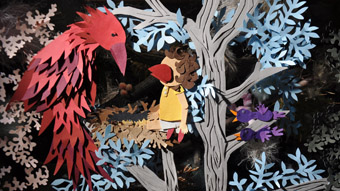
You Were In My Dream (2010), Isobel Knowles and Van Sowerwine
image courtesy the artists
You Were In My Dream (2010), Isobel Knowles and Van Sowerwine
FOR ITS FOURTH INTERNATIONAL BIENNIAL OF MEDIA ART, EXPERIMENTA WAS FRAMED BY THE LURES AND ELUSIVENESS OF INHABITING ‘UTOPIA.’ AMASSING MORE THAN 35 INTERACTIVE AND SCREEN-BASED WORKS FROM AUSTRALIA AS WELL AS INDIA, CANADA, FRANCE, SOUTH AFRICA AND THE UK, THE BIENNIAL CHARTED MYRIAD WAYS MEDIA ARTISTS TODAY ENVISION THE LONGSTANDING DESIRE FOR A BETTER WORLD. WHILE THE TITLE OF THE EXHIBITION, UTOPIA NOW, LEADS ONE TO EXPECT AN IMPLICITLY HOPEFUL ENCOUNTER WITH NEW MEDIA ART, THE SELECTED WORKS RANGED FROM JOYOUS AND HUMOROUS TO DESOLATE AND UNNERVING.
Prompting us to consider a series of possible futures, the theme of the exhibition parallels the concerns of the sci-fi genre where projections of the future function as anxious meditations upon or inspirational extensions of the present day. For myself, it seemed fitting, then, that entry into the Blackbox space resounded with allusions to science-fiction. After passing through a large inflated white façade—itself reminiscent of the gleaming white cities of hope that once appeared in the design of 19th century world expositions and the futuristic city designs of films such as Things to Come (1936)—we are greeted by a suspended garden, Akousmaflore by the French duo known as Scenocosme (Grégory Lasserre & Anaïs met den Ancxt, 2008). Invited to touch the draping tendrils and leaves of the overhanging plants, we discover that this garden can emit sounds and acoustic vibrations.
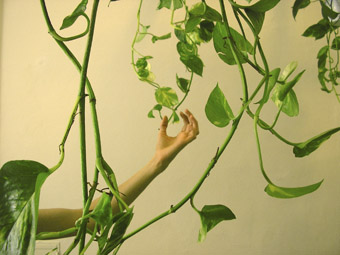
Akousmaflore, Scenocosme
courtesy Experimenta and the artists
Akousmaflore, Scenocosme
Akousmaflore brings together the human, the natural and the technological to imply harmonious fusion. The work itself is founded upon proximity and recognition: as flesh and flora connect, the tiny concealed sensors that are lodged within the greenery become ‘aware’ of our presence and trigger varying sonic effects. One wonders, however, whether or not this leafy chorus harbours darker undertones. In the greenhouses of the future, will the hybridisation of nature and technology lead us towards social betterment or destruction? Such questions became all the more pressing when an occasional scream issued from the garden. At that point, the captivating ‘song’ of the plants ceded to the potential for a botanical uprising—perhaps along the lines of John Wyndam’s novel, The Day of the Triffids (1951)—and I chose to move on.
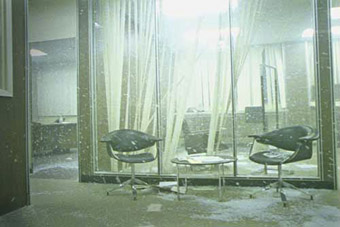
I Feel Cold Today (2007), Patrick Bernatchez
image courtesy the artist
I Feel Cold Today (2007), Patrick Bernatchez
One of the most compelling features of the biennial was its notion of a future still to be decided, through a rhythmic alternation between ominous and optimistic scenarios across the assembled works. Thanks to Sir Thomas More’s Utopia, published in 1516, the idea is commonly understood as the dream of an ideal society or a perfect world. If utopia is an age-old ideal that speaks to our sun-dappled dreams, then Experimenta rightly chose to pay heed to the aesthetic complexity of its curatorial premise by showcasing the prospect of utopias lost as well as found. Alongside the more humorous artworks of the exhibition—for instance, were video shorts that elicited our laughter through the dissonant and the absurd, such as The Hunt (Christian Jankowski, 1992/1997) in which a man, armed with a toy bow-and-arrow, enters a supermarket and deftly spears supplies (bread, milk, a frozen chicken) with child-like abandon, before proceeding to the checkout—are works charged with nightmarish visions of dystopian chaos. To that end, the elegiac I Feel Cold Today (Patrick Bernatchez, 2007) presents us with the darkened flip side of utopian rationality and order. At once beautiful and imbued with a palpable sense of mourning, the work journeys through floor after floor of an abandoned office building, gradually filling with snow. Instead of people, its scenes are filled with office chairs and windswept paperwork. All that is left of capitalism and economic industry are its vestigial remnants, soon to be covered over by a blanket of post-apocalyptic snow.
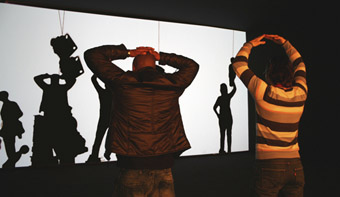
Shadow 3 (2007), Shilpa Gupta
courtesy Experimenta and the artists
Shadow 3 (2007), Shilpa Gupta
Often, it is difficult to separate out the ludic appeals of the works on display from their darker portents as both utopic and dystopic possibilities reside within the same piece. Consider the affective implications of the Indian artist Shilpa Gupta’s large-scale interactive installation, Shadow 3 (2007). What begins as a playful scenario in which the visitor’s shadow is projected life-sized before them gives way to an unnerving ‘string’ that steadfastly attaches itself to our silhouette. Whereas beforehand we had controlled the actions of our shadowed selves, now detritus begins to slide down the string and affix itself to our shadow. Shadowplay animation leads to our own uncanny automation for we cannot halt the accumulating pile of debris. Eventually, our shadows are overcome by a tidal wave of junk, drowned by the rubbish.
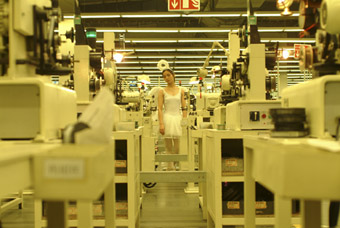
Utopia (2006), Cao Fei
image courtesy the artists
Utopia (2006), Cao Fei
Alternately, Cao Fei’s mesmerising film, Whose Utopia (2006), posits that utopia is where you make it. Set within a light bulb factory in Guangdong, China, Fei’s film entwines scenes of factory workers engaged in mundane and repetitive tasks and the escapist fantasies of four workers. Shots of a ballerina’s poised gestures alternate with images of a man break dancing in the aisles or another man absorbed in strumming an electric guitar, while the drum of industrial machinery, the regimentation of work and the stark lighting of the factory floor persist throughout. Sometimes, utopia is found in the most unlikely or gloomy of places because this is a concept that is tethered to individual hopes and dreams.
Without question, the stand out work of Utopia Now (and a definite crowd favourite) was the Isobel Knowles and Van Sowerwine commission, You Were In My Dream (2010). As the artists so adeptly prove, even the utopias belonging to long since past traditions of art and entertainment can be discovered again and revitalized anew, within the ‘new media’ sphere of technologically augmented art. You Were In My Dream is a glorious stop-motion animation that recalls media art history from the vantage point of the present. Functioning as equal parts perspective box, reflective display and interactive installation, the visitor is seated at a booth and provides the stand-in face for a child protagonist (fed live into the animation). Equipped with a mouse, we are prompted by the appearance of sparkles on-screen to select our chosen path/storyline within an enchanted forest. The densely textured world of You Were In My Dream consists of hand-cut paper human and animal characters, delicate feathers and fronds–demonstrating how such material still persists within the age of the digital. Unlike the traditional perspective boxes of earlier periods of history, however, this work is not confined to a single-user experience. Indeed, the crowds who gathered around the piece seemed just as transfixed by the exterior projection on the side of the wooden box as I was by the world unraveling within it.
Similarly, William Kentridge’s What Will Come (2007) opts to retell the historic atrocities of the Italian invasion of Abyssinia (Ethiopia) through the forgotten media art of the anamorphosis, projecting the ‘real’ story of these events upon a cylindrical surface that dates back to the seventeenth-century. Life Writer (Laurent Mignonneau & Christa Sommerer) also merges the analogue and the digital: you sit at a typewriter, press the keys and the letters generate different codes that result in insect-like creatures swarming across the projected page. The combination of code and artificially-generated creatures from an older mode of writing seem entirely apposite—it is well known that cyberpunk author William Gibson first conceived of the birth of cyberspace from the purview of his own typewriter.
While many of the works contained in Utopia Now do function as somewhat like one-trick ponies—have your digital portrait taken and watch yourself aged via face-reading and morphing software; press a button, hold yourself against a glass panel and see yourself transformed into a suspended, full-body scan—this should not be taken as criticism. Arguably, much of the strength of Experimenta’s Biennial stems from its negotiation of old and new technologies. To that end, I am reminded of what the early film historian Tom Gunning refers to as the pre-1910 “cinema of attractions” as it invoked a presentational rather than representational experience of film and one that directly addressed the spectator. Towards the conclusion of the short digital animation, Please Say Something (David OReilly, 2009), another favourite of mine, a complicated cat and mouse pair steps forward to take a bow and allude to our own appreciation of the display. This is the great strength of the Experimenta Biennial—its deliberate inclusion of the visitors themselves as embodied and vital participants within the artworks.
Decades on from the techno-utopianism that accompanied the beginnings of digital culture and new media art (what the cultural critic Scott Bukatman aptly terms “cyberdrool”), Experimenta continues to bring together old and new technologies, to suggest that no medium ever completely disappears, and invites us to have fun along the way. This biennial might not have been utopia attained but, at times, it did function as an enthralling place to visit.
Experimenta, Utopia Now: International Biennial of Media Art, Blackbox, The Arts Centre, Melbourne, feb 12-March 14
RealTime issue #96 April-May 2010 pg. 27
© Saige Walton; for permission to reproduce apply to realtime@realtimearts.net
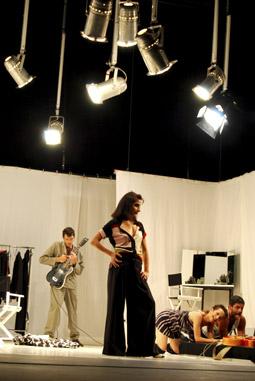
(Not) a Love Song
photo Valério Araújo
(Not) a Love Song
WHAT IS IT ABOUT RIO DE JANEIRO THAT MAKES EVERYBODY GO WEAK IN THE KNEES AT THE MERE MENTION OF ITS NAME? IT FEATURES IN THE TOP 10 MOST DANGEROUS CITIES IN THE WORLD ALMOST AS OFTEN AS IN THE MOST BEAUTIFUL. THIS HAS NOT DIMINISHED ITS ALLURE. SO WHAT DOES AN ANNUAL DANCE FESTIVAL IN THIS MOST GLORIFIED OF CITIES LOOK LIKE?
Founded in 1993 by choreographer Lia Rodrigues, Panorama Dance Festival is currently headed by artistic directors Eduardo Bonito and Nayse Lopez. Now in its 18th year, Panorama has developed into one of the most important platforms for contemporary dance in Brazil, if not in all of South America.
(not) a love song
One of the declared aims of the festival is to present international works to local audiences at affordable prices. On offer this year were works by artists from France, Switzerland, Portugal, Uruguay, Japan, French Guiana and South Africa. Among those, (Not) a Love Song by French choreographer Alain Buffard was an undisputed crowd pleaser and it was easy to see why. Billed as a “tragic musical,” it features an eclectic mix of all-time favourites including Kurt Weill’s “Ballad of Sexual Obsession,” James Brown’s “This is a Man’s World” and Public Image Limited’s “This is not a Love Song,” referenced in the piece’s title. The songs are rendered with idiosyncratic verve by the standout cast—Miguel Gutierrez, Vera Montero and Claudia Triozzi—all renowned performance makers who inimitably people the stylish black-and-white stage with all kinds of quirky characters such as ultra glamorous femmes fatales playing air guitar and a movie director whose only direction to his female stars is “hmmm.” There are also ageing divas and a camp personal trainer who speaks at break-neck speed, gradually transforming into a drill sergeant gone mad. The piece’s movement material is inspired by Broadway razzle dazzle routines and cat walk strutting, the self-obsessed posing of the performers becoming increasingly grotesque. They stagger across the stage, losing control, towards the end turning into dog-like creatures. (Not) a Love Song playfully exposes a world enamoured with itself, obsessed with celebrity and self-display.
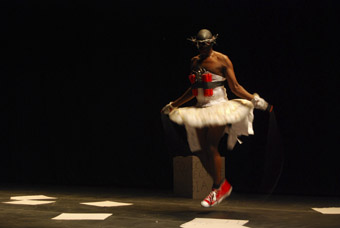
Influx Controls, Boyzie Cekwana
photo Valério Araújo
Influx Controls, Boyzie Cekwana
influx controls: i wanna be wanna be
Strong partnerships with numerous important arts organizations in Europe, such as Arts Admin in London, the Goethe Institut, Alliance Francaise etc, have enabled Panorama to regularly present works by European artists and companies including innovators like Jerome Bel, La Ribot and Jonathan Burrows. Under the artistic directorship of Bonito and Lopez, there has been a push to present more works from Southern Hemisphere countries, especially South America and Africa south of the Equator. It was no surprise then that the involvement of South African choreographer and dancer Boyzie Cekwana in Panorama 2009 was two-fold. He not only mentored young dancers as part of the festival’s residency program, coLABoratorio, but also presented a work, Influx Controls: I Wanna Be Wanna Be. It’s a powerful evocation of the artist’s struggle to negotiate his identity, both cultural and sexual, in South Africa’s post-Apartheid era. At the beginning of the piece, we see Soweto-born Cekwana clad in black pants and a white corset with what looks like a belt of explosives strapped to his chest. His face is painted black and his lips are bright red. He runs on the spot, his arms executing powerful jabs. It looks as if he is fighting. But who is the enemy? The past? Others’ perception of him? History itself? By the end of the work, Cekwana has undergone a striking transformation. He is now wearing a metal crown of thorns and a tutu with strips of papers attached, like price tags. He suggestively crawls across the audience, occasionally stopping for a brief lap dance. Is this the celebration of a new-found identity, proudly embraced, in full awareness of its flaws…? .
brazilian works
Besides presenting new international productions, Panorama also aims to showcase and promote Brazilian work with a focus on artists and companies outside of Rio. As the fifth largest country in the world, Brazil’s geographic dimensions pose similar difficulties for artists to tour their work nationally as those with which Australian artists are familiar. The scope of the Brazilian work presented at the 2009 Panorama Festival is impressive, to say the least. It ranges from Company Quasar’s electrifying athleticism and extraordinary physical comedy skills to Roberto Ramos’ concept-driven movement research, utterly mesmerizing due to the performers’ physical precision and commitment to process.
One of the most intriguing contributions comes from Company Cena 11. In their Embodied Voodoo Game, the concept of the voodoo doll is explored as a potent metaphor for the correlation between dance and video games, the body and new technologies. The roles of manipulator, medium and the manipulated constantly change throughout the piece. Sometimes it’s audience members who manipulate the on-stage action by giving instructions to the performers. At other times it’s the performers who are in control. Using gaming devices such as joysticks and acceleration and motion sensors, they manipulate sound and image projections. Gradually, a sense of danger and violence creeps in, as in the advanced stages of a computer game. Bodies leap through the air and crash to the ground. A female dancer is suspended by her hair extensions. Heavy rocks are balanced on body parts. In the end, the stage is covered with white feathers, electrical fans swirling them up into the air as the performers spin on the spot. It’s an image of arresting beauty that is simultaneously disconcerting. Aestheticized disarray. Game over.
artistic & audience development
Apart from presenting work, Panorama’s major aim is to create opportunities for dance and performance research as well as to raise the profile of contemporary dance in Rio. Throughout the year, audience development initiatives and activities are conducted in order to heighten the awareness for dance. They include free shows for residents of the favelas in the outskirts of Rio and the handing out of booklets in schools. In terms of artistic development, Panorama offers its residency program coLABoratorio.
For a period of several months prior to the festival, emerging artists from Rio and Teresina engage in artistic exchange, mentored by more established artists, both national and international.
Panorama is a massive undertaking made possible through a large number of income sources, predominantly government funding and corporate sponsorship. The festival is also strongly supported by international presenting partners and arts organisations in Rio including the presenting venues and the city’s Choreographic Centre. It’s partly because of these strong partnerships that Panorama’s success has steadily increased over the years. According to artistic director Bonito, the 2009 edition of the festival was the best attended yet.
And from an Australian perspective? Only one Australian company has presented work at Panorama to date, Branch Nebula in 2007. There is hope this might change. Panorama recently added Dancehouse Melbourne to their long list of exchange partners and Bonito and Lopez have become regulars at the Australian Performing Arts Market (APAM) held biennially in Adelaide. It would enrich Australian artists to be able to present work regularly at this diverse and stimulating dance festival.
Alain Buffard, (Not) a Love Song, concept Alain Buffard, cast Miguel Gutierrez, Vera Mantero, Claudia Triozzi, Seb Martel, musical adaptation Vincent Ségal; Boyzie Cekwana, Influx Controls: I Wanna Be Wanna Be, concept and performance Boyzie Cekwana; Quasar, Céu na Boca, choreography Henrique Rodovalho; Roberto Ramos/D.A.M., Continuum, direction and conception Roberto Ramos, performance Catalina Cappeletti, Gustavo Ramos, Roberto Ramos; Cena 11, Embodied Voodoo Game, choreography Alejandro Ahmed and cast, soundtrack and montage coordination Hedra Rockenbach; Panorama Dance Festival 2009, Rio de Janeiro, Nov 5-15, 2009
RealTime issue #96 April-May 2010 pg. 29
© Martin del Amo; for permission to reproduce apply to realtime@realtimearts.net
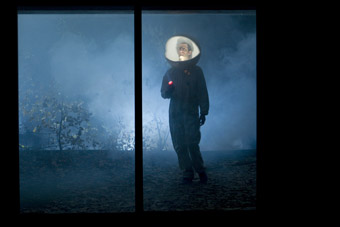
Effet Serge
photo Argyroglo Callias Bey
Effet Serge
IN JANUARY, NEW YORK’S COLDEST MONTH, OVER 2,000 DELEGATES FROM THE ASSOCIATION OF PERFORMING ARTS PRESENTERS (APAP) DESCENDED ON THE CITY FOR THEIR ANNUAL CONFERENCE. APAP IS THE EQUIVALENT OF THE AUSTRALIAN PERFORMING ARTS MARKET (APAM) ONLY, LIKE ALL THINGS AMERICAN, BIGGER. IN AN EFFORT TO EXCITE ARTS PRESENTERS FROM ACROSS THE COUNTRY, PS122, THE PUBLIC THEATRE AND ASSOCIATED ARTS CENTRES TROTTED OUT THEIR BEST AND BRIGHTEST.
For the past five years, Performance Space 122 (PS122) has presented COIL during APAP, an annual winter festival of contemporary performance. It’s an alternative to the compromised format of showcases and, in 2010, COIL was pitched as “14 companies in 12 days.” The works were full-length and open to New York’s holiday-fatigued public to enjoy treats of a different kind. Following PS122’s lead, the Public Theatre presented its sixth annual Under the Radar festival, also during APAP, equally ambitious but with stronger emphasis on theatre and international artists. Despite the sub-zero temperatures, audiences brave the cold and this previous dead period for the performing arts in New York now buzzes.
“Audiences and artists alike have a constant thirst for new stuff,” explained PS122’s Artistic Director Vallejo Gantner. “It’s typical of New Yorkers’ addiction to be the one to ‘discover’ someone or something.” I had coffee with Gantner at his local café where he talked about COIL and more broadly the contemporary performance scene in New York. “In terms of hybrid work, [local artists] have moved through the period of collaborations—the investigative styles of Richard Foreman and the Wooster Group. It seems there’s a renewed interest in ‘screwing around’.” The aesthetic is messy, and Gantner explained that current work directly engages with everyday experience—not dissimilar to work in Australia. “We live a hybrid existence. If anything, audiences have outpaced the work being made.” Gantner cited companies such as Radiohole, Temporary Distortion (who presented Americana Kamikaze at COIL; see RT95) and artist Reid Farrington. “These artists delve into the experiential consequence of technology, demonstrating how we deal with information and data.”
richard maxwell, ads
A good example is Ads, a co-presentation between New York City Players, PS122 and the Public Theatre. Conceived and directed by Richard Maxwell, hyper-real, life-size images of ‘everyday people’ are projected onto an otherwise empty stage. One-by-one, they ‘step’ onto a small, raised platform and orate their beliefs. The high-definition projection, supported by sound that captures the shuffle of footsteps and rustle of clothing as speakers step onto their ‘soapbox’, is so convincing that days later, my friend who saw the show exclaimed over coffee, “They really weren’t there?”
The work began with a woman in her 60s, commenting that adults use Blackberrys like pacifiers. Teenagers have heads bowed, not in prayer, but texting in monosyllables. We’re desperate to stay connected via social networking tools such as Facebook, she lamented, but nothing beats the connection between family and friends over Sunday lunch. “The human connection is missing,” said the projected woman. Subsequent manifestos didn’t resonate with quite the same irony, but did provide an astonishing survey of people and their lives, from musicians to real estate agents, parenting at 50 to existential nihilism. “I believe this world has already ended,” says a man in his early 20s with a t-shirt that reads, “Brooklyn Go Hard”.
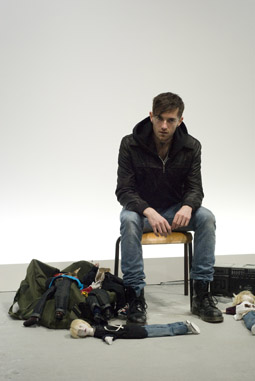
Jonathan Capdevielle, Jerk
photo Alain Monot
Jonathan Capdevielle, Jerk
jerk
At the other end of the spectrum is Jerk, from France, directed by Gisele Vienne, text by Dennis Cooper and performed by Jonathan Capdevielle. Here the only technology used is a boom box. The work relies on puppets to reveal a disturbing story based on serial killer Dean Corll’s murders of 20 teenage boys in the 1970s. Capdevielle portrays David Brooks, one of two teenage boys who assisted Corll in brutally sodomising his victims. Brooks, in prison serving a life sentence, addresses the audience as if to a group of psychology students at a local university, explaining he will use puppets to reconstruct the murders, and suggesting this may help him take responsibility for his actions.
At first, the puppets appear with masks: Corll in a panda mask and Wayne Henley, Brooks’s teenage accomplice, in a white, fluffy dog-like mask. Given comic voices—one very high, one very low—the hand puppets perform like Punch and Judy, except with knives, creating for the audience a separation from the brutality of the actions, perhaps similar to the disconnection from reality experienced by the murderers. When the masks come off, the puppets are unsettlingly more human. Visceral and base, Capdevielle, at times dribbling, delivers an extraordinary performance that makes such sickness plausible, exploring the dark edge of sex and death. David Brooks’ text, which we are directed to read at certain points from a small booklet accompanied by photos and illustrations of the puppets and possibly the victims, adds another level of detail and depravity. The work was slammed by The New York Times, but it stayed with me like a sick and worrying dream [see also PuSh review of Jerk].
east 10th street
With all the boundary-pushing work on show, it was strangely comforting to see East 10th Street by Edgar Oliver. On a sparse stage with only one light, this seasoned performer took us back to the bohemian days of the East Village. Living as a young artist in a boarding house on East 10th Street with his sister, Oliver described in a slightly camp, Vincent Price-type voice, a bizarre collection of characters and events which seemed to emerge from the shadows around him: Donald Milburn who drank vodka with milk; Frances, the “Lady Macbeth of Rags” who spent more time in the share bathroom than in her room; Edwin Linder, with eight padlocks on his door; and Freddie the midget, who never left or entered the house through the front door, but instead used the old coal shute. Oliver weaves in a love affair with the “brilliant and wildly charismatic” Jason Boner that is never consummated, leaving me with an equal sense of longing. By the end I was nostalgic not just for this ghostly and colourful history of the East Village, but for simple, polished and crafted work delivered by a pro.
l’effet de serge
L’Effet de Serge, presented at 3LD Art and Technology Centre in New York’s financial district was not local fare, being an import from Paris-based Vivarium Studio. But it was a festival favourite of mine, and equally charmed New York audiences with its quirky, low-tech premise and staging. Underplayed to great humorous effect by company founder Philippe Quesne, it began with a spaceman in an oversized helmet, lit from within. He explained that this was a show about Serge, and this was Serge’s apartment, but that each show begins with the end of the last show, which had a spaceman in it, hence the outfit. Serge likes to make things, and does small performances for audiences of one or two.
Quesne’s long and languid body heightened each action, whether unpacking groceries, ordering pizza, testing a new novelty toy or awkwardly taking guests’ coats and offering them wine. Delivered with care and attention, the actions were beyond pedestrian, delightfully deadpan yet seductive in making us invest as much in Serge’s mini performances of light and sound as he did.
Despite the Global Financial Crisis, which is far more palpable in the USA than in Australia, audience numbers seem unaffected, and for PS122, Gantner confirmed that box office has never been better. “The majority of New Yorkers live in 400 square metre apartments so they have to get out. It’s not a case of, ‘Do I have the disposable income or not?’ It’s why you’re here.”
APAP Conference, Jan 8-12, www.APAPconference.org; COIL, Performance Space 122, Jan 6-17, www.ps122.org; The Public Theater, Under the Radar, Jan 6-17, www.publictheater.org; New York
RealTime issue #96 April-May 2010 pg. 32
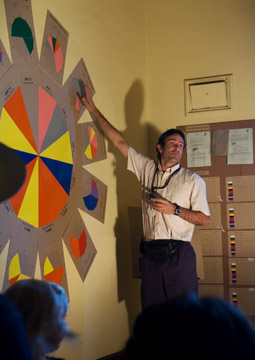
Jason Maling, Triangulation, Second last audit session, In-Habit
photo Tara Gilbee
Jason Maling, Triangulation, Second last audit session, In-Habit
IN-HABIT WAS AN EXCEPTIONAL, INVENTIVELY CURATED MONTH-LONG SERIES OF 11 PERFORMANCE, LIVE ART AND INSTALLATION WORKS SITUATED IN AND AROUND THE ABBOTSFORD CONVENT. INVOLVING NINE KEY ARTISTS, MORE THAN A DOZEN ASSOCIATE ARTISTS AND NUMEROUS PARTICIPANTS, THESE ARTWORKS EMERGED OUT OF A COLLECTIVE RESIDENCY AT THE CONVENT ESTABLISHED BY ARTISTIC DIRECTOR JUDE ANDERSON EXPLORING SITE/PLACE/SPACE AND CULTURAL EXCHANGE.
In One Square Metre the Atherton Community Gardens in Fitzroy are opened to the public for a ‘tour.’ We are greeted in the heat and vibrancy of colour and scent amidst 60 garden beds by Zeynep, a Turkish Australian resident of nearby high rise flats and gardener here since 1969. Zeynep offers everyone dolmades, produce from her garden and the recipe! Jude Anderson serves water and introduces the project and tour. Over 12 months she has cultivated one square metre of garden according to some of the principles of French landscape architect Gilles Clément’s notion of the Planetary Garde: use only seeds offered or found, and no planting—sow as the wind would sow. While also adopting existing rules and practices from the gardeners at Atherton, Anderson’s alternative aesthetic, ethical and ecological practice brought her into immediate, humorous, productive ‘conflict’ and exchange with Zeynep and other Atherton gardeners: bed-ends framing their gardens, a living lattice of wild willow framing hers; theirs organised on pragmatic principles, hers a micro-cosmos of chaos. Anderson, the ‘hopeless gardener’!
It is the fruits of these meetings with community members and the growth of their interactions over time that are made available to us on the tour. Zeynep leads as Anderson and others draw her into conversation. We are introduced to vagabond plants, ‘weeds’, not normally cultivated. Dandelion, for a peppery salad. An Italian woman attending the tour confides, “We survived the Second World War on it. Really, a whole population.” Purslane, common in cracks in the pavement, we learn, is good for constipation. Something of a delicacy in Turkey, the Italians use it in a chicken breast salad. Another tour member tells us it is also being trialled in cardiovascular research. Ah, my vagabond heart! In a kind of culinary ecstasy, we taste, inquire after, debate and receive recipes for Black Sea Cabbage, Sawtooth Coriander, French Sorrel, Stinging Nettle and more.
The work of One Square Metre literally overflows its frame. It is a living artwork and residency in which Anderson creates the conditions for new encounters, competing knowledges, curiosity and exchange. The ‘art’ of the event surpasses her tiny plot of unruly garden, arises in layers of complexity and finds form in genuine reciprocity and learning.
In Triangulation, Jason Maling and Torie Nimmervoll are Colour Auditors. For 12 long days they conduct a ‘prismatic audit’ of the vast Abbotsford Convent. ‘Audit kits’ comprising small coloured flags on poles to be stuck outside room doors are distributed to residents at the convent (staff, artists, health practitioners etc). Participants may change the colour of their flags at any time, on any impulse, for any reason. No prescription is given. At regular intervals throughout the day, Maling and Nimmervoll painstakingly collect and collate the ‘data’ (the colour of the flags) for individual rooms, different floors, separate wings and the convent as a whole. They fashion the results—sectioning, cross-referencing, averaging—into cumulative line graphs and pie charts and present their ‘findings’ to the 50 participants and public in twice-daily ‘briefings.’
These wry, deadpan, faux analyses of the changing colours of the community amuse in their ludicrous seriousness. A possible “politics of Orange” in the East Wing countered by, perhaps, a “collaborative gathering of Green” in the West Wing could, potentially, be the sign of a stand-off! The doubtful sighting by Maling of a blue-tongue lizard in the convent grounds on the very day the data for the whole Convent came up Blue—well, “that was definitely a sign”! But there are no causes, only significances. These briefings are not the most significant aspect of the work. The frame slips. As convent participants are drawn into discussion and gregarious interaction with the performers, it becomes clear that these exchanges are made possible by the live, cumulative progress of the work in which the ‘audience’ have been participants and performers—in chance encounters, meetings, discussions, email exchanges and (suspiciously) clandestine activities — for 12 days. Repetitive and ritual structures already dispersed throughout the project coalesce in these briefings as the participants congregate to share in and further create the work; less to watch a performance than to keep the performance, and themselves, in play. The work finds its significance in the ‘community’ that it helps to form.
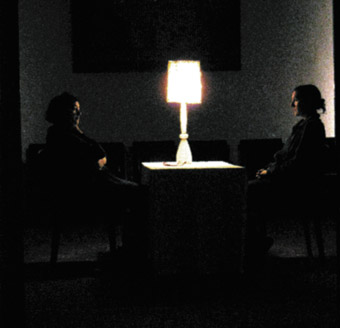
Once, In-Habit
photo Thomas Kokkinos-Kennedy
Once, In-Habit
Katerina Kokkinos-Kennedy’s Once shifts the performative frame still further. It is a live artwork for two people. Participants, strangers to each other, agree to meet in silence for 10 minutes. They are then invited to share their experiences of the encounter in recorded conversations, separately, with two ‘ushers.’
There is a strange, aberrant tension in the convent’s Bishop’s Parlour. The age and restraint of the space and its imagined histories (vows of silence, ‘audiences’ with the Bishop) creep into the experience. I am seated by an usher at a small table with a lamp in the centre of the room. Left alone for a long moment, the tension is interrupted by the entrance of another. A woman sits and establishes direct eye contact. The lamp is flicked on by the usher. The shadows in the room retreat and harden. Silence.
Fast mind. Rapid passage of thoughts and images. Discomfort manifests in smiles and corsetted laughs. We look at each other and away to the edges of the spongy darkness. Our gaze returns to the stranger opposite—often, more often. Time slows. Somehow we begin a conversation in writing. Are we breaking the rules? What is forbidden? What is allowed? We relax into a playful meditation on the nature and quality of silence. An usher enters…the stranger is gone.
Subsequently, sharing experience with the usher is also charged—it too has its intimacies. Like the first stranger, the usher becomes the human face of an unknowable structure that refuses revelation—of intent, meaning and significance. Here, the work of the piece continues and takes the form of a kind of ‘confession’ of experience and of unusually open avowal.
The silence, the site and the two meetings form and frame the ‘work’ of the piece and its artifice, the pretext of its enquiry. Beyond this, the piece works ‘in’ the participants. Each stranger becomes the site at which a kind of alchemical fusion of projection and introspection lifts itself into consciousness. The work functions as a hiatus, a pause by means of which to see and experience another, to feel habitual avoidance, looking and being looked at, to sense movement towards and away from each other and all of the electricity, e-motion, ethics and responsibility of that…just once.
With In-Habit, Jude Anderson, in close collaboration with key artists, achieves an exciting balance between contemporary art, community project and cultural exchange. The project’s success to date is in its ‘smarts’: an articulate, self-questioning agenda which sets up structures with fluid, mutable frames that generate, ‘hold’ and make possible a range of encounters and events with art-making at their heart. The work is engendered and embodied by the network of participants involved—in a particular project, at a specific site, in an existing community, or in those still in formation.
Punctum, In-Habit, artistic director Jude Anderson; Jude Anderson, One Square Metre, associate artists Tara Gilbee, Cedric Peyronnet, Jacques Soddell, Atherton Community Gardens, Feb 11; Jason Maling & Torie Nimmervoll, Triangulation, Landing Lounge West Wing, Feb 15-26, Katerina Kokkinos-Kennedy, Once, associate artists Suzanne Kersten, Clair Korobacz, Bishop’s Parlour, Feb. 6-7; Abbotsford Convent, Melbourne, Feb 3-28, http://www.punctum.com.au/inhabit.html
RealTime issue #96 April-May 2010 pg. 33
© Barry Laing; for permission to reproduce apply to realtime@realtimearts.net
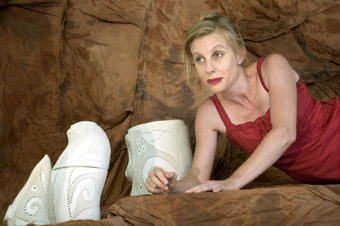
Donna Cameron, The Flowering
photo Suzon Fuks
Donna Cameron, The Flowering
IN THE FLOWERING, WRITER-PERFORMER DONNA CAMERON’S DISTURBING CENTRAL MOTIF CONCERNS RAPE. THE ELABORATION OF THIS THEME DRAWS ON THE GREEK MYTH OF DEMETER AND PERSEPHONE PRESENTED IN TERMS OF A MOTHER-DAUGHTER RELATIONSHIP SET IN CONTEMPORARY BRISBANE. THE GLUE THAT BINDS THIS DRAMATICALLY UNEVEN BUT OVERALL POWERFUL PIECE IS JULIE SHEPHERD’S STUNNING CERAMIC INSTALLATION WITH ITS CONNOTATIONS OF THE FEMALE PROTAGONIST’S SCATTERED FRAGILITY. THE PIECES ULTIMATELY COME TOGETHER AS A MANDALA REPRESENTING BOTH THE RESTORATION OF HER WOUNDED PSYCHE AND THE FLOWERING OF HER FEMININE POWER.
Eighteen year old Chloe disappears for a year and, seemingly traumatised, on her return refuses to tell her distraught mother what has transpired in the interval. Her mother descends into a morose state, claiming Chloe is no longer her daughter because “the light has gone from her eyes.” A chronic alcoholic, she succumbs to watching classic Hollywood re-runs on television. The daughter, pursuing an artistic career, continues to visit annually to witness the the garden that flourishes under her mother’s egregious green thumb. One year Chloe fails to make an appearance and when she finally returns, the garden is devastated. She holds an exhibition to which she invites her mother who pointedly refuses to attend. Mother ultimately dies of alcoholic poisoning, and her daughter is driven to confront the unexpressed truth about her absence.
Donna Cameron, the hardworking solo performer, energetically and sometimes gleefully embodies the significant characters in Chloe’s tale although the adult Chloe’s inner journey is never adequately explicated. The most successful of these impersonations for me was the mother chewing the cud of her own bitterness, a ravished voluptuary who had played musical chairs with a succession of lovers, now dethroned by the symbolic elevation of her daughter to queen of the underworld. But is this Chloe’s projection, a question that avers to all the characters impinging on the youthful Chloe’s loss of innocence, or rather the ignorance of youth that comes on as innocence?
There is the Dis figure that Chloe meets at a ceramic exhibition and willingly joins on a subterranean journey through a series of tunnels and sewers to finally emerge in a dank squat. But this dark lord of the underworld, apparently so sophisticated, is revealed as a small-time drug dealer in another kind of underworld who is wanted by the police and hails, like his friend Blister, from Beenleigh. His accent and exotic background have been assumed to hide an unconfident stammer and to get girls. Likewise Blister is portrayed with a chronic nervous laugh. Far from ravishers, these two are also innocents abroad, clumsily responding to Chloe’s overdue desire to be initiated into the mysteries of sex and drugs. When their mundane rather than picaresque journey takes them to India, Chloe and Sissy, a class ally of the boys who is depicted as tastelessly wearing a top too small for her unfettered voluptuousness, are set up as drug mules by these two incompetants. Thankfully, the sympathetic Blister provides money for Chloe’s escape route home, fulfilling his function as Hermes, friendliest of gods to men, who escorts Persephone from the underworld.
At this point the hapless bogans fall out of the symbolic order of the play; gone too is the young infatuated Chloe and so is the comedy created at their expense. The source of middle class Chloe’s trauma is revealed elsewhere. The Flowering is dedicated to the circus girls Cameron had seen in India: “torn from your mothers far too young and living in hell.” Representing the understandable feelings of the author, Chloe attempts to rescue a child who has obviously been molested, but fails significantly when she tries to flee with her through another underworld tunnel. The trope is Chloe’s failure to rescue herself from her identifying role with her mother (as Persephone is classically identified with Demeter). Only after her mother’s death is Chloe free to release the repressed memory of her mother taking on the physical abuse intended for her as a child, revealing her love, and enabling Chloe to distinguish between the ‘good’ and ‘bad’ mother so that in the triumphal closing mise-en-scene she can see as well as finally be seen.
The Flowering, writer, performer Donna Cameron, director, dramaturg Sue Rider, ceramic artist Julie Shepherd, lighting designer Geoff Squires; The Judith Wright Centre of Contemporary Arts, Brisbane, Feb 9-13
RealTime issue #96 April-May 2010 pg. 34
© Douglas Leonard; for permission to reproduce apply to realtime@realtimearts.net
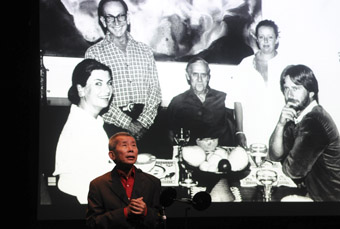
William Yang, My Generation
photo Heidrun Löhr
William Yang, My Generation
SOLO SHOWS BY WILLIAM YANG, ROSIE DENNIS, ALEXANDRA HARRISON AND MARTIN DEL AMO IN PERFORMANCE SPACE’S FIRST 2010 SEASON AND, SOON AFTER JOHN WATERS AND MIAOW MIAOW (SEE RT97) AT THE SYDNEY OPERA HOUSE, STIMULATED MY CASUAL THINKING ABOUT PRESENCE AND CHARISMA AND HOW TO DEFINE THE ENDURING APPEAL AND CRAFT OF PARTICULAR PERFORMERS—ESPECIALLY THOSE WHO ARE NOT ACTORS AND WHO ADDRESS US DIRECTLY, APPEARING TO BE PERFORMING THEIR OWN LIVES.
william yang
I’ve been watching William Yang’s performative slide shows since 1987. Now and then, one of them, like his latest, My Generation, leaps out as very special. This is partly because of its epic sweep, from the 70s—when Yang finds a place in the theatre firmament with Rex Cramphorn, Robyn Nevin, Jim Sharman, Kate Fitzpatrick)—through the 80s and 90s extending the photographer’s world to include the visual arts (Brett Whitely, Martin Sharpe), fashion (Jenny Kee, Linda Jackson, Flamingo Park) and the richly creative gay culture that overlapped and entwined with these through the likes of Peter Tully. And then there’s Patrick White, a daunting presence in My Generation but at his most apparently vulnerable in Yang’s exquisite portraits. And Tiny Tim. Over such a long period we witness artists and friends grow old or die, careers falter and friendships fail. Although Yang’s tone is light and, as ever, slightly detached if measuredly frank, the sense of mortality in tandem with hard-won survival is pervasive.
Yang’s performance persona across two decades has been remarkably stable. His confidence as a performer has certainly grown, but the basic ingredients, a coolish if affable, slow delivery, short carefully constructed sentences and physical fixity before a microphone all persist. The persona suggests someone who is possibly shy and requires a stable performative format—the rhythm of the slides might change but the spoken delivery varies little. Yang mentions in this performance that someone once described his photography as “not quite candid, a little bit formal.” It applies equally to his performance. Yes, the photographic work is candid, lined flesh and sweat are brightly lit everywhere, and there are the occasional surprises (a litter of post-party, naked bodies), but there are limits—Yang tells us about the photographs that got him into trouble (he is no paparazzi, the people he shoots are often his friends and this kind of work can put friendship at risk) if remaining unclear about how often he seeks permission to exhibit his images. His stage performance is likewise candid, but carefully constructed: like a novelist foreshadowing an incident, Yang will show a photograph, mention that he saw something in its subject that concerned him or was predictive, and quickly leave it. It’s a jolt, but inevitably he will come back to that person. Sometimes Yang’s comments seem unfair because you simply do not have enough information from him to understand what happened, and why, to a friend’s child who barely figures in the narrative—the thread in the weave is sometimes too thin. My Generation is also awash with personalities less well known, if at all, to newer generations, but remains valuable history if requiring clarification here and there.
My Generation is culturally rich with a strong sense of not just people but homes and events (for example, he says, when Mardi Gras used to be a cultural festival), meals shared, collaborations, openings and parties. A sense of privilege and furtiveness co-exist in the pleasure felt at seeing inside the homes of Patrick White and Margaret Fink and empathising with those who lose theirs. When Yang finds a home for himself and decides to live alone, he says it’s the closest to freedom he’s come. If candid about himself in previous works, perhaps Yang goes further in My Generation. As he and we watch other people’s children die or mature on the screen, Yang declares, “The pictures are like my children; they will tell my story when I am gone.” The William Yang performance persona hasn’t changed in any essential way over 20 years, but with each work we learn more about the man and his world. It’s rumoured that his body of work is destined for DVD, a welcome documentation of a life-in-progress, its milieu and the cultural life of Sydney, if likely viewed with the unease that perversely makes Yang’s work popular—that play between formal and candid, which one audience member described to me as passive-aggressive. Of course that might fit any number of people who use the camera as a tool for social engagement. [Sandy Edwards’ appreciation of My Generation is well worth reading at www.arthere.com.au/whatson/?p=92. Eds]
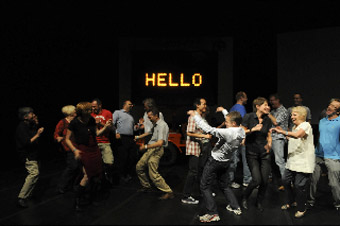
Rosie Dennis, DOWNTOWN
photo Heidrun Löhr
Rosie Dennis, DOWNTOWN
rosie dennis
My earliest memory of Rosie Dennis was of a barely audible voice emerging close by from the shadows in the old Performance Space as Eleanor Brickhill danced among us. These oddly complementary performances were, well, strangely primal, hard to nail down, even in those heady days of wilful opacity and theory-driven performance. Dennis’ amplified voice was distinctive—quiet but urgent, interrupted but oddly coherent, the words almost refusing to be given up. This seemed something more than performance poetry. When I later saw Dennis perform on her own, the surprise was even greater: the work was short, intense, un-miked, close-up, almost scary and sometimes funny as words and movement patterns locked into spasmodic loops, as if the performer was trapped in a moment of emotional recall from which there was no escape. The seemingly obsessive-compulsive drive yielded a memorable poetry and rough-hewn dancerliness that evoked a persona struggling to tell us something important if only the words would flow and voice and body come together.
These days, Dennis’ performances are more formal occasions—framed as a lecture or report, deploying props to illustrate the events in her anecdotalising or ideas in her scientific or metaphysical speculations. These loop back wryly into her stories with a Paul Auster-ish sense of the synchronistic interconnectedness of the cosmos. Perhaps she’ll dance, but wordlessly and privately. Perhaps she’ll sing, but with Sydney’s Gay and Lesbian Choir at the end of her latest performance, Downtown. The difference between early and current Dennis appears great—once I was alarmed by a ‘condition’ that shook up the notion of art, now I’m charmed by a presence that takes its all too willing audience (there’s a legion of fans) firmly in hand as confidante.
For Downtown, Dennis set herself the task of “walking and talking with strangers [in] inner suburbs of Sydney” and during a week-long residency at Performance Space reported daily on the construction of her performance which was then delivered complete on a Friday evening as “part process/part product.” Although the 44 people she approached (only three rejections) play a curiously small role in the performance, a funny email exchange with Yoko Ono looms large suggesting a personal ‘chemistry’ which is literalised in an onstage chemical experiment demonstrating “what we can do when we work together.” Downtown is a whimsical, even sentimental, work-in-progress from an artist who surprises us nowadays with subtleties and metaphysical turns but still fixes us as one with a searching eye and vocal rhythms that, although now comforting, still incline to the pulse of poetry, especially when Dennis is not striving to be poetic. While some performance personae stay pretty well fixed, others, like Dennis’, fascinatingly mutate and grow older, and stranger, with us.
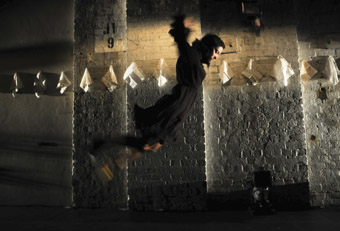
Alexandra Harrison, Dark, Not Too Dark
photo Heidrun Löhr
Alexandra Harrison, Dark, Not Too Dark
alexandra harrison
In whatever work she appears, dancer and physical theatre performer Alexandra Harrison exudes a powerful presence. Here I’m seeing her for the first time as a solo performer, in a long dance work of her own making, Dark, Not Too Dark. In a RealTime-Performance Space Forum she described the work as “abstract”, the motivation for it explained in part in her program note where she writes, “My great grandfather wrote to Concetta, his Aeolian island bride, asking her to send him a photo. And when she did he took the picture of her by an empty chair…to a photographer and created another image, placing himself in the chair…her hand on his shoulder.” Another note defines remanence as “the residual magnetism left behind when the magnetising body no longer remains.” In Dark, Not Too Dark, Harrison appears to have absorbed the magnetism of her grandmother, resulting in a gothic channelling, unleashing pent-up gestures and dance movements.
As a voiceover intones the word “forever” over a growing hum and percussive glitching in Bob Scott’s musical score, Harrison, close to her audience, holds out her arms, palms down, sustaining the pose at great length until she begins to vibrate, the music deepening. She is entering another state of being. At last she lowers her arms, looks up and, in a series of moves, leans back, places a hand on her brow, and angles her whole body. The shape of it evokes a heroine locked in anguish in a 19th century melodrama or silent movie. The image of this transformation will recur across the work’s duration. In one of its most engaging passages, Harrison approaches an old gramophone horn which emits a strumming to which she responds with a burst of 20s-style dancing, raising her knees high, as if pulled in and out of the music and into the past as it grows louder. At times she looks like a novitiate, at times a mature woman or a creature caught in a tracking follow spot or endangered by a chandelier—she takes it away, smashes it, a new one, or the same one, descends. The word “forever” returns. As does Concetta, appearing eerily on the photographic studio backdrop.
Dark, Not Too Dark largely defies literal interpretation. The low light, repeated movements and strange images induce a kind of gothic delirium—a la Edward Gorey if without the laughs—but Harrison is, as always, fascinating to watch, driven, possessed, as if working through a very private madness, such is the work’s intensity, but to what end? A dark, but not too dark resurrection of the spirit of a forbear, an experiment that is both frightening and liberating? I’d like to experience the work again, a more economical version and with the sound score restrained (it’s emotionally over-inflated despite its many virtues). In Dark, Not Too Dark at its best, Alexandra Harrison envelops us in her vision creating an ambiguous persona, part grandmother, part herself.
My Generation, words, visuals William Yang, musician Daniel Holdworth, producer Performing Lines, Performance Space, Feb 23-March 6; Downtown, writer-performer Rosie Dennis, assistant Jacob Patterson, Sydney Gay & Lesbian Choir, Performance Space, March 5; Dark, Not Too Dark, creator-performer Alexandra Harrison, sound Bob Scott, design consultant Kate Davis, lighting Richard Manner, dramaturg Benedict Anderson; Performance Space, CarriageWorks, Feb 17-20
See Keith Gallasch’s critical appreciation of Tom Holloway’s new play Love Me Tender at Belvoir St.
RealTime issue #96 April-May 2010 pg. 36
© Keith Gallasch; for permission to reproduce apply to realtime@realtimearts.net
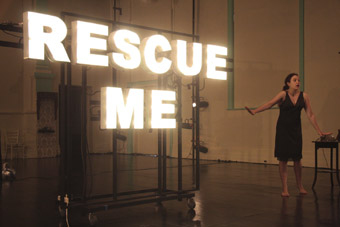
Nicola Gunn, At the Sans Hotel
photo Daisy Noyes
Nicola Gunn, At the Sans Hotel
ONE OF THE PHRASES THAT ALL TOO OFTEN OCCASIONS ME TO SLUMP-SHOULDERED DISAPPOINTMENT IS ANYTHING CALLING FOR A “NEED FOR MORE DIALOGUE.” NOT THAT DIALOGUE PER SE IS A BAD THING—I’D BE A PRETTY BLINKERED THEATREGOER IF THAT WAS MY STANCE. BUT WHEN IT COMES TO DISCUSSIONS WITHIN THE ARTS COMMUNITY, THE “NEED FOR MORE DIALOGUE” IS UP THERE WITH THE “NEED FOR MORE EDUCATION” AND “AGREEING TO DISAGREE.” IT’S A STATEMENT THAT, IN APPEARING TO COMMENCE A CONVERSATION, MORE FREQUENTLY ENDS ONE. WE NEED TO TALK MORE; LET’S END OUR TALK AT THAT.
What happens when a work of performance presents its own internal dialogue? Does it end in the same silence, shutting out its audience by subsuming their role as interlocuter into the work itself? A range of recent productions in Melbourne raised this very question, offering scenarios which weren’t simply open to interpretation but invited conflicting, even incommensurable readings.
at the sans hotel
The self-interrogation of Nicola Gunn’s At the Sans Hotel began the moment it registered in a potential audience member’s consciousness, though this wasn’t made explicit until the performance itself began. Advance publicity was strewn with enigmatic images of a half-visible Gunn disguised as a noir femme fatale or a monkey bellhop; textual fragments mentioned a woman trapped in a bathtub or lost in a desert.
What we got was something quite other. A woman with a slightly hokey French accent greets her audience and hands out an invisible questionnaire, inviting us to complete a survey on our experience of the (non-)show so far. Okay, we’re playing pretend. Then we’re given real pencils to use in the process. Is this some kind of joke?
The French woman eventually apologises that Nicola Gunn’s At the Sans Hotel won’t be on offer tonight. She instead takes us on an hilarious, sometimes desperate series of digressions in which she discusses the show that should have taken place and the narrative problems it presented. A chalkboard breakdown of structure, themes, metaphors and sources recreates the absent play, and frequent audience involvement is less threatening than engaging. Gunn—and I was never even sure if this was Gunn we were watching—is a brilliantly likeable performer who effortlessly wins over her onlookers within minutes.
It’s this charm that makes At the Sans Hotel such a success. Like UK company Hoipolloi’s exquisite Floating of last year, and with hints of Forced Entertainment’s more accessible work, this is a gift to its audience rather than a challenge. It’s not a navel-gazing exercise into meta-theatre but a bracing, bewitching investigation into presence and absence. Its real subject, which we approach in a curious crabwalk, is the identity unable to step outside of or contain itself. The open nature of the piece is a structural component of this: referring to Gunn’s earlier works, directly engaging the audience, and the whole artifice of that advance media blitz are figurations of the subject that cannot remain for itself a stable and coherent self. That Gunn was inspired by the case of Cornelia Rau, the schizophrenic German citizen and Australian permanent resident, whose identity breakdown made headlines in 2004, helps explain the motivation behind the work’s unique structure, but there is so much more for each viewer to discover for themselves.
the fate of franklin
Just as generous, though with a rougher polish, was Four Larks Theatre’s The Fate of Franklin and his Gallant Crew. Inspired by an ill-fated attempt to discover the fabled Northwest Passage in the 1840s, its junkyard aesthetic was a visual delight of antiquated seafaring miscellany and lush costuming (not to mention a huge band sawing away on old-timey instruments). But all of this quickly began to feel like empty nostalgia, not for its ostensible historical base but for the exciting narratives of exploration and disaster that filled many a pulp novel and popular rag of the era. Was this just an excuse to play dress-ups and spout period-sounding jargon?
As it turns out, no. My vague disquiet was eventually turned on its head as various characters began to wrest control of the narrative from each other, presenting conflicting versions of the voyage’s outcome. Each proved to have a vested interest in our interpretation of events, and this tussle put to its audience an implicit question: whom do you trust? And, more importantly, why? Is the more thrilling story (brave explorers descending into cannibal savagery) simply more interesting than the possibility that a bunch of men starved or froze to death in an anonymous landscape?
lady grey
US playwright Will Eno is known for his more brutal affronts to his audience. His Thom Pain (based on nothing) is a tour-de-force solo that works up a mystery of childhood trauma by enacting an angry performance of verbal assault on spectators. His lesser-known Lady Grey is a similarly obtuse affair that turns that violence inwards. The eponymous figure is in fact several identities occupying the same mental and physical space—dressed in an historical ballgown, Lady Grey is resolutely contemporary. She tells stories of a girl who may be her younger self, or addresses the audience directly but in a prepared fashion. Seeming spontaneity is revealed as simply another theatrical convention—we’re seeing a character playing a real performer playing a character. It’s a hugely difficult piece, as much concerned with its own inadequacies as At the Sans Hotel or The Fate of Franklin. But like those works, this anxious internal equivocating doesn’t come at the expense of understanding, but in its service.
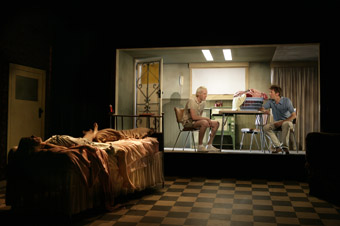
Furious Mattress, Malthouse Theatre
photo Jeff Busby
Furious Mattress, Malthouse Theatre
furious mattress
And then there’s what may turn out to be the most baffling, bizarre production of 2010. Malthouse Theatre’s Furious Mattress left audiences reeling, uncertain whether they’d witnessed a work of genius or a complete creative car wreck. Its credentials were unimpeachable—scripted by Melissa Reeves, directed by Tim Maddock, and featuring a varied but uniformly accomplished cast. The work was spun from a notorious Victorian case in which a schizophrenic middle-aged woman was killed during a lengthy, tortuous ‘exorcism’ in a rural district. Faith, fear, ignorance and the sundry madnesses of the individual and the crowd suggested themselves as possible concerns here, but as the piece unfolded it flung possibilities far more horrifying in its audience’s faces.
The first half was, for the most part, a grinding portrait of fundamentalists unable to confront the murder they had just committed. Banal rituals of domesticity and small talk were interrupted by unsettling evocations of belief in the supernatural. The point seemed blindingly obvious: religious devotion taken to its extremes had led to a fatal outcome, and these inhabitants of a lunatic fringe were both monsters and victims of their own delusions.
Once the plot shifted to the days leading up to the killing, however, the production shifted gears like a trucker topping a mountain rise. The delusions suddenly became reality, as muted performances gave way to hysteria and histrionics and a general atmosphere of realism was upended by carnivalesque comedy. A giant pantomime rat, an exorcist straight out of Kath & Kim and the ultimate arrival of the animated mattress—more wacky than furious—provoked laughter where we might have expected chills. Serious, even earnest dialogue was met with comically delivered ripostes; at times, it felt as if four or five productions had been mashed together without explanation.
The lack of internal logic displayed by Furious Mattress provided one of those rare moments in which the old intentional fallacy was less a philosophical argument than an unquestionable fact. There was no seeking recourse in program notes to define what this production was ‘supposed’ to be, since they only confused matters more. What we were left with was less a dialogue between the work’s contrasting elements than an irresolvable battle between those same aspects. This wasn’t the dialectic process of self-reflexive theatre, in which the apparent clash of elements results in richer, hybrid new formations—it was a fight where none could escape unscathed, least of all the audience. Dangerous stuff. I’d see it again.
At the Sans Hotel, created and performed by Nicola Gunn, design Nicola Gunn, Gwendolyna Holmberg-Gilchrist, Rebecca Etchell, sound Luke Paulding; Theatre Works, St Kilda, Mar 16-27; Four Larks Theatre, The Fate of Franklin and his Gallant Crew, text Marcel Dorney and Four Larks Theatre, direction Jesse Rasmussen, Mat Sweeney, Sebastian Peters-Lazaro, performers Justine Campbell, Shane Mills, Caitlin Valentine, Marcel Dorney, Zak Ateka, Bonnie Taylor, Max Baumgarden, Hugo Farrant, Paul Goddard, Reuben Liversidge, Fingal Oakenleaf, Ivan Smith, Genevieve Fry, Esala Liyonage, Greg Craske, Kristian Rasmussen, Sebastian Peters-Lazaro, Jesse Rasmussen, Mat Sweeney, design Ellen Strasser, Sebastian Peters-Lazaro, lighting Geordie Barker, Secret location, Northcote, Mar 12-27; Melbourne Theatre Company, Lady Grey, writer Will Eno, director Julian Meyrick, performer Tanya Burne, lighting Casey Norton, Lawler Studio, MTC, Feb 19-30; Malthouse Theatre, Furious Mattress, writer Melissa Reeves, director Tim Maddock, performers Rita Kalnejais, Kate Kendall, Robert Menzies, Thomas Wright, design Anna Cordingley, lighting Paul Jackson, sound & music Jethro Woodward, Beckett Theatre, Malthouse, Feb 19-Mar 13
RealTime issue #96 April-May 2010 pg. 38
© John Bailey; for permission to reproduce apply to realtime@realtimearts.net
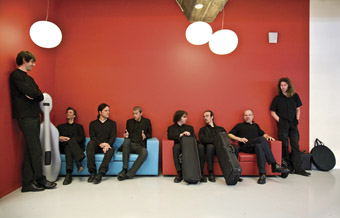
Spectra ensemble
courtesy ISCM
Spectra ensemble
THE BIGGEST NEW MUSIC EVENT EVER IN AUSTRALIA WILL SPREAD ITS EUTERPEAN TENTACLES AROUND SYDNEY FROM APRIL 30 TO MAY 9. THE 23 CONCERTS FEATURING AT LEAST 82 NEW (OR NEWISH) WORKS PLAYING IN VENUES FROM THE VERBRUGGHEN HALL AND ACROSS WESTERN SYDNEY TO ST FINBAR’S CHURCH, GLENBROOK IN THE LOWER BLUE MOUNTAINS, MAKE UP THIS YEAR’S AURORA FESTIVAL COMBINED WITH THE FIRST EVER VISITATION TO THE SOUTHERN HEMISPHERE BY THE INTERNATIONAL SOCIETY OF CONTEMPORARY MUSIC (ISCM).
This important organisation has been promoting new music, mainly European, since 1922; in 1938, for instance, they put on a concert in London of world premieres consisting of Bartok’s Concerto for Two Pianos, Percussion and Celesta, Britten’s Variations on a Theme of Frank Bridge and Peggy Glanville-Hicks’ Choral Suite! It’s only ever managed to get to America once and that was during the Second World War, though Asia has entered its purview—playing Hong Kong and Yokohama in recent years.
Indeed, the 2010 event was to be in Poland until they recalled that the year might be taken up rather heavily in celebrations of Chopin anniversaries. That left just 18 months for Australia—specifically composer and all-round musical activist, Matthew Hindson—to pull the fat out of the fire. “Matthew’s ears lit up when I first broached the possibility,” recalled John Davis, CEO of the Australian Music Centre and a board member of ISCM since 2002. “‘What an opportunity,’ he enthused, ‘to hold the world’s most prestigious international contemporary music festival’.” Appropriately Davis is now President of the ISCM, chairing meetings that take place during the New Music Days.
Davis had been wanting to host the event in Australia since the late 90s—“and people had been eager to come—even though they recognise that the cultural infrastructure in the Southern Hemisphere just can’t compete with a Donaueschingen or a Gaudeamus Festival. But I could never think of a way of affording it—we have to pay performers, obviously, and host all the delegates and visiting composers; that could be a hundred people. Would they camp on Cockatoo Island? I don’t think so. Fortunately, Hong Kong broke the mould a bit in 2007, cutting back on the size of the whole thing; and then Australia Council International recognised that this wasn’t just a lot of new music but a great way of promoting Australian culture to the world. Plenty of international festival directors (and the President of Croatia, who’s an ISCM delegate) will be here; our performers will be well showcased.”
Performers are headed by Sydney’s Ensemble Offspring—who tackle an amazing three concerts in four days with almost all new scores. “Oh my god, what are we doing?,” says EO’s Damien Ricketson recalling his realisation that the ensemble were about to do a year’s worth of repertoire in one fell swoop. Ricketson, and the directors of other groups such as ABC Classic FM for radiophonic works, the Song Company, Topology, Chronology Arts, the New Zealand Trio and the Goldner Quartet—there’s no Sydney Symphony Orchestra thanks to the short planning period, but the SSO Fellows offer a string band—shared in the selection of their programs with Matthew Hindson from 700 entries world-wide.
“There was a lot of fairly ordinary stuff,” recalls Ricketson, “and somehow it had got through 52 national sections to arrive here. But I’m not embarrassed by anything we’re playing—and I lost a good Thai piece to the New Zealand Trio. Certainly the Australian composers—Matthew tried to get at least one into every concert—will stand up well to the glare of international competition.”
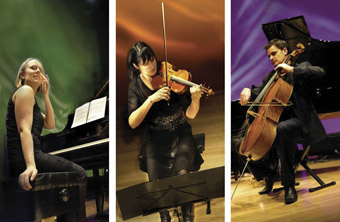
New Zealand Trio
courtesy ISCM
New Zealand Trio
The New Zealanders were a piece of proactivity—lots of composers (including the veteran US-based Annea Lockwood of ‘Piano Burning’ fame) as well as the Trio. John Davis explained that New Zealand had dropped out of the ISCM in recent years and, politically, he was therefore keen to welcome them back with a vengeance; also the Trio was a group with 80 new music commissions under its belt, fully deserving its presence. He’s also inveigled the elite Spectra Ensemble from Belgium to bring music by Bart Van Hecke, Jean-Luc Fafchamps and Bruno Mantovani, a product of a European system which shares the best repertoire around a network of top ensembles. “It was a coup to get them here,” said Davis, “and their sponsorship by the Flanders government and Campbelltown Arts Centre is just fantastic.”
Campbelltown may not be prominently displayed on your mental map of new music in Sydney. But that’s not for want of the centre’s recent efforts. For a start, the ubiquitous Hindson is its music coordinator. Now they say, give the job to a busy man. So it was inevitable to turn to the man who heads the Sydney Conservatorium’s Arts Music Unit, is Chair of the Australia Council’s Music Board (appointed after the ISCM funding had already been granted, he wants to point out), as well as founding the biennial Aurora Festival. Sometimes, he writes music too—which gets commissioned and performed by the likes of the London Philharmonic Orchestra, the Birmingham Royal Ballet and Canadian virtuoso violinist, Lara St John. His composition for ballet, e=mc2, won a South Bank Award for best dance music in the UK in 2009; the first movement, Energy, will be performed by the SSO conducted by Vladimir Ashkenazy on September 2 this year.
Sadly, of course, Hindson has no music in the ISCM New Music Days. But at least 30 other Australian composers do—some familiar, like Ross Edwards, Carl Vine, Peter Sculthorpe, Lisa Lim and Elena Kats-Chernin; others pretty unknown—Katia Beaugeais, Peter McNamara and Daniel Blinkhorn have so far escaped my notice.
There are probably fewer big names from overseas. Elliott Carter and Philip Glass from the US, Rautavaara and Part from the Baltic, Golijov from Argentina are just about it. So we’re going to have to rely on some new names to provide those Britten and Bartok moments. Actually, this is less likely than in previous New Music Days. For the ISCM is in transition. There was a time when a European event would select just the best 12 works submitted from all over the world. But in 2008 they decided that the future lay in the event being more of a showcase for members. This becomes mandatory in 2011, but Matthew Hindson decided to do his best to find music from all member countries as a test of the new system. He managed 38.
“And it wasn’t that hard”, he insisted, “there’s a plethora of young and hungry composers out there, you know.” It’s just possible that knowing who would be struggling through their 700 entries to make the selection could have encouraged composers to “match their choice of music to the buyer,” as John Davis tactfully put it. In other words, Hindson clones may have enjoyed a marginal advantage! Hindson himself is positive: “It was really a pleasant surprise to find that you couldn’t identify the music by the nationality of the composer…South Africans—rhythmic and bright; Greeks—aggressive and noisy! The borders are definitely breaking down. And because this is primarily a chamber music event, I expect the flavour to be intimacy. Maybe it’ll show that the orchestra isn’t the music performance form of the future? Hopefully it will encourage the smaller ISCM sections to take up the baton in that future.”
2010 ISCM New Music Days & Aurora Festival, presenting partners: Sydney Conservatorium of Music, Aurora New Music, ABC Classic FM, Australian Music Centre, New Music Network, Campbelltown Arts Centre, Joan Sutherland Performing Arts Centre and Blacktown Arts Centre, Sydney, April 30-May 9; http://www.worldnewmusicdays.com.au. Eight concerts will be broadcast live on ABC Classic FM and a new ABC digital ‘classical’ music channel will run throughout the event.
RealTime issue #96 April-May 2010 pg. 39
© Jeremy Eccles; for permission to reproduce apply to realtime@realtimearts.net
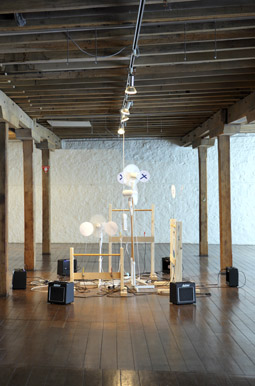
from 3 Songs, 2010, Ross Manning
photo Sean Fennessy; © MONA FOMA 2010
from 3 Songs, 2010, Ross Manning
RATHER THAN INVENTING A THEME FOR THE 2010 MONA FESTIVAL OF ART AND MUSIC, CURATOR BRIAN RITCHIE SEEMS TO HAVE ACCESSED PERFORMERS AND MATERIAL HE THOUGHT MIGHT BE INTERESTING OR FUN, FOR AUDIENCES TO EXPERIENCE PRETTY MUCH AS THEY WISHED. YOU COULD HAVE ATTENDED NOTHING BUT THE MANY EVENTS IN THE PRINCESS WHARF NO.1 SHED, OR AVOIDED THAT SPACE ENTIRELY, AND STILL FELT TOTALLY IMMERSED IN THE FESTIVAL. AND EVEN WHEN MONA FOMA WAS ARCHLY CEREBRAL, IT WAS PLAYFUL.
John Cale’s presence in Australia is not unprecedented, though Hobart is not really somewhere you’d expect to see him, so his near ubiquitous presence on posters, programs and in performances was astonishing enough before we even got to the content. Labeled “Eminent Artist in Residence” for the festival, he came with a five-screen video installation, Dyddiau Du (Cale’s native Welsh for Dark Days), a very talented young band and varying styles of musical performance. Coming directly to Hobart from the Venice Biennale, Dyddiau Du describes a haunted Wales, mixing long meditative shots of empty rooms, ancient and abandoned stone dwellings, intense close-ups of Cale trudging uphill, breathing hard and finally, some kind of water torture. The images bled out over an hour in a darkened room with a concrete floor. It was cold and uncomfortable, which seemed the intention.
A spirit of endurance was also needed for the grueling intensity created by Michael Keiran-Harvey in his astonishing piano work, 48 Fugues for Frank, at the Tasmanian Museum and Art Gallery. Influenced by one of music’s great individualists, Frank Zappa, Keiran-Harvey attacked the piano with the vigour of an athlete. Like the music or not, the commitment to the work and virtuosity on display were undeniable, and at times breathtaking. A group of Hobart artists and curator Leigh Hobba, reacted to Keiran-Harvey’s composition, Zappa and the space itself, creating an exciting and witty four-floor installation. Rob O’Connor’s large, colorful F-for-Frank series lay in the dust of the basement’s earth floor, Aedan Howlett’s swirling street style paintings hung from pillars, Mat Ward (a certified Zappa fanatic) sifted through lyrics and filled the top floor with luridly bright sharks, pygmy ponies and poodles while Michelle Lee stretched a shadow along the floor and up the wall into an image of a pianist’s hands. Harvey raced between floors playing instruments, his performance then relayed to his seated audience by camera.
Site and spatial relations between audience and performance were a feature of the festival more generally, with spaces used in unusual ways throughout. In Abe Sada: Sade Abe 1936, Perth artist Cat Hope generated continent shifting feedback bass noise in a storeroom directly under the Peacock Theatre audience, so one had the odd but not unpleasant sensation of vibration coming through the floor and into the seat. That these sounds were felt rather heard was not new, but the context refreshed the idea. Not content with that exploration, Hope did it again, getting an orchestra of bass instruments, played by a collection of local musicians, to create a vast field of sound in the Princess Wharf through which the audience could wander or lie back in and be bathed in sound.
The Chronox installation by Michael Prior and Lachlan Conn was located in the Sidespace of the Salamanca Arts Centre for the festival’s duration. Cheekily described as a machine for “travelling to the present,” the work obliterates space and time with repetition created from sound and animated projection. An engaging and beautiful work, Chronox invites the audience to interact by altering the looping vinyl records that provide the sound—pick up the tone arm, carefully put it down again. As I succumbed to the hypnotising loops and glowing shapes, the edges of the room appeared to wander off into the dark.
Next door, in the Long Gallery, Brisbane-based artist Ross Manning’s humorous moving sculptures—all fan engines playing drums and driving amplifiers—came alive with a brief, clever performance. Attached to a spinning fan motor, a thin rope whirled along the wooden floor, responding to objects placed in its path—plastic, paper, garbage and metal. It seemed frantic and uncontrolled, but a second viewing revealed a sense of composition and even narrative—from scurrying to fluttering to a bell-like shimmer. This small work remains in the memory.
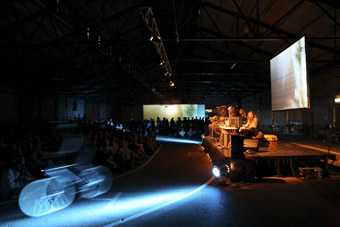
Pursuit, Jon Rose, Robin Fox, Rod Cooper and collaborators
photo Sean Fennessy; © MONA FOMA 2010
Pursuit, Jon Rose, Robin Fox, Rod Cooper and collaborators
Kinetic sound production on a more ambitious scale was the focus of Pursuit, a performance that transformed the Princess Wharf Shed into a singing bicycle track. Jon Rose, Robin Fox, Rod Cooper and Paul Bryant, all seasoned creators of new noise, directed a squadron of bike enthusiasts on a looping chase around the shed while the audience watched from the middle. The bikes had been altered to make sounds and some looked a little crazy, but as they scraped and squeaked and honked about the space, music emerged: this bike and its horn came and went at controlled intervals; new bikes emerged making new sound; one chap rode about with a camera atop his helmet, giving the audience a perspective from within the work. While each sculpted bicycle had its own sound and character, the effect of the whole thing grew, swelling into an ecstatic moment when all the bikes rang their bells, echoing all the other loops and shimmering sounds to be found elsewhere in the festival’s program.
MONA FOMA 2010 was a huge mixed bag of art and ideas. It was totally different from 2009, and there’s no doubt that 2011, when the actual Museum of Old and New Art reveals its contents, will be just as surprising. If there’s anything this festival is about, keeping people guessing would seem to be it.
MONA FOMA, Festival of Music and Art, curator Brian Ritchie, Hobart, Jan 8-24 http://www.mofo.net.au
RealTime issue #96 April-May 2010 pg. 40
© Andrew Harper; for permission to reproduce apply to realtime@realtimearts.net
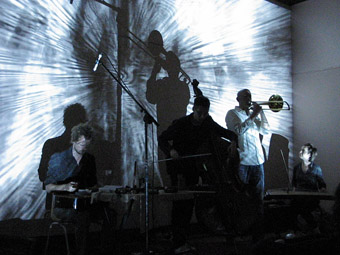
Zeit Kunst 6
photo Sam James
Zeit Kunst 6
OVER THE LAST NINE YEARS THE NOW NOW FESTIVAL HAS CONTINUED TO IMPRESS WITH THE DIVERSITY OF MUSICAL ACTIVITIES THAT IT BOLDLY PROGRAMS UNDER A UNIFYING PREOCCUPATION WITH SPONTANEITY. NOW BASED IN WENTWORTH FALLS IN THE BLUE MOUNTAINS, ATTENDING THE FESTIVAL REQUIRES A LITTLE MORE DEDICATION, THUS I ONLY MADE IT TO THE FINAL AFTERNOON OF ACTIVITIES. THAT SAID THE FIVE PERFORMANCES I EXPERIENCED EACH EXPLORED VASTLY DIFFERENT STYLES, ACTING AS THE PERFECT TASTER FOR THE RANGE OF APPROACHES TO MUSIC MAKING FOR WHICH THE FESTIVAL HAS BECOME RENOWNED.
Opening the afternoon was Neill Duncan (sax), Alex Masso (percussion, drums), Sam Pettigrew (double bass), Sam Dobson (double bass) and Alister Spence (piano), producing the now well-recognised improv style in which individuals explore extended instrumental techniques and slowly work themselves into a cohesive composition. The background of this group, however, offers a few more free jazz and blues stylings than is often found in this scene. Starting with quiet scratchings, melodic fragments emerge and submerge. Spence has prepared his piano so it alternately sounds like bells and banjos. While Pettigrew provides the occasional swampy walking bass line to ground them, he also explores extra-musical sounds, inserting a zither behind the strings for extra jingle. Similarly Dobson, applies his keys (almost an improv cliché, but nonetheless interesting) to his strings for a bit of jangle. The others seem in their own reveries, but Masso watches them all hungrily, providing shake-up bass drum thwamps, cymbal clash and other angular provocations. Neill Duncan is always a pleasure to watch as he explores the subtler sounds of his traditional washboard vest, as well as providing some of the smokier blues figures on saxophone.
Around 20 minutes in, during a denouement, a little girl’s voice is heard in the audience: “Is it finished?” Her intuition is spot on: it is time, and there is an ending presenting itself, but the group doesn’t take it. Initially annoyed by this tendency of improv musicians, over the years I’ve come to enjoy the results of the missed moment—the hard soul searching involved in justifying continuance and maintaining the energy. This ensemble does well crafting a satisfying epilogue and finding the ‘real’ ending perfectly together.
Zeit Kunst 6 was set up in the smaller side room which is more projection friendly in the afternoon light. The line-up for the ensemble changed slightly during its Goethe Institut sponsored tour around Australia, but for this performance featured Michel Doneda (sax), Kim Myhr (guitar, objects) Matthias Muche (trombone), Clayton Thomas (double bass), Sven Hahne (computer), Clare Cooper (guzheng). It begins with an extended silence, until Thomas sets his bass rattling with his signature SA number plate inserted in the strings, then Cooper bows her guzheng and the wind players’ breath burbles through their instruments. A sudden stab of sound activates the audio responsive video and an array of lines and angles flash across the back wall and the performers. Maintaining a sense of the collectively unknown outcome, each of the performers is incredibly controlled, almost monk-like. At one point, around three-quarters of the way through, they all stop—the light from the video ceases—and they hold…. hold…. hold… hold…only to wind up again for the final intense movement.
In this ensemble it seems that the strings create the under-layer of drone and scumble while the wind players shape the piece into breath-driven phrases. While it might be thought that a lot of improv downplays melody and harmonics in favour of texture and timbre, here you get the sense each musician is deliberately making uneasy harmonic choices though clearly in relationship to each other. Michel Doneda seems the most playful, swooping his sax through the air to create both energetic sonic and physical gestures. Cooper seems the most interested in the cause-and-effect of the sounds on the stark yet dynamic video—actively playing with the it. The samples offered by Hahne on computer, with their squared off digital edges, sit uneasily in the mix, but somehow this makes the combination all the more interesting. The piece concludes with another sustained silence, painful and beautiful in its intensity.
nHOMEaS comprising Josh Isaac (drums), David Sullivan (bass, fx loop), Jack Dibben (guitar), George Nagal (synthesiser) and Aemon Webb (vox, electro gadgets) offers the noise/rock end of the spectrum but is no less considered. This is a dense exploration driven by the emphatic energy of rock drums. Each player is seeking his own epiphany, with elements occasionally joining forces, like Sullivan and Issac creating cohesive rhythm sections, or Nagal on warped synth and Webb on electronic whinnies and vocal wails flinging us into reverby outerspace. Collectively they forge mountains of sound, then let them decay and the result is dark and cathartic.
Billed as Joey and the Calypsoes (mystery band), a nice little interlude was provided by Splinter Orchestra members who teamed up with audience members and called their mobile phones. By moving the speakers of the answered phones close to each other the feedback zings and chirps created a peaceful, contemplative chorus of digital insects. A lovely lo-fi interactive moment and a nice irony given mobile phones are often the bane of music concerts.
The performance that wrapped up the festival was Team Music!—interactive netball, facilitated by Jon Rose, with the local under 16s netball teams. In a tiny makeshift court the width of the hall, the two eager teams fight it out using Rose’s modified soccer ball (he couldn’t get the workings into a netball) which activates a vast range of sound phrases. Rose’s ongoing explorations into interactive music, including riding bicycles and flying kites, continue to impress in their democratising of electronic music making. However, the bleepy alogorithmic computer burbles triggered by the ball are less engaging than the lightning fast adaptability of the live duos—of Clayton Thomas (double bass) and Mattias Muche (trombone) on the side of the white team, and Eivind Lonning (trumpet) and Mike Majkowski (double bass) on the side of the blue team—who are only allowed to play when their team is in possession of the ball. The teams played a full 45-minute game which certainly offered reasonable time to explore possibilities, accompanied by playful mayhem including signs that encouraged audience responses: Stomp, Boo, Cheer etc. It was a fittingly energetic and playful way to end the NOW now festival which continues to explore spontaneous music with a nourishing balance of deep seriousness and childlike joy.
The NOW Now festival, Wentworth Falls School of Arts, Blue Mountains, Jan 22-24; http://thenownow.net
RealTime issue #96 April-May 2010 pg. 39
© Gail Priest; for permission to reproduce apply to realtime@realtimearts.net
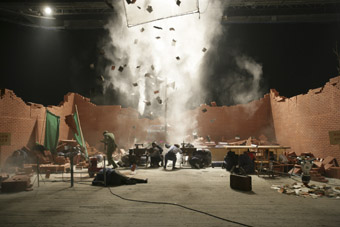
Hostage, video still 2008, Wang Jianwei, single channel video, Edge of Elsewhere
image courtesy the artist
Hostage, video still 2008, Wang Jianwei, single channel video, Edge of Elsewhere
“THE POLITICS I REFER TO HAS NOTHING TO DO WITH POWER, CONFLICTS OR EVEN CONSPIRACY. MY POLITICS IS ABOUT GREATER HUMAN INTER-RELATIONS. AND THIS POLITICS FRUSTRATES ALL ADEQUACIES. AS LACAN SAID, “ERROR IS THE HABITUAL INCARNATION OF TRUTH” AND THAT TRUTH “EMERGES IN ITS MOST CLEAR-CUT REPRESENTATION, THE MISTAKE.” Wang Jianwei
A giant, uncanny, industrial apparatus occupies the central gallery of Campbelltown Art Centre. This is part of Wang Jianwei’s multimedia work titled Hostage (2008) exhibited as part of Edge of Elsewhere (a three-year partnership between Sydney Festival, Campbelltown Arts Centre and Gallery 4A to engage communities in Western Sydney with artists from Asia and The Pactific, Eds). The machinery seems overloaded with engines, valves, piezometers and obtruding steel pipes and it’s almost inundated by plastic foam. One feels haunted and trapped by this object of mythic proportions as if it is blundering through the gallery. I sigh with relief at the sight of a series of bright, framed photographs on the wall to one side: a worker, a farmer and a soldier. These lead the way to a darkened room where a more ambiguous film is screening as part of the same work. Again, my breath halts.
Obeying some invisible discipline, deadened looking people work and rest within a cabined space bound by three brick walls. They live in the era before Chinese economic reform, deprived of their individuality by heavy state ideology. We can only recognise their social functions: worker, farmer and soldier. Repeatedly carrying out their daily routines, they wake at the same time, do collective morning exercise and then work on their respective official duties: technical workers weld; farmers spray pesticides; soldiers keep their posts. Everything proceeds with the utmost propriety—everyone strives to achieve the same objective.
This system runs effectively and with total poise—an early warning that a storm is about to break. The walls are bombed by outsiders and collapse, the perfect order within this space is buried under debris. The system fails and crumbles. The film ends ambiguously with the people squeezed into a white van like sardines and driven away, into the unknown. The film is a metaphor for a system that either totally transforms or collapses when it reaches its maximum entropy. Calmly and sensitively unfolding his narrative, Wang Jianwei cinematically constructs a materially concrete scenario but one which asks unanswerable questions.
Using installation, photography and video art, the artist creates an undivided whole that probes the dilemma of humans seized like hostages by systems of power such as knowledge, history or ideology. Like Kafka’s Josef K, arrested by some unrevealed authority for an unidentified crime, these giant and invisible systems of power impose an imaginary identity which, without any alternative on offer, is accepted.
Born in the 1950s, Wang Jianwei shares the experience of many of his contemporaries—relocated to the country and drafted as a soldier. At the end of the Cultural Revolution, stifled by seven years spent drawing maps for the army, Wang commenced his career as a painter in the mid-80s and was highly acclaimed for his realistic style. In the 80s and 90s, as China filled with the clamour and mania of reform and opening up to the world, installation art, video art and multimedia art were being introduced along with other western trends. Wang promptly sensed the more flexible, expressive capacities of these new art forms to manifest the rapid variations in social structures. He shifted gear to practice video art.
Wang’s early video works had some similarities with the kind of documentary filmmaking used in sociological surveys. However, unlike documentary workers who attempt to catch public attention and advocate to solve social issues by exposing the truth, Wang modestly calls himself an “image collector.” In this way, he carefully studies how complicated relationships overlap and interact within everyday space.
Wang’s 1996 work, Production, is representative of the character of his early works. Juxtaposing the spaces of cultural production and everyday living, the work attempts to cast off the linear process of art production, which usually starts in the studio and ends in the gallery space. It documents the daily life of teahouses in seven counties of Sichuan. The teahouses in the video have no dedicated lounges or interior decoration, just a scatter of stained bamboo table sets—a world away from the middle class frequented high-tea cafés in the metropolis.
There’s an interesting mix of people in the crowd: some are reading newspapers, some playing poker, some having business meetings and some even washing their hair. They habituate themselves to this public but somehow intimate space, continuing the habitus of Sichuan’s history, its thousands of years of teahouse culture. Tension is triggered by the intruding camera: the guests stop their habitual activities, gazing into the lens with curiosity or courtesy. This space for daily leisure has been transformed with the intervention of the artist.
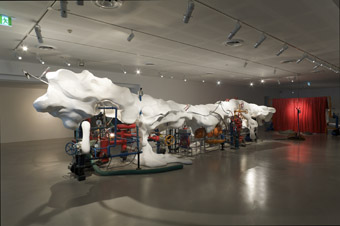
Hostage, 2008, Wang Jianwei, sculpture, Edge of Elsewhere
image courtesy the artist
Hostage, 2008, Wang Jianwei, sculpture, Edge of Elsewhere
In 2000, Wang Jianwei departed from his documentary format to create works that mixed video and live performance with surreal theatrical expression, exploring the unusual in the usual. Ping Feng in 2000 marked Wang Jianwei’s new era of integrating visual art and theatre. Successively performed in Beijing and Brussels, Ping Feng harmonises video, performance and theatre into a whole vision: a man hangs in the middle of the stage, surrounded by a group of ghostly strangers with puppets in hand. While they creep and conspire in the dark, the screen at the back flashes with changing images, among them human limbs, a drowning bird and Chinese painting. Ping Feng’s stories are drawn from the famous screen paintings, The Night Banquet of Han Xizai. The Southern Tang Dynasty (10th century) artist Gu Hongzhong was appointed by the emperor, who was worried his authority might be threatened, to spy on the reclusive scholar-official Han Xizai and paint what he had seen. To steer clear of suspicion and avoid political persecution, Han disguised his ambitions and capabilities with lustful nightly banquets. The mutual probing in this story interests Wang. He cleverly borrows the uniquely architectural element—the screen—as the theme of his work, and metaphorically indicates the psychological dodging and prying inherent in everyday life.
After Ping Feng, Wang Jianwei continued to test combinations of video, performance and theatre. His latest work, Time·Theatre·Exhibition (2009), is evidence of this consistent hybrid style, obscuring the fine line between art forms. The neat and spacious gallery is transformed into a temporary theatre. The curtain unfolds to reveal a mysterious, misty teahouse. People from different eras of history bridging thousands of years—Tang Dynasty officers, Qing Dynasty adherents, the general public of new born China and modern people—gather in this public space and indulge in a variety of pastimes: appreciating their birds, listening to music, urging their crickets to fight, gambling, flirting with prostitutes, taking drugs, singing karaoke etc.
As time and space are emerging into one in this video, struggling modern white-collars appear onstage. They run, stop, talk on the phone, yelling out the ridiculously increasing prices of the art auction or real estate market, losing themselves in the expanding desires of contemporary life. Wang Jianwei creates a live scene of overlapping time and space and proposes “we watch the exhibition in the same way we might watch drama; experience the drama just as we might view an exhibition—at the same time.”
As one of the most prominent conceptual artists in China, Wang Jianwei is difficult to label. He is neither Zhang Xiaogang who embraces the attention of auction houses nor Ai Weiwei who is made a dazzling object under the limelight of western media. Wang’s unique and profound thoughts distinguish him from his peers. Borrowing his methodologies from different disciplines to dig into the complexity of human interactions, Wang’s sheer professionalism in integrating art forms and creating, over a decade, his many investigative live works make him one of the earliest avant-gardists of interdisciplinary art in contemporary China.
The Edge of Elsewhere, Campbelltown Arts Centre, Jan 16-March 7; Gallery 4A, Sydney, Jan 16-Feb 7
RealTime issue #96 April-May 2010 pg. 42
© Shuxia Chen; for permission to reproduce apply to realtime@realtimearts.net
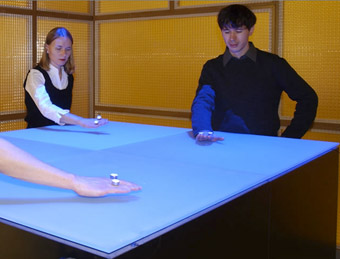
Christa Sommerer and Laurent Mignonneau, 2002, Nano-Scape: user 06, supported by Volkswagenstiftung, Hannover
image courtesy of the artists
Christa Sommerer and Laurent Mignonneau, 2002, Nano-Scape: user 06, supported by Volkswagenstiftung, Hannover
IT’S ACTUALLY PHYSICALLY IMPOSSIBLE TO ‘SEE’ NANO-PARTICLES, AS ALL IMAGING AT THIS SCALE (1NM = 1 BILLIONTH OF A METRE) CAN ONLY CONSIST OF INTERPRETED DATA. SO AS CURATOR CHRIS MALCOLM PUTS IT, THE FIELD PROVIDES “FERTILE GROUND FOR ARTISTS WISHING TO CREATE NEW PATHWAYS TO THE PREVIOUSLY INVISIBLE LAYERS OF OUR MATERIAL EXISTENCE.”
But nano-imaging aside, all five works—both new and remounted art-science collaborations from Australia, the UK and Austria featuring in Art in the Age of Nanotechnology—display an engagement with ideas above and beyond the technology, with the possible exception of Christa Sommerer and Laurent Mignonneau’s work, Nano-Scape (2002).
Nano-Scape was developed for the exhibition Science+Fiction at Hannover’s Sprengelmuseum, and consists of a glowing blue table beneath which an array of electromagnets creates constantly shifting forces, stimulated by the movement of the user’s hand—wearing a kind of ‘ring’—over the surface. The camera-tracked movements of the ring are fed to an atomic-force simulator which ‘imagines’ the ring movements as those of one relatively stable atom among a hundred or so others. The user feels the resulting forces, simulated by the electromagnets.
In ‘real life’, such movement would cause all the atoms in the array to interact in a constant readjustment of their proximity to one another. This is the force that Sommerer and Mignonneau aim to demonstrate. In its initial form a screen out of view of the participants showed atomic patterns formed by the simulation. The screen has been removed in this remount, however, to strengthen the purely haptic experience of the impossible-to-equalise system; but without either a detailed explanation of what is simulated or the visible pattern of moving atoms, the work seems to lack artistic purpose, feeling more like a science display.
Both Paul Thomas and Kevin Raxworthy’s elegant Nano_essence (2009) and Mike Phillips’ shimmering A Mote it is…(2009) abound with references to philosophy and metaphysics, at the same time remaining firmly embedded in nanotech exploration. For Nano_essence, a single, cloned (hence potentially ‘eternal’) skin cell was analysed, to compare life and death at the nano level. In a cavernous, darkened space, the viewer breathes onto a plinth-mounted, perspex re-creation of the dying skin cell. In response, on a large wall-mounted screen, a multilayered representation of the cell begins to move in 3-D animation.
We fly beneath and through the layers of the cell, which appear like angular, transparent mountainscapes or a softly haunting 3D game as the square base of the ‘cell’ tilts and turns. Amid low rumblings and tappings, mysterious figures appear, or are they twists of DNA? It’s hard to determine, but the life-giving breath seems to people the subtle, layered landscape with something animate and self-determined. They move in their own shifting geometrical plane and disappear seemingly at will, extinguished somewhere between white ‘sky’ and soft, grey oblivion.
Mike Phillips’ A Mote it is… also employs the raw data of nano-imaging to produce a lush visual metaphor, here abstracted into swirling patterns referencing the elusive nature of both the nano-world and the everyday ‘mote’—that floating speck of dust on the surface of the eye that is impossible to actually see, but that nevertheless persists in peripheral vision. After scanning a mote of dust from his own eye, Phillips devised a constantly moving whirlpool of data-generated ‘particles’ mediated by face-recognition software. When viewed front-on, the swirl is entrancing; a sunburst-coloured play of light accompanied by an electronic soundscape. When the head is turned to one side, something seems to go against the tide—impossibly ephemeral particles appear and disappear, resonating with the ‘creatures’ of Nano_essence, perhaps, but in this case as barely perceptible as the mote itself.
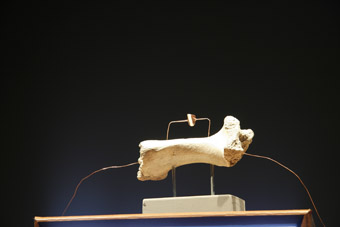
Boo Chapple, Transjuicer, 2009, detail, John Curtin Gallery, 2010
image courtesy of the artist
Boo Chapple, Transjuicer, 2009, detail, John Curtin Gallery, 2010
A series of transformations is at the heart of Boo Chapple’s multifaceted and playful Transjuicer (2010). After becoming aware of the piezoelectric qualities of bone—when subjected to any mechanical stress it generates an electrical charge at the nano scale—the artist set about creating bone audio speakers, using the femurs of cows. Initially fascinated by this constant response of living bone to its environment and its potential as a metaphor for the complex interactions of life and world, Chapple found that the difficult process of trying to make the audio speakers pointed to other complexities, not least of which are the ‘transducings’, or conversions, that come into play between micro technological interventions and the macro social context, between living and dead matter, and between science lab and gallery.
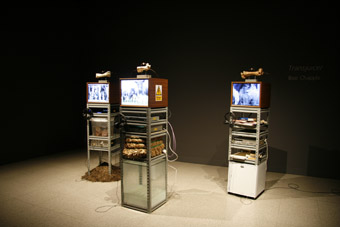
Boo Chapple, Transjuicer, 2009, installation view, John Curtin Gallery, 2010
image courtesy of the artist
Boo Chapple, Transjuicer, 2009, installation view, John Curtin Gallery, 2010
Transjuicer consists of three screens atop rack mounts that house bales of straw, a tank of rotting cow bones, shelves of lab reference books and three audio players with headphones. On the top of each tower sits a highly polished cow femur wired to the small sections of bone that constitute the ‘speakers.’ Tinkling through the headphones, Chapple’s three successful recordings are distant, distorted renditions of “Dry Bones”, “Old MacDonald” and “Good Vibrations”—recordings made, after many unsuccessful attempts, by a laser interferometer. The video screens play loops of cows at the milking shed. Chapple describes Transjuicer wryly as “milking it.” The work’s playfulness trots lightly over the process, but Transjuicer succeeds in illuminating some awkward, absurd and inescapable liaisons between art-making, primary production, the mastery of materials and messing around with living matter.
Victoria Vesna and James Gimzewski’s Nanomandala (2003), reviewed separately in this issue, is, put simply, an extended zoom from macro to nano scale and back out again, its focus the Tibetan Buddhist sand mandala of Chakrasamvara, created for the first time in the USA by monks from the Gaden Lhopa Khangtsen monastery. More subtly interactive than some of the other works here, Nanomandala, projected onto a two-metre disk of sand, has meditative qualities; the saturated colours of the mandala inviting immersion in a slowly changing, seamless progression to the limits of imaging. A spiritually focused artwork, Nanomandala also has an illustrative simplicity, displaying the conundrum that grounds all the works in Art in the Age of Nanotechnology: the ability to ‘see’ what is in a literal sense unseeable—particles of matter that are smaller than wavelengths of light.
Art in the Age of Nanotechnology, curator Chris Malcolm, artists Paul Thomas and Kevin Raxworthy (Australia), Mike Phillips (UK), Victoria Vesna (USA) and James Gimzewski (Scotland), Christa Sommerer (Austria) and Laurent Mignonneau (France), Boo Chapple (Aus); John Curtin Gallery in association with Curtin University Centre for Research into Art, Science and Humanity; Curtin University of Technology, Perth, Feb 5-April 30.
RealTime issue #96 April-May 2010 pg. 26
© Urszula Dawkins; for permission to reproduce apply to realtime@realtimearts.net
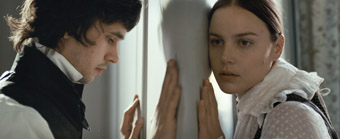
John Keats (Ben Whishaw) and Fanny Brawne (Abbie Cornish), Bright Star
THE LIFE OF A WRITER IS HARD TO BRING TO DRAMATIC LIFE ON SCREEN. WRITING CAN BE A SOLITARY JOURNEY WHERE THE RAW DRAMA IS INTERNALISED, GOING ON IN THE MIND, THE BODY, THE FRENETIC PACING OR ANXIOUS WAITING OF FINGERTIPS, HOLDING A PEN, ON THE TYPEWRITER, THE KEYBOARD. TRANSLATING THAT FRACTIOUS INNER WORLD CAN BE A CHALLENGE, SO BIOPICS OF THE LIVES OF WRITERS TEND TO FOCUS ON THEIR RELATIONSHIPS WITH OTHERS, THEIR ADDICTIONS OR THEIR HARROWING PATH TO SELF-DESTRUCTION.
From The Edge of Love (Dylan Thomas) to Sylvia (Plath) to Factotum (Charles Bukowski) there’s usually a scene where the writer self-combusts, tearing the room apart, smashing a plate or glass, throwing his/her manuscript out the window, grabbing a knife or a gun. Hell, it looks good on screen, and gives actors a chance to flex their dramatic muscles. It sure beats staring glassy-eyed at a computer screen, adjusting the venetian blinds, making a tenth cup of tea to procrastinate, curling up on the lounge underlining passages for future research, and waiting hours for the manuscript to print.
Jane Campion has always had literary leanings in the filmmaking projects she takes on. In an early interview, she spoke about how seeing Gillian Armstrong’s My Brilliant Career (the Miles Franklin biopic) proved to her that directing was a possible career choice for a woman (Deb Verhoeven, Jane Campion, Routledge Film Guidebooks, UK, 2009). Her first feature, Two Friends, was based on a short story by Helen Garner. The critically acclaimed An Angel At My Table, originally a mini-series, was based on the life of New Zealand writer Janet Frame who spent many of her formative years in institutions with incorrectly diagnosed schizophrenia (in one scene, pre-empting Campion’s latest work, Bright Star, Frame’s best friend Poppy quotes Ode to a Nightingale at length in a cow paddock: “We have to learn it by heart”; later, becoming more and more isolated, Frame says, “My only romance was in poetry and literature”).
Campion’s less successful Portrait of a Lady and In the Cut offered very different subject matter but were film adaptations of successful books, nonetheless, and Gail Jones argues the strong impact of Emily Bronte and the poets Blake, Tennyson and Byron on the mood of The Piano (The Piano, Australian Screen Classics, Currency Press, Sydney, 2007; reviewed RT80, p34). Campion even took the unusual step of publishing ‘novel’ versions of her films, The Piano and Holy Smoke. Her latest offering, Bright Star, tackles the relationship between Fanny Brawne (Abbie Cornish) and John Keats (Ben Whishaw) before the poet’s death at 25. After making In the Cut, Campion told the media she was planning to take four years off. When interviewed about her time away from filmmaking, she commented, “I didn’t think I would want to do anything much, but I found that after a year or so…I was doing things like embroidering pillow slips and very crafty simple stuff.” Out of the quiet and silence, it seems, Bright Star emerged.
In The New York Review of Books, Christopher Ricks argues that Campion’s film is mistaken about the nature of imagination when it comes to a poet, especially Keats: “film cannot but show in pictures” (New York Review of Books, vol. 56, no. 20, Dec 17, 2009). He is hard on the director, stating that a film should never picture what a great writer has already beautifully captured, allowing us to imagine instead. He gives an example where Keats talks of snow and we simultaneously see snow in the image. When he speaks of being ‘pillowed’ he is lying with Fanny, resting his head. But in the course of writing, a novel for example, a writer may repeat herself many times, making overlapping allusions to make things clearer for the reader. And it works here within the film’s frames, especially if a viewer is not as conversant with Keats’ poetry as experts like Ricks. Campion’s view is inclusive and the linking of text with image acts as a springboard for our imagination: the images, like Keats lying as if in the clouds amid the treetops, are often so exquisite (cinematographer Greig Fraser) they bring the words to life, rather than trampling them underfoot.
Some of these scenes are also based on historical account. In a letter, Keats’ friend Charles Armitage Brown (Paul Schneider), who in the film tussles with his seeming love and envy of both Fanny and Keats, described the background to the writing of Ode to a Nightingale, where the bird had built a nest near the house. Keats loved her song and took his chair out to the plum tree to listen for hours (Elizabeth Cook ed, Introduction to John Keats, Selected Poetry, Oxford University Press, 1998). Those moments of silence, of being able to be still, to listen, to observe nature, to compose, are captured well by Campion. She’s always been interested in the link between silence and expression. In The Piano, the central character Ada (Holly Hunter) is mute, unable to express herself except through her music; in the final scene of An Angel At My Table, Janet Frame is most happy in solitude, after finding the daily struggle of communicating (other than writing) a punishing act. As she works alone on her manuscript in a caravan, reading aloud the final lines, Campion, writes Gail Jones, “affirms a connection between silence and creativity, and indeed affirms the paradoxical ‘wording’ of silence.”
Ricks argues that “Jane Campion’s mind sought to imagine into another, and yet it did not really put its mind to imagining, let alone imagining into the mind’s eye.” But like Keats’ star that watches and gazes—in the sonnet from which the film takes its title—Campion is a sharp observer, and yet she also allows, throughout her films and contrary to Ricks’ criticism, a “sense of touch” to be “imagined by the reader.” Vivian Sobchack argues that The Piano is less about vision than touch, the “capacity to implicate the viewer’s body” (Carnal Thoughts: Embodiment and Moving Culture, Berkeley, University of California Press, 2004). She talks specifically about fingers, and in Bright Star we tend to focus on Fanny’s senses rather than Keats’: her hands as she crafts stitches onto a pillowslip, copying a tree outside the window. An exquisite example is the wall that divides the two almost-lovers as they position their single beds in adjoining rooms. They’re so close they can hear the sounds of sleep; if the wall were to be removed they would be together, lovers in a double bed, but, apart, their longing is palpable as Fanny traces the surface that separates them, the viewer imagining Keats feeling her touch. As Fanny lies on the bed letting the wind caress her—through the window against her layer-upon-layer of lovingly stitched clothes—it’s her mind and body we imagine into, not those of Keats which are further removed.
Ricks even goes so far as to say Campion does not respect Keats and his writing. This seems hard to justify, given her record of sensitive cinematic interpretation of writers’ lives. Campion said, “With An Angel At My Table I felt any treatment that interfered with your relationship to Janet Frame would feel like a filmmaking conceit. You needed to keep it very simple” (cited in Verhoeven). Helen Garner describes the process of working on Two Friends: “I was surprised at how Jane could take an idea of mine and take a different slant on it, and yet understand exactly what I was on about. She’d find a richness I didn’t know was there” (cited in Verhoeven). In Bright Star, there’s a great sense of tragedy in the loss of Keats, of his talent, of his strength, of his compassion, of the “negative capability [that] generated poetry that depicted changing sensations rather than articulating settled meanings.” (Sophie Gee, “Bright Stars”, The Monthly, Melbourne, Dec 2009-Jan 2010).
Elizabeth Cook comments that “to an unusual degree Keats writes in active and conscious relationship with others” and Campion stresses this. The men’s work, and the writing, is collaborative: they prance through meadows, they read aloud to each other, they lie dramatically awaiting inspiration; but Fanny’s art is done behind closed doors, alone, dreaming, embraced by the body—until a late scene where, finally, she walks over the threshold to breach the men’s creative space. Campion prefers to focus on women’s work, the seamless stitching, beautiful threads, so precise and delicate they might go unnoticed.
Like Keats, Jane Campion is an artist who trades in the realm of the senses. As with An Angel At My Table, her Bright Star is a sensuous delight, which successfully evokes the work and vision of being a writer (or seamstress) without excessive drama or sentiment: the time alone, the collaboration at times, the critical thinking, the musings in the meadow at nothing or everything, the recreation of a shared moment into the shape of love. Campion also creates space for the viewer’s imagination, a longing for more words, a desire to seek out Keats’ poetry as Whishaw’s voice reads it aloud after the final image fades and the end credits roll.
Bright Star, director and screenwriter Jane Campion, actors Abbie Cornish, Ben Whishaw, Kerry Fox, Paul Schneider, producers Jan Chapman, Caroline Hewitt, Mark L. Rosen, cinematography Greig Fraser, editor Alexandre de Franceschi, production design & costume Janet Patterson
RealTime issue #96 April-May 2010 pg. 18
© Kirsten Krauth; for permission to reproduce apply to realtime@realtimearts.net
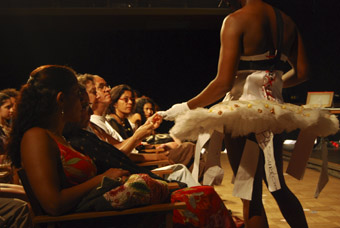
Influx Controls, Boyzie Cekwana, performed at the Panorama Festival, Rio de Janeiro
photo Valério Araújo
Influx Controls, Boyzie Cekwana, performed at the Panorama Festival, Rio de Janeiro
Just now it’s a small wave of performances around the world in which audiences provide bodies, decision- and art-making by playing to rules and tasks set by artists to make works. But it’s a rising tide as can be see throughout this edition of RealTime. There’s a simultaneous increase in artworks offering immersive experiences, either through proximity and intimacy or via sensory deprivation—or amplification. Either way the audience makes a greater commitment to art than the usual heightened receptivity. The 2009 PuSh Festival in Vancouver focused on both kinds—small works like Jerk and Kamp that radically re-aligned audience seeing and thinking, or a relatively large one like Rimini Protokoll’s Best Before where a large audience, all with Xbox-type controllers, used avatars to make collective choices and engage not with performers but “experts in daily life.” In the performance event In-habit at Melbourne’s Abbotsford Convent, Jason Maling and Torie Nimmervoll became Colour Auditors, conducting and analysing a 12-day colour coding of the site by people working there, while Katerina Kokkinos-Kennedy’s Once brought pairs of strangers into silent contact for 10 minutes each. Elsewhere in Melbourne, Nicola Gunn’s At the Sans Hotel, the performer discussed with her audience “the show that should have taken place and the narrative problems it presented.” Matt Prest and Clare Britton’s new work, Hole in the Wall, will require its audience to inhabit and move mobile rooms. In a dance workshop in the Perth Festival, visiting choreographer Robyn Orlin tested guests with a “probe into discrimination by replacing race with arbitrary characteristics like vegetarianism”. For many years interactivity has been largely associated with new media, but now physical correlatives are increasingly appearing in live performance. In Rimini Protokoll’s Best Before the decision-making is digital in a live art context. Meanwhile new media art continues its sustained engagement with interactivity, as in Van Sowerwine and Isobel Knowles’ You Were in My Dream (for Experimenta’s Utopia Now) where, once you’ve peered into the installation, your face is assumed by the principal character in the work’s stop-animation.
On another level, the prospect of developing a national cultural policy requires artists and audiences to see themselves interactively, as critically responsive to Arts Minister Peter Garrett’s notion of what comprises ‘culture.’ Similarly we can no longer allow the future of Australian film to be determined without collectively addressing the issue of screen culture. What is screen culture and will the making of more and more films alone grow an audience for Australian film? Over to you.
RealTime issue #96 April-May 2010 pg. 1
© Keith Gallasch; for permission to reproduce apply to realtime@realtimearts.net
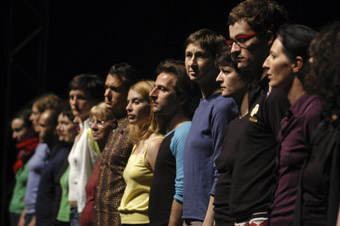
The Show Must Go On, Jerome Bel
photo Mussacchio Laniello
The Show Must Go On, Jerome Bel
YOU’RE SITTING IN THE FEI AND MILTON WONG EXPERIMENTAL THEATRE IN DOWNTOWN VANCOUVER. AN EASILY RECOGNISABLE POP SONG IS PIPED IN THROUGH THE SOUND SYSTEM. LISTEN CAREFULLY TO THE FOLLOWING LYRICS: “IMAGINE THERE’S NO HEAVEN. IT’S EASY IF YOU TRY. NO-ONE TO LIVE OR DIE FOR. ABOVE US ONLY SKY.”
Upon hearing this peace anthem by John Lennon do you: (a) mull over the composer’s message; (b) reflect on the diverse mix of your fellow patrons; (c) wave your iPhone in the air and sing along? Most Vancouverites in attendance for Jerome Bel’s The Show Must Go On chose the last option. The show’s choreographers were disturbed: “Why are they singing?” After all, the show provoked a near riot when it opened in Paris ten years ago, not a love-in.
jerome bel, the show must go on
Bel had made a contemporary dance performance that didn’t feature dancing, at least not the kind usually performed by trained professionals. Instead he put bodies on stage: trained and untrained bodies, bodies of various shapes and sizes meant to represent the bodies in the audience. These onstage bodies moved, stood still, observed, listened and sometimes embraced. Invariably they did these things to the accompaniment of well-known pop songs. To David Bowie’s “Let’s Dance” they stood and listened, moving to the beat intermittently. To Roberta Flack singing “Killing Me Softly” they ‘died’ slowly and gently while listening to the singer and watching the audience. Spectators at the Parisian premiere were offended. In Vancouver, the former hippie capital of Canada, Lennon’s song provoked a sing-along. Not only did the spectators sing, they got up and danced whenever there was the hint of a groove in one of the Top-40 hits in rotation. Here was the democracy of meaning-making in action at a postdramatic theatre event. You say ‘contemporary art’, we say ‘dance party.’ The audience had wrested control of the event from the artists.
Bel hadn’t intended things to go this far. In his work as a choreographer he has tried to undermine the idea that the performer, by virtue of her/his expertise and position of power on stage, is somehow better than the spectator. For Bel a performance should mirror the socio-political reality of the audience. As he has argued, there is an historical logic to this. Contemporary dance traces its origins to the court of Louis XIV, the ‘inventor’ of ballet. When the king was in the audience the performance was supposed to reflect the image of its royal patron. After the French Revolution, the execution of the king and the shift to democracy, the performance was supposed to reflect a new patron—the bourgeoisie. That’s pretty much the situation we’re in today: educated, middle-class performers dancing for educated, middle-class patrons. In order to truthfully represent this reality of a performance event among social equals, Bel encourages mutual observation: the performer and spectator watch each other. The privilege of the expert performer is broken down by having her/him do things any spectator could do given a few weeks to rehearse.
The encounter between spectator and performer in The Show Must Go On is stark, comical, often surprising, and sometimes very moving. Bel achieves all this by setting very simple tasks for his performers. In one section they listen carefully to songs on their iPods, and very loudly sing the choruses when they come around. Watching an overweight lawyer (and former dancer) in his 50s intently focused on his iPod while occasionally blurting out “I’ve got the power!” was a truly comic spectacle. In another sequence, the performers’ simple action of walking up to each other and embracing to the theme song from Titanic is both absurd and touching. Often the performers simply stand and watch us. There’s something naked about their watching, and it makes me feel naked—and very present. I think this is how Bel wanted it. But when “Kiss” by Prince starts up, the audience is on its feet, shaking it. This is not what Bel wanted. We were supposed to sit in our seats, listen, watch and behave—like well-trained middle-class citizens?
gisele vienne, jerk
The idea of mutual watching is a conceptual thread running through this year’s PuSh Festival. As executive director Norman Armour puts it, the “act of witnessing or bearing witness” in the shared moment of performance is a thematic concern of many of the shows. It’s also the inevitable result of spatial configurations that foreground the performer-spectator relationship. Sometimes the combination of a very intimate performance space and very uncomfortable subject matter is enough to provoke an encounter of intense co-witnessing. In director Gisele Vienne’s Jerk (France) an audience of about 50 people is crowded onto a very small stack of bleachers in breathing distance of actor Jonathan Capdevielle. The room is painted white and fluoro-lit. In this setting Capdevielle is able to watch audience reactions in detail as he performs gruesome murders of teenage boys in real time with puppets. The script is based on serial murders that occurred in Texas in the 1970s. The lighting and close proximity to the performer leave us nowhere to hide as we are forced to contemplate this disturbing subject through various layers of theatrical mediation that include puppets-as-characters, the actor’s arm-as-puppet and the actor as both ventriloquist and dummy. At times I am forcefully dissociated from my own feelings, which themselves become like puppets to observe: feelings of horror, amusement, disgust and impatience. [See more about Jerk, p32.]
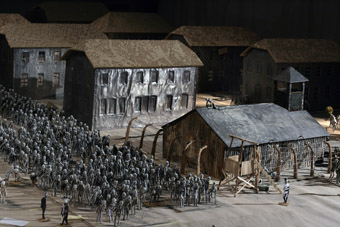
Kamp, Hotel Moderne
photo Herman Helle
Kamp, Hotel Moderne
hotel moderne, kamp
Kamp by Hotel Moderne (Rotterdam) is performed at the Roundhouse, a larger space that offers a little more distance from which to witness yet another horror, the genocide at Auschwitz. The concentration camp is presented as a scale model that covers the large stage area. Three puppeteers move hundreds of Jewish inmates through the assembly-line of mass murder, complete with rail terminal, sleeping quarters, officers’ mess, watch towers, supply trucks and the infamous gas chambers. The scale model gives the audience not a bird’s eye view but the one you’d have if you were a CEO taken up on a catwalk by a plant manager who wanted to give you a better look at the factory’s workings. From this perspective, the human figurines, while individually crafted, are made generic by their uniforms, whether prisoner or guard issue. The obliteration of individual character in the context of a militaristic ideology that classifies human beings according to perceived evolutionary type is in itself worth an essay.
Let me briefly note that when asked by a patron why the Nazi guards were given more menacing features than the Jewish prisoners, the artists suggested the perception of difference was all in the uniforms; they hadn’t differentiated between guard and inmate when making the figurines. We’re able to see the figurines in some detail thanks to a tiny hand-held camera the puppeteers use to film many of the sequences. The images that appear on an upstage screen have a gritty, hand-held, journalistic immediacy to them. Even with these close-ups we never lose sight of the fact that we’re witnessing a slaughterhouse in operation. Neither the puppeteers nor the prison figures look back at us from a perspective that is particular or unique. They, and we, have been depersonalised. We have become industry. We have become utility in the service of mechanistic eugenics and skewed Darwinian ideology.
ahke theatre, white cabin
From organised genocide to creative chaos: White Cabin by Ahke Theatre (St Petersburg) offers a life-affirming counterpoint to Kamp, but sit in the front row at your peril. A large, bearded man in partial whiteface, wearing horn-rimmed glasses and a pork pie hat, might splatter you with red wine as he empties a bottle over himself or sprays it onto his fellow performers. Bits of newspaper, floating like tiny airships on fire, might make you their landing pad. This is not participatory theatre but, like Jerk, the intimacy of the venue puts the audience dangerously close to the action—and the action is non-stop, carnivalesque and enticing despite the hazards. Who knows why the two large men and the medium-sized woman do hand-stands on tables, try to hang themselves or pour milk on their naked backs? And who cares? Each image unfolds like a live painting featuring playful demons from a world that crosses Russian folklore with 19th-century artist’s garret. Watching them makes me want to knock back some vodka and throw some wine and paint around for myself.
Then something truly wonderful happens. Three large panels of white fabric are dropped across the front of the prop-littered stage. Each has a large window cut out of its centre. The first panel has the biggest window, the third the smallest. It feels a bit like a puppet theatre within a puppet theatre, while also carrying the suggestion of a series of Russian nesting dolls. The performers variously enter the front, middle or back windows and create brief tableaux or moving scenes—they fight, smoke cigars and one of them commits symbolic suicide by holding plastic bags of water to his body and slashing them open with a knife. Because these scenes take place in the shallow space between one window and the next, a visual tension is created by the three-dimensionality of the performers’ bodies against the flatness imposed by the window frames. This perspective is made more disorienting by the two-dimensional paintings and photographs that are projected onto the white fabric. Because these images are usually in zoom-in or zoom-out mode, they give us the feeling of alternately falling into or out of the windows. Sometimes the zooming stops and we are overwhelmed by something else, like the scene in which the performer’s newspaper catches fire: the live fire is matched by a video projection of flame that covers the entire canvas, momentarily creating the impression that the set is actually burning.
what are the rules here?
But it’s an illusion. In all the performances I’ve described so far the artists have carefully shaped their illusions. Even Jerome Bel. Especially Bel. Despite the fact that some of his performers are untrained—non-experts, you might call them—the overall construction of The Show Must Go On is as brilliantly crafted and manipulative as the most revered canonical works of Western dramatic literature. Bel spent two years making his show. We spend less than two hours trying to figure out the extent of our agency— are the performers inviting us to take part bodily, or just mentally? How much freedom do we have to affect the outcome of the event? What are the rules here?
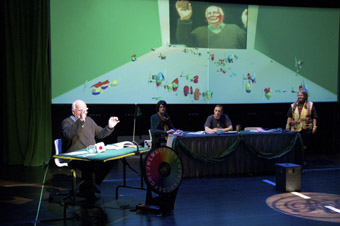
Best Before, Rimini Protokoll
courtesy the artists and the PuSh festival
Best Before, Rimini Protokoll
rimini protokoll, best before
Enter Rimini Protokoll for a dose of genuine interactivity [see RT91, p18]. The Berlin Company’s new work Best Before was commissioned by PuSh and created in Vancouver. It features what Rimini calls “experts of daily life”—non-actors from various walks of life. These “experts”—a flagger, an ex-finance minister, a computer game tester and a game programmer—are connected by the fact that two of them worked at Electronic Arts, one of the world’s largest producers of video games, and three of them drove past the flagger on their way to work each day. So the idea of a daily journey (travel to work) is connected to the idea of something under construction (the site around which the flagger is directing traffic), and both of these are connected to the metaphor of life as a video game you win or lose.
Together with Rimini’s artistic directors, the experts have created a game the whole audience can play at once. Each spectator is given an Xbox-type controller to create and manipulate an avatar on the huge screen that stretches across the back of the stage. Around 200 spectators take part, through their avatars, in practical decision-making such as finding a mate, buying a house, choosing a candidate, supporting military spending and voting on abortion rights. As the title suggests, Best Before is a show about life choices and about taking stock of those choices before your ‘due date’ comes up. When contentious issues are introduced, interaction jumps from the screen to the seats where spectators get into playful or heated arguments. Unlike Bel in The Show Must Go On, Rimini seems to relish these outbreaks. And they’ve given the audience coherent parameters—they provide a playing field, rules and a worthy opponent. The company also risks having these parameters redefined by the spectators. In this sense the spectator-performer relationship is truly levelled.
As in The Show Must Go On, this levelling is made clearer by the fact that the performers are untrained actors. The truth-and-consequence on-screen game is counterpointed by the stories of the experts who talk about life choices that led them to their current circumstances. Each story has its own peculiarity: a woman gives up journalism to direct traffic; a man goes from finance minister to night club owner; another man claws his way through the hierarchy at Electronic Arts only to be ‘rationalised’ out of a job. The experts’ lack of expertise in theatre works against the self-assured authorial coherence of a typical theatre performance. As performance theorist Florian Malzacher writes, “A Rimini performance is never perfect, nor should it be. At the point where the performers become practiced enough to feel secure, begin to build their roles and to act, the piece loses more than just its charm. Insecurity and fragility are the defining moments of what is understood by many to be authenticity. Yet such moments where timing, tension, empathy and presence disappear are also agonising.” These moments make you “feel uncomfortable as an audience member. You suffer too for a moment, feel embarrassed or touched by the efforts of performers who cannot protect themselves through acquired techniques” (Florian Malzacher,”Dramaturgies of care and insecurity”, M Dreysse, F Malzacher ed, Experts of the everday, the theatre of Rimini Protokoll. Berlin: Alexander Verlag Berlin, 2008).
situating the spectator
Each of the shows I’ve considered asks the spectator to situate her/himself in relation to the performers themselves, and not just in relation to a fiction or an ‘elsewhere’ the performers may be representing. Each event provides a thematic and aesthetic frame in which we meet and reflect on who we might be to each other. In these situations the artists avoid setting themselves up as authorities. Canadian installation artist Vera Frenkel writes that the postmodern artist seeks to undermine the possibility of her/his own charismatic authority and permits us to not “believe so readily in the other as the keeper of our treasure and our disease” (cited in Philip Auslander, From acting to performance, Routledge, London and NY, 1997).
The role of the spectator has shifted from decipherer-of-meaning to co-creator of the theatrical event. Another way to put it is to say that interpretation has been subordinated to encounter, and that it is in the energy of the encounter that meaning is created, rather than having meaning encoded in the event beforehand by the artist. The idea of mutual witnessing probably doesn’t do this justice, since witnessing privileges looking, and looking implies distance between the watcher and the watched. If there is a common goal to many of this year’s PuSh performances it is to break down that distance. The common strategy of levelling the playing field is used in other shows at this year’s PuSh I haven’t mentioned, like Poetics: a ballet brut by Nature Theater of Oklahoma (NY), in which four non-dancers awkwardly perform an entire choreography made up of everyday movements—another version of non-expert performance in an expertly created frame. As cognitive science has shown, spectators tend to respond kinetically to what they are watching. Even though it may not be apparent, a spectator responds to movement neuro-muscularly. If this year’s PuSh is about witnessing, we are witnessing with our whole bodies, so to speak. Often the bodies on stage are as diverse as the bodies in the seats. Thanks to the artists willingly relinquishing control (and even sometimes when they’re not) it’s almost a meeting of equals.
This particular kind of risk-taking is only part of what made this year’s PuSh Festival so remarkable. While past incarnations have featured leading lights of international theatre such as Societas Rafaello Sanzio (Italy), Back to Back (Australia) and Forced Entertainment (UK), this year’s program has been the most insistently cutting edge from start to finish. PuSh has also helped push Vancouver from bystander to participant in the greater creative flows of world theatre. In doing so it has helped local companies to successfully show their wares nationally and internationally, as in the case of Theatre Replacement’s now infamous Clark and I Somewhere in Connecticut (2008). Now in its fifth outing, PuSh has taken its place among the best theatre festivals of its kind.
PuSh International Performing Arts Festival 2010: Jerome Bel, The Show Must Go On; Gisele Vienne, Jerk; Hotel Moderne, Kamp; Ahke Theatre, White Cabin; Rimini Protokoll, Best Before; Vancouver, Jan 20-Feb 6; for full production credits go to http://pushfestival.ca
RealTime issue #96 April-May 2010 pg. 2-3
© Alex Ferguson; for permission to reproduce apply to realtime@realtimearts.net
THE END IS EXTREMELY NIGH! DEATH AWAITS! WITNESSING GYÖRGY LIGETI’S OPERA GRAND MACABRE IS LIKE WALKING INTO THE HELLISH SCENES OF PIETER BREUGHEL’S PAINTING THE TRIUMPH OF DEATH (C1562), THE INSPIRATION FOR THIS OPERA’S STORY.
Premiered in 1978 and revised in 1996, Le Grand Macabre is a magnificent piece of comic music theatre, complex, demanding and highly entertaining, and this is a wonderful production, with outstanding performances and staging. The story, drawn from the absurdist play La Balade du Grand Macabre by Michel de Ghelderode, tells the story of Nekrotzar, the Grand Macabre, who returns from hell to destroy the world with a comet sent by God. Though wreaking havoc, Nekrotzar fails in his quest, and the opera ends optimistically with an exhortation, “Fear not to die, good people all, no-one knows when his hour will fall.” Instead, our profane ways go unpunished, love triumphs and we are urged to embrace happiness.
This production, directed by Valentina Carrasco and Àlex Ollé of Spanish performance group La Fura dels Baus, opens with a projected video showing a woman who is ill to the point of collapse and surrounded by the detritus of gluttonous bingeing. The video then gives way to the theatre set, where we see a model of the sprawling woman, now naked and enlarged to fill the stage, her face frozen in horror. The action takes place inside and around this monstrous, abject figure, which is rotated to voyeuristic viewing positions and strategically dismantled while all kinds of imagery are projected onto it—the comet, a skeleton, heads rolling under Nekrotzar’s scythe, Breughel-like figures descending into hell, and then the fires of hell itself. The surreal play thus appears as the nightmare or hallucination of a sick woman. The staging suggests all kinds of allegories, from Gulliver in Lilliput to a corpse being devoured by rodents. She is inert and helpless beneath her intruders, as the secret police emerge from her intestines and people walk in and out of her head, breast and vagina. Such a representation of woman is provocative and, some might suggest, obscenely incorrect, but she literally embodies our own anxieties, harrassed as we are by the troublemakers of society, and when her innards finally collapse, we feel her torment in our own abdomens.
Le Grand Macabre updates the traditions of opera with those of absurdist theatre, pondering the meaning of life in a licentious, ridiculous world. The setting is the fictional principality of Breughelland, and the characters are caricatures—Piet the Pot, a drunkard whom Nekrotzar enlists to support his mission; two insatiable lovers, Amando and Amanda; the astrologer Astradamors and his dominatrix partner Mescalina; Gepopo, the hysterical chief of secret police; and the impotent prince Go-Go and his fawning, bickering, manipulative ministers and brutal police. The satirical story addresses a range of political and social themes—Nekrotzar (the name suggests a dead tsar resurrected through necromancy) represents dictators from Hitler to Stalin who dominated Europe in Ligeti’s youth, and the comet suggests nuclear missiles. Sex, death and drunkenness are central—Astradamors and Mescalina’s sadomasochism represents the fickle ruler and the ruled, and Amanda and Amando, in costumes resembling anatomical illustrations as if they have been flayed, seek unattainable pleasure. At various times, characters fake death or think they are dead, or are dead and are then revived, as if death is merely an alternative and contingent state. Ultimately, Piet and Astradamors get Nekrotzar so drunk that he fails in his mission (a lesson for us all), suggesting that men are all dissolute failures. Gender issues are also central, amplified by the confronting set design—women can be independent and controlling, and can also be obsessed by desire. Gepopo and Venus are sung by the same actor (the wonderful Susanna Andersson), suggesting the interchangeability of the characters, and Amanda and Amando are both played by female performers, further confusing gender identities.
The brilliant score, opening with a fanfare of car-horns parodying a wind ensemble, is a collage of classical and operatic musical genres, fragments and gestures. Particular instruments emphasise characterisation, such as bassoons for Piet and rumbling brass for Nekrotzar. Scene one ends with a swirl of bassoons, bass clarinet and brass that echoes and elaborates the car-horn introduction. The lovers’ duet is exquisite, but haunted and disturbing, and the passacaglia finale is classically beautiful. A metronome, recalling an earlier work of Ligeti’s, Poéme Symphonique for 100 metronomes, ticks down the last hours of the world like a clock. To suit the action, the music is alternately slapstick, raucous, dramatic, gently melodic or ironic, sometimes underscoring and sometimes mocking the vocal line, or recreating the vernacular sound effects of urban life. The orchestra is heavily weighted towards winds, brass and percussion, with a reduced violin section. Robert Houssart’s conducting of the Adelaide Symphony Orchestra is excellent, ably supporting the superb cast of international and Australian soloists.
Such music is conspicuously different from the music of any era, challenging both the avant-garde conventions that dominated the early- and mid-20th century and the traditions of earlier opera. Neither classical nor modernist but referencing both, it is postmodernist, a milestone in the evolution of music, and particularly suited to the absurdist mockery of human foibles. Le Grand Macabre thus appears as Ligeti’s personal reaction to the music of his upbringing and to religious and political dogma, a unique statement in his oeuvre. Though it is rooted in the World War II and Cold War eras, it remains highly engaging artistically and still relevant in a world beset by the politicking around terrorism and climate change.
The opera concludes with a return to the opening video, where we see that the woman has recovered and is washing her face in the bathroom. The Fura Dels Baus production acknowledges the new normal of ‘televisual reality’ in 21st-century life, and this use of video as a framing device locates the opera as a cultural and historical document. Le Grand Macabre delivers ironically contrasting messages about the end of the world—selfishness, vanity and overconsumption bring on the illnesses of our society, but ultimately death happens anyway and, in the meantime, life, however meaningless, must be lived.
–
Adelaide Festival, Le Grande Macabre, music György Ligeti, libretto Ligeti and Michael Meschke,directors Àlex Ollé, Valentina Carrasco, conductor Robert Houssart, Adelaide Symphony Orchestra, State Opera Chorus, a co-production of Théâtre de la Monnaie, Brussels, English National Opera, Gran Teatro de Liceu, Barcelona and Teatro dell’Opera di Roma; Festival Theatre, Adelaide Festival Centre, Feb 26, 28, March 3, 4
RealTime issue #96 April-May 2010 pg. 4
© Chris Reid; for permission to reproduce apply to realtime@realtimearts.net
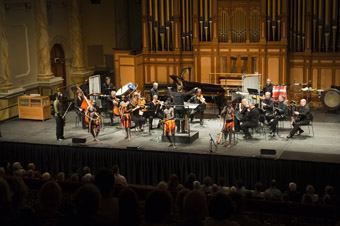
Tract, London Sinfonietta and the Young Wägilak Group
photo Matt Nettheim
Tract, London Sinfonietta and the Young Wägilak Group
TWO SUPERB CONCERTS BY THE LONDON SINFONIETTA AT THE 2010 ADELAIDE FESTIVAL ILLUMINATED SOME SIGNIFICANT DEVELOPMENTS IN MUSIC IN THE 20TH AND 21ST CENTURIES AND ESPECIALLY SHOWED HOW COMPOSERS CAN BLEND MULTIPLE MUSICAL AND CULTURAL FORMS INTO EXCITING NEW WORKS.
The first concert, titled Pacific Currents, opened with US composer Yvar Mikhashoff’s arrangement of Conlon Nancarrow’s Player Piano Study No 7, a musical revelation that set the tone for the evening. In the mid-20th century, US-born Mexican composer Nancarrow created numerous compositions by hand-cutting piano rolls for the player piano, producing works so complex they could not be performed by a single pianist, and characterised by competing rhythmic structures and layered canon forms. Mikhashoff’s realisation involves expanded instrumentation—strings, winds, brass, harpsichord, piano, celeste and percussion—and it brilliantly captures Nancarrow’s breathtaking pace and complexity while adding some extraordinary textures, drawing out the layering to produce a rapturous work.
Silvestre Revueltas’ Ocho Por Radio (1933) followed, a work for octet that evokes the music of radio in his native Mexico, especially the mariachi bands, and which combines multiple genres into a single, increasingly chaotic work. Unsuk Chin’s electrifying Double Concerto (2002) for piano and percussion blended virtuosic solo instrumentals by Lisa Moore and Owen Gunnell into a complex series of cascading musical structures that build and rebuild, drawing prepared and natural piano passages into balanced intensity with the percussion and creating a dialogue exploring all kinds of percussive sonorities. John Cage’s Credo in the US (1942), for piano, percussion and either a radio or a phonograph, was originally written as a dance piece and prefigured Stockhausen’s use of radio in performance. In this realisation, a laptop was used to supply the recorded material, including fragments of Chopin, ragtime and other popular music that dramatically contrasted with the live elements and echoed Revueltas’ concern with the cultural impact of reproduced music.
The first concert concluded with John Adams’ highly rhythmic Son of Chamber Symphony (2007), which has also been choreographed to and includes fragments of his opera Nixon in China. Though less cerebral and more accessible than preceding works, it is complex and absorbing. The program for Pacific Currents was both musically enchanting and intellectually demanding, emphasising the impact of rhythm and showing how multiple forms and alternative musical sources could be integrated. All the works use repeated patterns in various ways, showcasing mid-to late-20th-century approaches to composition and the reactions to dominant and avant-garde cultural forms and aesthetics.
The second concert, Wind and Glass, comprised works by two British and three Australian composers. British composer Tansy Davies’ Neon (2004) is based on urgent offbeat rhythms that recall electronic process music, but with more élan and the richer sonorities of miked acoustic instruments. Gavin Bryars’ elegiac The Sinking of the Titanic (1968) is for an ensemble of strings, winds and percussion with a taped voice recalling the event, and the strings performing the hymn, Autumn, that the Titanic’s band was playing as the ship sank. Opening and closing with the sound of tolling bells, the hymn is played by the strings while the rest of the ensemble produces sounds that evoke the ship itself, creating considerable emotional impact. The work has a theatrical feel, with a dialogue between the strings, portraying the final moments of the ship’s orchestra, and the rest of the ensemble.
The concert included the premiere of Brisbane composer John Rodgers’ Glass, a work for chamber ensemble and improvised trumpet developed from the transcription of the sounds created when using a large sheet of glass as a percussion instrument. These sounds were woven into an elaborate composition for the ensemble, and trumpeter Scott Tinkler, for whom Glass was written, improvised in response to the ensemble, creating a scintillating musical interaction. He produced a wondrous range of sounds, from clarion calls to growling and blaring, adding to the profusion of textures and timbres created by the ensemble. A highlight was Brett Dean’s Dream Sequence (2008), a magical work for the full ensemble, wonderfully orchestrated, expressionistic and densely woven, that expands our musical awareness by taking us on a surreal internal journey.
All this prepared us well for the centrepiece of the two concerts, Errki Veltheim’s compelling new work Tract (2009). Commissioned for performance in the festival by the London Sinfonietta and the Young Wägilak Group, Tract is really two pieces of music that coincide—the orchestra performs Veltheim’s score, with Veltheim as violin soloist, while the four-member Young Wägilak Group perform Manikay, traditional songs of their country in North-Eastern Arnhem Land, powerfully sung with clapsticks and didgeridoo accompaniment. The two strands of music progress sometimes together, sometimes separately, with Veltheim linking them with his own playing. In a forum following the concert, Veltheim said that the Manikay operate as a religious text and that he had written a high modernist score that would match the Manikay performance in structure and intensity but would not imitate it. The Young Wägilak Group has previously worked with the Australian Art Orchestra, and, while such collaboration could appear contrived, the result here is a unique and inspiring musical and cultural form. Tract is not a hybrid but rather a cross-cultural dialogue, with Veltheim’s violin as the catalyst, each strand of music acknowledging the functions, traditions and aesthetics of the other. The audience response was overwhelmingly positive.
Some thoughtful programming went into these London Sinfonietta concerts, the second building on the investigative platform established in the first with more radical examples of the simultaneous use of multiple musical forms. The two concerts showcase many ideas: the layering of music through competing rhythms, structures and instrumentation; the reworking of aesthetics that arise from sampling and electronic manipulation; the impact of mechanical and recorded sources of sound, such as phonograph, tape, radio, vibrating glass and piano rolls; and the juxtaposition of disparate musical cultures and traditions. Brett Dean and Unsuk Chin have explored the expressive possibilities of intricate musical structures. The works of Cage and Revueltas show how popular media can generate a musical melange. Bryars has woven his own composition around an existing composition to convey the sentimental impact of an historical moment. Mikhashoff has dazzlingly transformed Nancarrow’s work. And Velthiem has brought two cultures into a thrilling collaboration. The works of Velthiem, Cage, Rodgers and Bryars are challenging and significant experiments that are engaging conceptually and musically, and mark important developments in musical history. The two concerts greatly illuminate the nature of musical development in a globalising world, showing where experimentation can lead and teaching us how to listen more carefully.
–
2010 Adelaide Festival, The London Sinfonietta, conductor Brad Lubman, with Lisa Moore, Owen Gunnell, Scott Tinkler, Errki Veltheim and the Young Wägilak Group of Ngukurr, Adelaide Town Hall, Feb 27, 28
A review of theatre and dance works in the 2010 Adelaide Festival will appear in
RealTime 97 June/July.
RealTime issue #96 April-May 2010 pg. 6
© Chris Reid; for permission to reproduce apply to realtime@realtimearts.net
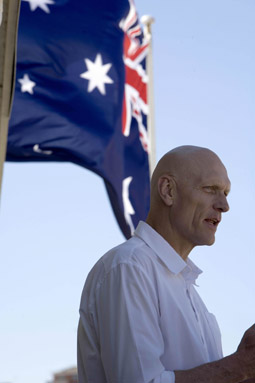
Peter Garrett, Minister for Environment Protection, Heritage and the Arts
WHEN THE RUDD GOVERNMENT WAS ELECTED IN 2007 THE VAST MAJORITY OF ARTISTS IN AUSTRALIA SURELY LOOKED FORWARD TO THE PROSPECT OF PETER GARRETT AS MINISTER FOR THE ARTS, DESPITE THE FORGETTABLE ARTS POLICY THE ALP TOOK INTO THE ELECTION. A RESPECTED, PRACTISING ARTIST AS WELL AS NOTED ACTIVIST FOR THE ENVIRONMENT AND INDIGENOUS RIGHTS—HELL, HE’S ONE OF US!
As we know, Peter Garrett’s time as a minister has been difficult and, for the environmental movement, tainted by the fact that he has had no choice but to publicly peddle the Labor Party line in order to move towards change in the longer term. But his actions in the arts portfolio have been disappointingly sparse. It took until his speech to the National Press Club in October 2009 for any substantial statement about possible reforms to the arts policy vacuum left by the previous government. That speech was clearly delivered by someone who has real passion for the arts. It described some innovations on the agenda, and importantly was not afraid to acknowledge that the national arts funding and institutional structure is in need of a major overhaul.
The speech also announced the opening of a discussion towards a national cultural policy, an idea taken up from the 2020 Summit. The announcement wasn’t widely reported, and I didn’t know of it until stumbling on the notice on the RealTime website over the holiday break. The National Cultural Policy website (http://nationalculturalpolicy.com.au) contains Garrett’s speech as well as a framework document, ten discussion points and access to a comments forum. Submissions to the current phase of the discussion closed February 1. Despite the limited time, plenty of erudite and knowledgeable arts practitioners have had their say in submissions and made very good points. Mine’s number 50 on the list if anyone’s interested, but RealTime has kindly given space for me to summarise my key arguments.
RealTime readers would know all too well that arts and cultural policies in Australia suffer from a range of problems that reflect, on one side, insufficient understanding by policy makers of what is required to sustain new and innovative arts practice, and on the other, insufficient understanding by creative artists of how to make arguments to government that will result in better policy to support new work. In order to improve this current situation, we need to articulate and analyse things differently. The National Cultural Policy discussion offers an opportunity to put new ideas about arts policy on the agenda.
Unfortunately at this stage the discussion is being framed on the basis of cultural rather than arts policy. This presents several problems. The first, as Garrett himself articulated in his speech, is that ‘culture’ is a term that defies simple definition. A fundamental principle of policy design is to be able to define the space in which it operates, but culture is such an open-ended term that it is difficult to draw these necessary boundaries. For example, electronic media conveys a huge proportion of what most Australians would understand as our ‘culture.’ Should a cultural policy therefore encompass our media organisations, including privately owned television stations and newspapers?
A second problem is that the sense of shared values conveyed by the term ‘culture’ will inevitably politicise it. As cultural theorist Graham Turner noted in 1993, it is virtually impossible to discuss cultural policy without ideas of nationalism and a narrative of our cultural history. Peter Garrett claims the ‘culture wars’ are over; I am not so sure. At some future point we will presumably have another conservative government obsessed with settling old scores and politically interfering with the ABC to impose its version of the cultural narrative. Presumably the National Cultural Policy that might emerge could be demolished as was the Keating Government’s visionary Creative Nation. We should therefore, through this policy, seek outcomes that cannot be so easily unmade.
This brings us to the third problem: the relationship of the cultural policy to the arts is very loosely defined on the NCP website. This seems a significant shortcoming, as the primary policy measures and tangible outcomes arising from the national policy will be in the arts. This is all the more unfortunate because the Press Club speech articulated the relationship between arts and culture quite clearly and seems to give each equal weight.
Surely we need a firmer foundation than this as the basis for the relation between culture and the arts, especially given that the primary outcomes of any national cultural policy will be changes to policies and funding for the arts. The legitimacy of funding for new work will always be called into question by a not insignificant minority, especially when they don’t like what is being produced. This inadequate approach to cultural policy, therefore, will inevitably risk politicising matters of arts policy as well.
As Garrett has pointed out, arts funding around Australia, both Commonwealth and State, is largely locked up in supporting a network of arts organisations. Surely it is time for policy that fully recognises that the arts sector and our educational institutions are inextricably linked. No, that’s not strong enough—the arts institutions that are part of our tertiary education sector are the engine room of the arts and cultural sector and should be incorporated fully into any consideration of funding and policy.
While art institutions perform valuable functions and support many artists, the result, as Minister Garrett notes, has been too little money available to support individual artists or to adequately foster new and experimental work. This could clearly be solved by increasing funding to individual artists, although to truly allow freedom to work outside institutional structures we should seriously consider, as many have suggested, tax incentives for artists or individual direct subsidy for professional artists such as has been successful in Europe.
The welfare and ‘public good’ arguments for subsidisation of artists’ incomes is well known. David Throsby and Glenn Withers laid it out in their 1979 work The Economics of the Performing Arts, still the benchmark on this subject, and yet the ability of artists to make a living always seems to be at the very bottom of the pile of topics for discussion. This is a serious omission: surely, the first function of cultural policy is to lay the basis for the creative work to thrive, and to do this we must ensure that artists are able to make an adequate living while making their art. All else flows from this. It may be that there is a limit to the number of artists who can make their primary living as artists. So why not, for once, clearly state these objectives in a cultural policy?
There is a fourth and more difficult problem, which in my view is critical for a national cultural policy to address: how to have an open, credible, non-parochial debate about the network of major artistic institutions, including in our education systems, which considers the equity and efficiency as well as the excellence of such institutions, and that aims towards building capacity to take us forward, both recognising heritage and allowing new work to grow. This cannot be left in the hands of politicians or bureaucrats, and neither can it be left up to the arts establishment alone—they will of course act, first and foremost, to preserve the organisations they work for and the structures they are comfortable with. We also need to have a broadly accepted understanding of how to close institutions and companies when their time is done, to allow new ones to grow, and how to better handle the relationship between state and federal funding and what level of support is needed to maintain the agreed institutional arrangements.
Artistic institutions are subject to the drastic effects of falling below a threshold of ‘critical mass’—policy makers seem oblivious to the fact that a few seemingly small cuts can bring the whole edifice down. When highly respected teaching staff are made redundant at a tertiary arts teaching institution, because the one-on-one teaching model needed to train professional artists is deemed too expensive by university bureaucrats, that city will find (as we have in Canberra) the best students will no longer come.
The National Cultural Policy should articulate clearly what is desirable for Australia as a framework for our arts and cultural industries; it should mandate in perpetuity an overall level of funding for artists and the institutional structure, including arts education that we as a nation wish to maintain from our taxes. The detail can then be left to the peer funding process along with support from the private sector.
Overall, the statements of the Minister and the points of the discussion framework have much to commend them. However, the National Cultural Policy discussion will remain flawed if simply focused on a loose definition of ‘culture.’ We can hope, now that Minister Garrett’s responsibilities have been lightened, that he can give the National Cultural Policy the attention it deserves.
Canberra-based Gavin Findlay wrote in RT93 and RT94 on the challenges for performance and other aspects of the arts in that city.
RealTime issue #96 April-May 2010 pg. 8
© Gavin Findlay; for permission to reproduce apply to realtime@realtimearts.net
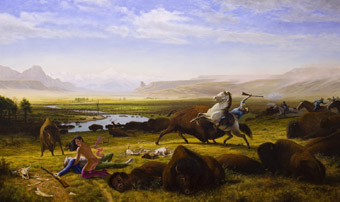
The Death of Adonis, 2009, Kent Monkman, acrylic on canvas
image courtesy the artist and Trepanier Baer Gallery, Calgary
The Death of Adonis, 2009, Kent Monkman, acrylic on canvas
“THE BEAUTY OF DISTANCE: SONGS OF SURVIVAL IN A PRECARIOUS AGE.” IN ITS MELDING OF AESTHETICS, GEOGRAPHY AND POLITICS, THE TITLE OF THIS YEAR’S BIENNALE OF SYDNEY IS OF A PIECE WITH MOST LATE 20TH- AND EARLY 21ST- CENTURY INTERNATIONAL EXHIBITIONS THAT SELF-CONSCIOUSLY DENOTE THEIR STATUS AS NODES IN THE NETWORK OF GLOBALISATION. YET ARGUABLY THERE ARE POINTS OF DISTINCTION, TOO, IN THIS SOMEWHAT INELEGANTLY CRAMMED TITLE.
For one, there are references that can be interpreted as specific to this place, Sydney, Australia, as opposed to those in so many ‘global’ exhibitions that generically invoke ‘place.’ Further, the title explicitly mentions ‘beauty’, long a taboo word in post-conceptual/post-minimal contemporary art discourse. Finally, the allusion to an artform other than the visual—and a predominantly narrative and melodic form that combines the ineffable expressivity of music with the rational capabilities of words—suggests, perhaps, a more ‘folksy’ curatorial approach.
Upon first reading the title, it is hard not to think of the well-known history of Australia by Geoffrey Blainey that coined a phrase now part of common parlance, The Tyranny of Distance. First published in 1966, twice revised (in 1982 and 2001) and continuously reprinted, Blainey’s account of how Australia’s geographical remoteness has been central in shaping its history and identity has become a classic; indeed Blainey’s thesis has been compared to FJ Turner’s explanation of the history of the United States in terms of frontier theory. In updated versions, Blainey argues that even in the age of digital communications, isolation and distance remain vital to Australia’s development.
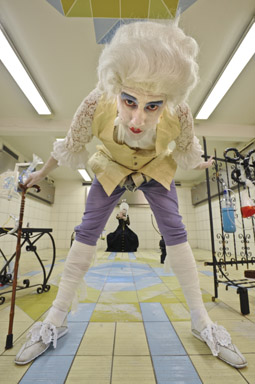
John Bock, Fischgrätenmelkstand kippt ins Höhlengleichnis Refugium, 2008, video, image courtesy of Klosterfelde, Berlin and Anton Kern, New York
photo Jan Windszus © John Bock, all rights reserved
John Bock, Fischgrätenmelkstand kippt ins Höhlengleichnis Refugium, 2008, video, image courtesy of Klosterfelde, Berlin and Anton Kern, New York
In The Death Of Distance (1997)—whose title purposely cites Blainey’s book—British economic journalist Frances Cairncross suggests that the decline in cost, expanding reach and increasing speed of global communications will make distance less important, and constitute the single most influential development in the early 21st century. Cairncross argues that this will likely lead not only to a decline in global conflict, but also to the reinforcement of less widespread languages and cultures, and preservation of cultural heritage. Blainey counters this view, however, by asserting that distance still matters—albeit now measured by the fast second hand of the clock, rather than by the week in the calendar—and that its effects are not always negative. By dint of continuing to be “viewed by the outside world as a billabong standing some distance from the global mainstream” (2001), Australia’s ‘distance’ can “benefit and protect” fragile environments, national security and traditional cultures, for example. This notion of the benefits of distance is developed by Biennale Director David Elliott in his press releases: distance is cast as integral to the differences between cultures, and to the distinction between art and life.
Whether or not David Elliott was aware of Blainey’s book, his opening curatorial gambit pinpoints a key Australian preoccupation, as prevalent in culture and art—recall the early postmodern debates around the ‘provincialism problem’ and the ‘centre-periphery’ dynamic—as in international relations and domestic politics, for example, the ongoing anxiety about Australia’s status as a player on the world stage, or former PM John Howard’s characterisation of Australia as torn between its geography and its history.
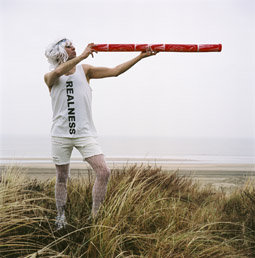
Christian Thompson, Isabella Kept Her Dignity, 2008, C-type print
courtesy the artist and Gallery Gabrielle Pizzi, Melbourne
Christian Thompson, Isabella Kept Her Dignity, 2008, C-type print
Howard’s view of Australia—one that essentially portrays Asian-Australians and Indigenous Australians as outsiders—was ascribed to Blainey himself in the 1980s, following his public expression of doubt about the ability of the Australian public to withstand continuously high levels of Asian migration. Hence to invoke distance (and its ‘tyranny’) in the Australian context is necessarily to invoke both race relations—their painful and contested historical roots and their often troubling contemporary manifestations—and questions that persist about Australia’s identity and agency as a country.
The exhibition appears to take on the specificity of place in a variety of ways. Elliott has selected a relatively large number of Australian artists, both Indigenous and non-indigenous, mid-late and early career. At least two of the indigenous projects appear to have a monumental quality that situates them as exhibition centrepieces: the 110 larraktji (memorial poles or bone coffins) created by 41 Yolngu artists from North Eastern Arnhem Land; and longtime curator and critic Djon Mundine’s permanent memorial to the Eora nation, an engraving of images of Pemulwuy and Bennelong on the rock between the Opera House and the Botanical Gardens.
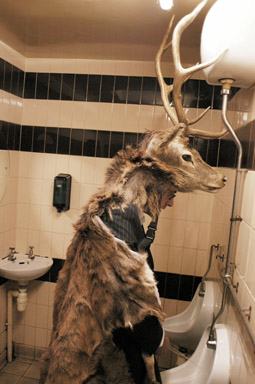
Marcus Coates, Pub Shaman, Lamp Tavern, Birmingham, UK, 2007, produced in association with Insertspace, UK
image courtesy the artist and Workplace Gallery, UK
Marcus Coates, Pub Shaman, Lamp Tavern, Birmingham, UK, 2007, produced in association with Insertspace, UK
Like certain preceding biennales, this one also takes advantage of Sydney’s particular geography, with site-specific works to be installed in spaces around the harbour which are also still strongly redolent of colonialism, such as Cockatoo Island, Pier 2/3 and the Botanical Gardens. In the latter venue, Fiona Hall has again been invited to perform her subtle post-colonial critique. The Australian Aboriginal presence is moreover complemented by the inclusion of a number of important First Nations artists from North America, such as Beau Dick, renowned as a master carver and mask-maker; Dana Claxton, whose performances, videos and installations uncover the history of the Lakota people; Kent Monkman, whose hilarious paintings, photographs and performances imbue the post-colonial gaze with camp; and Annie Pootoogook, whose naïve drawings reveal the bittersweet nature of Inuit daily life.
The explicit recourse to beauty sets the theme apart to some degree from its recent precedents. Redolent of associations with the aesthetic ideals of fascism and bourgeois taste, deemed vacuous and frivolous or distracting of serious purpose, or seen as mere grist for the art market, beauty was for a long time spurned in preference to anti-aesthetic gestures more in keeping with the ugly social reality critical art had in its sights. Yet Elliott does not appear to view beauty as problematic; indeed his definition of beauty in press releases amounts to “a resolution of energy, thought and feeling in aesthetic form”, a view so general that it captures aesthetic, anti-aesthetic and everything in between. In its inclusion of several art world stars, the Biennale will feature artists renowned for their deliberate spurning of positive affect such as Paul McCarthy and the Chapman brothers. Yet the exhibition also includes works whose aesthetic effects can clearly be described as beautiful. Some invoke classical form, such as British Rachel Kneebone’s ceramic sculptures; others evidence intricate craft to critical effect such as in the objects of New Zealand artist Brett Graham or American Angela Ellsworth; others are expertly versed in the beauty of composition and representations of nature, such as the photographs of master Hiroshi Sugimoto, or the paintings of Australian Rosslynd Piggott.
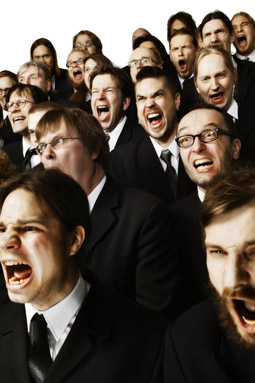
Mieskuoro Huutajat (Shouting Men’s Choir)
photo Timo Heikkala
Mieskuoro Huutajat (Shouting Men’s Choir)
Its third distinctive feature might be the Biennale’s promise to feature music as a key form in a visual arts festival. Elliott was inspired in his choice of subtitle, Songs of Survival, by American ethnomusicologist and experimental filmmaker Harry Everett Smith, who during the 1950s collected, documented and publicised a wide range of American folk music from blues to jazz to gospel, grassroots music that had been lost, forgotten or overlooked by the mainstream, and that represented a very different America to that of the hit parade. Ethnomusicology, like its mother discipline ethnography, of course has its culturally problematic aspects. These are evident in another potential reference in the subtitle, namely the recent album Songs for Survival (2008) complied by Molly Oldfield and Bruce Parry “in support of tribal people.” The producers recorded the music of various indigenous peoples, including the Babongo from Gabon, and then invited professional artists to sample the recordings in original songs. Despite the proceeds flowing to participating indigenous communities, such an undertaking necessarily raises issues of appropriation and cultural exploitation.
The archival impulse at the heart of Smith’s work is echoed in at least two other music projects included in the Biennale, Manchester artists Eileen Simpson and Ben White’s Open Music Archive (OMA), and Australia and New Zealand’s Slave Pianos (Mike Stevenson and Danius Kesminas). OMA aims to “source, digitize and distribute” out of copyright sound recordings now lost to the public through inaccessible media and storage. Slave Pianos, meanwhile, comprises a computer-controlled mechanical piano-player that features the ongoing archive of works of music and noise created by composers who consider themselves primarily visual artists. Along with these documentary-style works, the musical component of the exhibition includes the renowned ‘dark cabaret’ act Tiger Lillies; the Dadaist, Aki Kaurismaki-esque Finnish shouting men’s choir; and the Japanese club sounds of Superdeluxe.
Elliott comes to the Sydney Biennale with many years’ experience as director of flagship contemporary arts organisations, including the Museum of Modern Art in Oxford, Moderna Museet in Stockholm and Japan’s Mori Museum. His vision for Sydney appears to balance tried-and-true practices from previous local Biennales with the now generic expectations of global shows, but perhaps to add a welcome element of site-responsiveness together with a folksy touch of grassroots music and a frisson of beauty.
17th Biennale of Sydney, The Beauty of Distance: Songs of Survival in a Precarious Age, May 12-Aug 1, www.biennaleofsydney.com.au
RealTime issue #96 April-May 2010 pg. 10-11
© Jacqueline Millner; for permission to reproduce apply to realtime@realtimearts.net
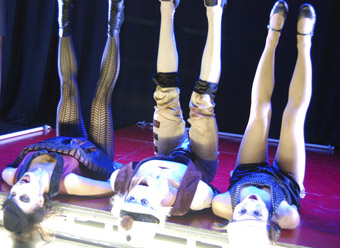
Dancing on Your Grave, a Cholmondeley and Featherstonehaugh’s production
images courtesy PIAF
Dancing on Your Grave, a Cholmondeley and Featherstonehaugh’s production
THE 2010 PERTH INTERNATIONAL ARTS FESTIVAL MAKES NO CLAIM TO THEMATIC COHERENCE AND YET THE FOLLOWING SAMPLING OF PERFORMANCES REVEALS AN ONGOING ARTISTIC CONCERN WITH THE LIMITS OF IDENTITY, WHETHER IN POLITICAL CONTEXTS OR TESTED AGAINST ANIMATE/INANIMATE DETERMINANTS. DEMONSTRATIONS OF SINGULAR IDENTITY CAN SPAWN TENSIONS, OFTEN WITH COMPLEX AND CHILLING REPERCUSSIONS OR, ALTERNATIVELY, CAN FORM UNITIES WHERE COMPLEMENTARY OPPOSITIONS CREATE THE EVENT’S SINGULARITY.
A handful of dead souls who rev up life in a pub of zero intoxication and intone freedom from pancreatic tracts might turn tensions between life and death on their head. Unfortunately, the framing gag of a spectral music-hall with its tight staging, small cast and banjo-strummed ballads sits at odds with the wide-flung technicolour skyline of Perth on a balmy night. How could the imported UK mortuary wit, however clever in its intimacy and comedic lyrics, compete with the external spectacle of nature provided free by the city? In director-choreographer Lea Anderson’s Dancing on Your Grave, the Cholmondeleys (an all-female contemporary dance company) and the Featherstonehaughs (its male equivalent) were in short supply which only emphasised the show’s reliance on Burch and Blake’s original songs delivered live at Beck’s Music Box. Lusciously opening out onto The Esplanade, Beck’s Box lacked the necessary ambience of enclosure, crowds and unruliness to realise the production’s odd Dickensian humour.
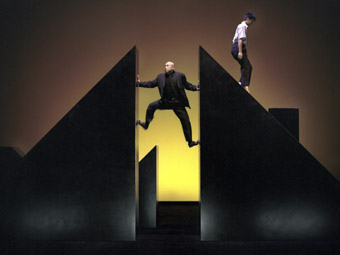
Les Sept Planches de la Ruse (Seven Boards of Skill)
image courtesy PIAF
Les Sept Planches de la Ruse (Seven Boards of Skill)
Les Sept Planches de la Ruse (Seven Boards of Skill), a French Chinese production, conceived by Aurélien Bory with performers from the Dalian Beijing Opera, generated an inverse effect. The Regal, an old, ungainly theatre commonly used for brash commercial productions was transformed by dreamlike kinetic art propelled by the gliding force of mass and numbers. Huge tangram shapes slid, balanced and cohered under the manipulations and escalations of their human partners. The glancing run of these Chinese acrobats wheeled around the space to upturn triangular mountains and, in the next breath, curled exquisite song and sound through sculptural corridors. Meditative and poetic, the union of landscape and human stirred interpretation. There was a gecko-like trail of humans scaling the block-face in coordinated angles, like Escher’s lizards endlessly advancing towards metamorphosis together with unframed moments of suspension, wherein a single human teeter-boarded a triangular block on its apex, hovering before the configuration tilts and slides into a new wedged form. Awareness of the difficulty for both human and the blocked shape evaporated with the skilful resolution of topological movement and the slightness of its human counterparts in a continuum of unity.
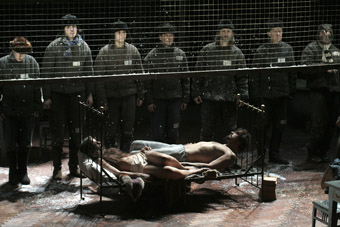
Life and Fate, Maly Drama Theatre, St Petersburg
image courtesy PIAF
Life and Fate, Maly Drama Theatre, St Petersburg
In contrast, Life and Fate describes the will of nuclear scientist, Shtrum, to survive with the credibility of his ideas intact in spite of the destruction of society wielding its incomprehensible power around him. The play is based on the novel by Vasily Grossman, adapted and staged by Lev Dodin and the Maly Drama Theatre. Leaving aside the difficulties of subtitles in an understandably wordy text and the stereotypical overpopulation of sweeping Russian novels, Life and Fate extricated a bitter blend of condemnation and compassion for the acrobatic propensity of the human conscience within the debris of its set. The horror of entrapment in hydra-armed fear is particular to a revolutionary culture brought to its knees by failed aspirations and unvanquished enemies, within and beyond. An Australian audience probably trip-wires over circumstances in everyday Soviet life where Holocaust and Gulag retribution threaten in equal measure and yet this production, given the stamina of the audience to hold out for its three-plus hours of plot unravelling, does register familiar stings of small lies and self-deception.
The Maly actors skilfully inhabit a stage conflated in time and location, which is at once pre- and post-Stalinist apartment crossed by the symbolic wires of encampment and annihilation. Both life and vodka are cheap and drained in a moment. The significance of this state becomes increasingly clear in the second half which culminates in the barbed belittlement of a band of denuded humanity literally playing the final chords of their condemned lives. It is an extraordinary moment wherein music and bare flesh fuse and are extinguished. The echo of that poignancy-crushed-in-violence emanates through the mother’s final letter just before she too leaves life to her son and his conscience.
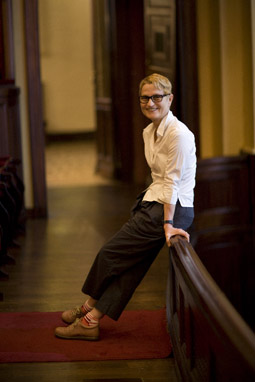
Robyn Orlin
photo Olivier Pascaud
Robyn Orlin
Meeting Robyn Orlin, a South African choreographer working between Paris, Berlin and Johannesburg, represents another step in STRUT’s workshop series aimed at informing locals about international trends and extending vistas about what dance might be. In amongst the polished performances of the Perth Festival, this showing at the Kings Street Arts Centre was unashamedly chaos-in-progress. Selected guests entered unawares into a mayhem of fancy-dress and scattered paraphernalia, plied by questions and demands for dollars. The obtuse play seemed cranked towards ordering, via a projected Skype, a sharing loaves-and-fishes-style of one ‘veg’ and one ‘non-veg’ wrap. Division appeared to be an Orlin strategy for creating material as well as a thematic probe into discrimination by replacing race with arbitrary characteristics like vegetarianism. It was a flippant glimpse into what might materialise in the future as a complement to the Russian Life and Fate.
Good Morning, Mr Gershwin presented by Compagnie Montalvo-Hervieu from France, rapped nostalgia into explosive exuberance and rhythmical virtuosity. “I got rhythm” speed-splintered through every conceivable nook and cranny of the body, bouncing across dance techniques and spatial configurations like nerve-ends in frenzied delight. Fusion was further promoted in the cast mix of African, Arabic, Asian and European performers and the final Porgy and Bess sequence. While possibly paying too much credence to Gershwin’s political tolerance, Porgy provoked powerful performances from the women whose anguish shuddered bodily, banishing all vestiges of feminine frailty. In overview, playfulness flipped with desire and protest in the same way that Gershwin may have skittered across the piano’s black and white keys. The message resoundingly unified divisive fragments into melodies that are difficult to resist.
Death images struck down by mere humans who refuse to doubt the immortality of song linger after the festival and the orchestrated harmonies of its performances. Perhaps that is what any festival should achieve, an impossible celebration against the odds.
2010 Perth International Arts Festival: The Cholmondeleys and The Featherstonehaughs, Dancing on Your Grave, director, choreographer Lea Anderson, Beck’s Music Box, Feb 23, 24; Les Sept Planches de la Ruse, conception, stage designer, director Aurélien Bory, producers Compagnie 111m Scènes de la Terre, performers Dalian Beijing Opera, Regal Theatre, Feb 5-March 1; Maly Drama Theatre, St Petersburg, Life and Fate, based on the novel by Vasily Grossman, adaptation, direction Lev Dodin, His Majesty’s Theatre, Feb 17–23; Strut, Meet Robyn Orlin, facilitator Bianca Martin, Kings St Arts Centre, Feb 26; Compagnie Montalvo-Hervieu, Good Morning, Mr Gershwin, choreography José Montalvom Dominique Hervieu, music George Gershwin, His Majesty’s Theatre, Feb 26-28
For more on the Perth International Arts Festival see the review of Victoria Vesna and James Gimzewski’s Nanomandala on page 24.
RealTime issue #96 April-May 2010 pg. 12
© Maggi Phillips; for permission to reproduce apply to realtime@realtimearts.net
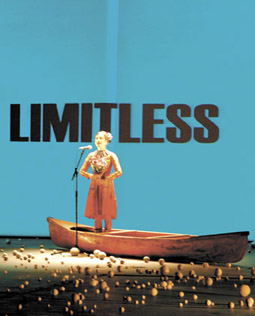
Willoh S Weiland, Yelling at the Stars
photo Tilly Morris
Willoh S Weiland, Yelling at the Stars
new aphids artistic director: willoh s weiland
Exciting news from Melbourne: Willoh S Weiland has been appointed as the new artistic director of Aphids. As we were putting this online edition together, Wieland was flying back to Australia. We look forward to catching up with her once she’s settled into the job of guiding one of the country’s most innovative outfits, renowned for its idiosyncratic hybrid creations and international collaborations.
A young and energetic artist, Weiland looks made for Aphids. Her projects as artist, writer and curator over recent years have been strikingly individual. The ongoing art-science project Yelling at Stars (RT 88, p27) was presented at the Sidney Myer Music Bowl as the closing event of the 2008 Next Wave Festival and then in Glasgow at Less Remote, an art/science symposium running parallel to the 59th International Astronautical Congress. Her 2009 Synapse residency was at the Centre for Astrophysics and Supercomputing, Swinburne University of Technology, where she developed Void Love (www.voidlove.tv), “a soap opera about astrophysics” starring Kamahl. Weiland is involved in ongoing collaborations with Spat & Loogie and, as part of Deadpan, with video artist Martyn Coutts—including an Asialink residency in Beijing and NES artist residency in Iceland in 2010.
David Young, the outgoing artistic director and co-founder of Aphids (and now director of Chamber Made Opera; RT 95, p50) sees Weiland as “hugely talented and a perfect fit with the Aphids spirit and ethos.” He thinks that with the current Aphids team, “I really cannot imagine what Aphids will become under her watch—and that’s exactly what I am most excited about.” RT
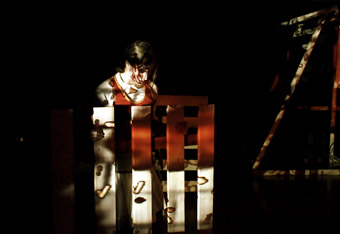
Pomona Road, photo Katrina Lazaroff
katrina lazaroff’s pomona road, inspace
Major bushfires bring increased pain each year and revive memories of earlier devastating fires cruelly etched in the psyches of many Australian families. Choreographer Katrina Lazaroff’s family is one of these: her first full-length dance work, Pomona Road, reflects on the enduring physical and emotional consequences of the Ash Wednesday bushfire in 1980, but in the end, says Lazaroff, it’s a dance theatre work about family.
Lazaroff is a dancer, choreographer, rehearsal director and dance educator who graduated with an Honours in Dance from WAAPA (Western Australian Academy of Performing Arts) in 2001, performed with Buzz Dance Theatre in Perth in 2001, and in 2006 and 2008 with Leigh Warren & Dancers worked as rehearsal director and assistant to the choreographer. She has been Artistic Director of the Youth Dance Festival 2008 (Ausdance ACT), choreographed for Fresh Bred—SA Youth Dance Ensemble, and worked with Restless Dance Company as a choreographic mentor on Debut 1 & 2. She is currently working as a choreographer and performer with Adelaide’s Patch Theatre Company and teaches company class for Australian Dance Theatre. For Lazaroff, the hour-long Pomona Road is “a huge work”, an opportunity to create a totality that draws on her artistic experience and family life and allows her to embrace a wide range of means with which to realise her vision.
In Pomona Road Lazaroff employs dance, theatre and visual and audio design to evoke the enduring suffering, the rebuildling of lives and a sense of home. Unusually for a principally dance work, she also incorporates documentary material—recorded interviews from family and community members. Not surprisingly then the show’s press release declares it “new Australian documentary dance.” Certainly Lucy Guerin’s Structure and Sadness is rooted in the reality of the 1983 collapse of Melbourne’s Westgate Bridge, but it’s not a documentary work per se. Bangarra Dance Theatre, on the other hand, has works in its repertoire based on painful social realities, but the label ‘documentary’ is not apt.
Lazaroff tells me that Pomona Road—in evolution since 2006 and with three stages of development—was never intended as a comment specifically on the social and emotional impact of bushfires. Her first impulse was to explore family, “where we come from.” Stage one addressed her relationship with her sister (“sibling rivalry, kooky and a bit sinister”), and stage two, father-son interaction (drawing on her own family and the experience of her dancers). It was while working on stage three and addressing the whole family that she discovered that the fire experience provided a meaningful framework for the exploration of family life. The Ash Wednesday starting point offered the beginnings “of a journey and a focus on loss—of home, place, identity. And the pain of starting again—the parents tackling it, the kids bumping along.” By 2009, says Lazaroff, the fire scenario had taken over.
Lazaroff decided that she wanted to make a dance work that was documentary in character, capturing the feelings of loss to fire. To this end she interviewed her parents about Ash Wednesday 1980 and victims of the subsequent 1983 Ash Wednesday. She thinks that “feelings and relationships can be sensed” through these voices which the audience hear—sometimes on their own, sometimes in tandem with the dance. The dancers, playing members of a family, also speak, but not in a conventionally scripted fashion, their utterances a form of vocal movement—family bickering, a song, familiar expressions. Lazaroff says that in stage three of the work’s development she learned to give space to the recorded voiceovers, “to let them come first, and provide continuity.”
Asked about her choreographic style, Lazaroff says it’s rooted in the contemporay dance which has been her life. However, the dancers create “recognisable characters whose gestures and character traits fuse fluidly with the dance language.”
Kerry Reid’s set for Pomona Road comprises simple timber structures (originally made by Lazaroff’s partner from materials from her mother’s verandah for the stage three development, but now re-made and evocative of her father and his fence contracting business) and large hanging sheets of white paper that receive the images from two powerful projectors washing the whole stage with impressionistic, ‘textural images of bush and fire.” With Nick Mollison’s lighting and projections, Lazaroff hopes that substantial depth of field will be created. Lazaroff describes the sound design for Pomona Road as “highly collaborative, with a lot of give and take” in its making with Sascha Budimski’s score comprising “sound effects, hums, drones, voiceovers, rhythm beats and Gerry Rafferty’s Baker Street”, the 1978 hit which her father played frequently.
I ask Lazaroff what creating Pomona Road has done for her. “It’s been a moving experience, looking back into family history and seeing that there were many more things that happened to us than I realised. As an artist I feel it’s set me free.” inSPACE Program, Pomona Road, Space Theatre, Adelaide Festival Centre, April 21-24. Pomona Road was part of inSPACE:development in 2009.
jo lloyd: 24hrs
God knows what all the fast turnaround short film and short play festivals are doing to our psyches as artists and audiences—blessed be the slow food movement—and now dance has joined the rush! But what an intriguing race it might be in the Jo Lloyd-curated 24HRS at Dancehouse. Four choreographers will each create a new work over 24 hours—one for each Friday over four weeks. Just to add to the inevitable delirium of commencing work on a Thursday night at 9pm, “the creative process will be twittered and streamed online and the teams must be ready to present the work to a live audience by 8pm the next night.” There goes the privacy associated with the slow boil of the creative process. The stellar line-up of choreographic speed freaks is Natalie Cursio, Shelley Lasica, Phillip Adams and Luke George. 24HRS, performances April 30 (Cursio), May 7 (Lasica), 14 (Adams), 21 (George), Dancehouse, Melbourne; www.twitter.com/24HOURS; www.livestream.com/24HOURS
tony yap, rasa sayang
Rasa Sayang is a new interdisciplinary performance work by leading Melbourne dancer Tony Yap with musician-composers Tim Humphrey and Madeleine Flynn, visual artist Naomi Ota and creative collaborator Ben Rogan. The work is based on research Yap conducted while on a Fellowship from the Australia Council Dance Board into Indonesian and Malaysian shamanistic and trance dance traditions. Sayang, meaning ‘love’ in Yap’s native Malaysian, is the name of his mother, the inspiration for the work which forms part of his Buddha Body Series, an investigation into the positive eastern idea of emptiness. The first in the series, Melangkori (‘melancholy’) was shown in Melbourne in 2009, and the film version has screened in festivals around the world. Since 2008 the Tony Yap Company has performed in Indonesia, China, Vietnam, Japan, Malaysia and Korea. The Rasa Sayang installation is open free of charge 6pm-7.30pm each night, when audience members are invited to witness the preparations and pre-performance rituals of the artists. Fortyfivedownstairs, 8pm April 22-25; fortyfivedownstairs.com
craig walsh: digital odyssey
Sydney’s MCA is collaborating with leading Australian media artist Craig Walsh on Digital Odyssey, an epic 2010-11 tour to present digital artworks in response to regional environments and communities. Walsh “is travelling in a self-contained, digitally-equipped motor home which is also his mobile living and working environment, designed and fitted with all the necessary technical and AV equipment.” Walsh’s astonishing projections have filled shop windows with water, fish and floating furniture and the Art Gallery of NSW foyer ceiling with giant cockroaches, while elsewhere he has given a tree a human face. Digital Odyssey allows him to create site specific public artworks in collaboration with communities across Australia. Watch out for Walsh at Murray Bridge, SA, to April 11; Alice Springs, NT, April 26-May 16; Winton, QLD, May 31-June 20; Cairns, QLD, June 28–July 18; Mackay, QLD, Aug 16-Sept 12; Gladstone, QLD, Sept 20-Oct 10; Gerringong, NSW, Nov 1-30; Ballarat, VIC, Dec 6-Jan 6; www.digitalodyssey.com.au
RealTime issue #96 April-May 2010 pg. 14
© RealTime ; for permission to reproduce apply to realtime@realtimearts.net
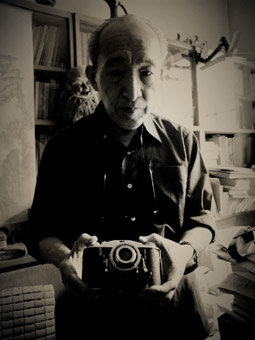
Wang Jingyao, husband of Bian Zhongyun, with the camera he used to photograph his wife’s body in 1966 after she was murdered by Red Guards, in Hu Jie’s documentary Though I Am Gone (2006)
WHILE CHINA’S POLITICAL SYSTEM REMAINS DEEPLY AUTHORITARIAN, THE COUNTRY’S OVERWHELMING SIZE AND EXPLOSIVE GROWTH HAVE OPENED CAVERNOUS GAPS IN THE GOVERNMENT’S CONTROL OF CULTURE, THROUGH WHICH A NEW GENERATION OF DV-WIELDING DOCUMENTARY FILMMAKERS HAS CLIMBED.
“I’ve never heard an independent filmmaker in China ask themselves, ‘Can I do this?’,” comments Hong Kong-based producer David Bandurski. “Independent filmmaking is the freest avenue of expression that exists in China today.”
Independence from state-sanctioned channels of film production is the defining characteristic of a movement that encompasses a diverse array of styles and subject matter. “There were two things that made the change,” explains Beijing-based curator and filmmaker Ou Ning. “The first was pirate DVDs. People didn’t need to go to the Beijing Film Academy—they saw a lot of films through pirate DVDs, which gave them a very rich film history. When people saw this history they wanted to make things themselves, and they found there were cheap cameras that had come out. This technology has had a great impact on filmmaking in China.”
contemporary complexities
One of the most salient features of the shift in Chinese documentary filmmaking is the democratisation of the way contemporary reality is depicted on screen. “Before, history only had one version—by the Chinese Communist Party,” asserts Ou Ning. “Now with digital technology history has different versions.”
This trend is graphically illustrated by Meishi Street (2006), Ou Ning’s feature-length documentary depicting the plight of Beijing residents forcibly relocated from Dazhalan, an area just south of Tiananmen Square, in the lead-up to the 2008 Olympics. What begins as an observational work takes a fascinating turn when Ou Ning hands his camera to Zhang Jinli, an eccentric and outspoken restaurateur whose home and business are slated for demolition. From that point, Meishi Street becomes, in part, a film about the way digital technology is empowering ordinary Chinese citizens.
“After just one month I found he was not only shooting, but also narrating his story like a journalist,” recalls Ou Ning. “The most exciting thing for him was an occasion when he hung banners on the roof of his house. The police came to take down the banners…but when he put the camera on them they were very afraid…That made Zhang Jinli realise the camera is a weapon.”
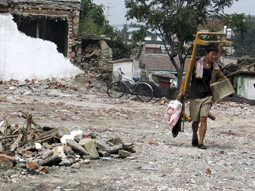
The demolition of Dazhalan, a neighbourhood just south of Tiananmen Square and one of the oldest parts of Beijing, in Ou Ning's documentary Meishi Street (2006)
While Meishi Street depicts a small, if depressingly common drama of contemporary China, Du Haibin’s 1428 (2009) takes on a much larger subject. The devastating Sichuan earthquake of 2008 was the first domestic disaster of such magnitude since digital cameras had become readily available on the Chinese mainland. In the chaotic weeks following the quake, several independent filmmakers joined the uncontrolled flood of media personnel pouring into the disaster zone.
1428—named after the exact moment the quake struck on May 12—takes a cinema-verite approach, documenting as well as participating in the heartbreaking scenes playing out in Beichuan, a ruined town near the quake’s epicentre. The film reveals a complex, if at times overly disparate picture of overwhelming grief, graft, solidarity and merciless self-interest among the survivors, a far cry from the self-congratulatory tone of official Chinese media coverage at the time.
The gulf between China’s official media and independent documentaries like 1428 is most tellingly revealed in two scenes that bookend the film. Early on we see soldiers preventing villagers from entering Beichuan when a leader—probably Premier Wen Jiabao—visits the town, surrounded by a media circus. Towards the end of the film, Wen Jiabao returns to the area and an old man bitterly complains about the massive police and military presence preceding his arrival. A younger woman watching the scene remarks, “If you tell the truth, they’ll cut your words from the film.” But this is not state-controlled television, and the old man’s words remain.
the return of history
China’s digital filmmakers are not just claiming their right to document contemporary reality—they are also delving into repressed episodes from the nation’s recent past. Nanjing-based director Hu Jie is the most notable filmmaker working in this area, having produced two extraordinary works detailing stories from the first decades of the People’s Republic (unfortunately no subtitled version yet exists of a third film completed in 2008, National East Wind Farm).
In Search of Lin Zhao’s Soul (2004) looks at the life of a young writer through interviews with those who knew her. Initially an ardent supporter of the Communist revolution, Lin Zhao ran foul of authorities when she defended fellow Peking University students denounced during the Anti-Rightist campaign of 1957. She was expelled from the university and suffered various other indignities, which only hardened her resolve to speak out. She was imprisoned in 1960, but fought attempts to stifle her writing by penning an estimated 120,000 words of poetry and essays while in jail, using her own blood. In 1968 she was executed by firing squad.
Hu Jie stumbled upon Lin Zhao’s story by chance when working as a cameraman for China’s state news agency Xinhua. “I knew very little about the history of the 1950s and 60s,” the filmmaker explains. “While making Lin Zhao I had the sense that I was feeling around in the dark. Then I found the door of history, opened it and walked through. There I found a lot of ridiculous, cruel stories that really shocked me, and that was the motivation to go further.”
Hu’s next work focused on Bian Zhongyun, who in 1966 was the deputy headmistress of a prominent Beijing girls’ high school attended by many daughters of the party elite. The school was an early incubator of the Red Guard movement that spearheaded Mao’s Cultural Revolution from mid-1966, and on August 5 that year, Bian Zhongyun was beaten to death by her students and dumped in a rubbish cart. The incident marked her as one of the first victims of the revolutionary violence that within months would engulf the entire nation.
Bian’s elderly husband still lives in Beijing, and through the scholar Wang Youqin, Hu Jie discovered that he had secretly photographed the events leading up to his wife’s death and her brutally mauled body. It took six months of persuasion and a viewing of the Lin Zhao film to convince Bian’s traumatised husband to share his story and images with Hu Jie. These interviews and his photographs form the backbone of Though I Am Gone (2006), a profoundly moving memorial to the victims of Mao’s senseless political violence.
Hu Jie’s films are striking not only for the stories they reveal—horrific even by the grim standards of Chinese history—but also for the way they individualise events that have long remained broad, abstract historical episodes for want of recorded eye-witness accounts. More than this, Hu Jie makes these stories tangible. The climactic scene in both In Search of Lin Zhao’s Soul and Though I Am Gone sees the filmmaker uncovering physical traces of the long forgotten victims.
While making the Lin Zhao film, Hu Jie discovered the young woman’s ashes were stored in an unsealed box in Shanghai. Locating the box, he lifts the lid on camera, and finds wrapped in a newspaper of the 1960s a thick lock of Lin Zhao’s hair, turned prematurely grey by the tortures she endured. The final scene of Though I Am Gone sees Bian Zhongyun’s husband bring out a suitcase, unopened since 1966, containing the bloodied clothing he removed from Bian’s corpse the day she was murdered. These moldering objects, so carefully hidden for decades, insist with heartbreaking melancholy that we remember this history, and the injustices perpetrated in the name of Mao’s ideology.
a history unseen
China’s flourishing independent documentary sector illustrates how much the country has changed since the imprisoned Lin Zhao was compelled to pen essays in her own blood.
The fate of these films, however, reveals how little the Communist Party’s attitude has shifted when it comes to questions of culture. As David Bandurski explains, “[These films’ existence] is not at all a reflection of government tolerance. These works emerge from the chaos and uncertainty of a China in the midst of social transition. The chaos can offer opportunities for conscientious filmmakers…[but] control of all culture remains a top priority for China’s leadership.”
While controlling expression is increasingly difficult, the Chinese government is much more successful at limiting the dissemination of unsanctioned views. China’s independent documentaries are occasionally seen in small unofficial venues in major cities or on university campuses while informal networks of DVD distribution exist amongst artists, academics and activists. Generally, however, it is extremely difficult for these films to reach domestic audiences. Broadcast, official distribution or appearances at recognised film festivals within mainland China are out of the question. So although these films offer a tantalisingly uncensored vision of a country in flux, they also remain victims of the CCP’s obsessive desire to control the nation’s culture.
David Bandurski produced Zhao Dayong’s Ghost Town (RT94), available through dgenerate Films (http://dgeneratefilms.com). Ou Ning’s Meishi Street is available for online rental through the dgenerate Films website.
Hu Jie’s Though I Am Gone can be found in 10 parts with English subtitles on YouTube. In Search of Lin Zhao’s Soul is similarly available on YouTube, but unfortunately without English subtitles.
RealTime issue #96 April-May 2010 pg. 15
© Dan Edwards; for permission to reproduce apply to realtime@realtimearts.net
OVER AT LEAST THE LAST 50 YEARS ONE CONTINUING AIM OF THE AUSTRALIAN FILM COMMUNITY HAS BEEN THE DEVELOPMENT OF A LOCAL SCREEN CULTURE (EARLIER, ‘FILM CULTURE’), SOMETHING THAT WOULD, AMONGST MANY OTHER THINGS, EVENTUALLY INCREASE AUDIENCES FOR AUSTRALIAN FILMS. IT’S AN AIM, HOWEVER, THAT HAS OFTEN BEEN RATHER NEBULOUS AND UNFORMULATED, AND AS A GOAL IT’S RARELY COME EVEN CLOSE TO BEING MET.
So what is screen culture, anyway? Over those years, it has been defined in many and various ways: as the comprehensive nature of screen activity outside the mainstream; as the environment in which screen projects are developed, made, viewed, discussed and appreciated; even, in one lobbying foray, as “the glue that holds the industry together.” The importance of screen culture within the film industry, and within the wider film community, has ebbed and flowed, and the support it has been given, both financial and in kind, has similarly grown or, more often, decreased.
Back in the 1980s and 90s screen culture was actually high on the agenda; funding bodies held forums to define it and determine what their assistance to it should be, while the many and varied organisations and individuals who believed they had a role within a healthy screen cultural sector took part in many enthusiastic debates at festivals and other film events. Lobbying bodies with high-flown names were formed when needed to press the case for support. But, as more immediate issues relating to production, funding and government assistance took priority, screen culture receded as a topic, and has never really regained attention. Today, amongst the often ill-informed debates about the quality of Australian films and why they are not reaching audiences, a serious look at the importance of screen culture in this equation is conspicuous by its absence.
australian film institute
In 1958 a group of film lovers already involved in the early years of the Melbourne Film Festival set up a separate organisation to operate year-round. Aware of similar activities already being carried out in the UK by the British Film Institute, they called this local organisation the Australian Film Institute, and based its constitution on that of its role model. The AFI has now survived for an eventful 50 years, the only screen cultural body (apart from the Sydney and Melbourne film festivals) to do so, but just how secure is its continuing role in the cultural life of Australia’s screen community?
The AFI’s first 50 years have been captured in a book, Shining a Light, by Lisa French and Mark Poole, a relatively straightforward chronological history of the organisation which also records an interesting and diverse range of impressions and opinion on the events along the way. It does contain a very interesting and comprehensive chapter on screen culture, which, the writers contend, is where “the AFI’s pursuits over six decades have centred…this is arguably the AFI’s raison d’être.” Using many sources, articles and interviews, they have compiled a concise but substantial portrait of screen culture, concluding with an idea of what it could have been—and still could be. They define screen culture as including production, distribution and exhibition, but also “critical commentary, educational, promotional, lobbying and other discourses and contexts for the reception of screen products”; it’s “located within government bodies, institutions, film service organisations, industry guilds and associations, as well as those processes, audience engagements and discourses that encompass a film community.”
For them, the AFI’s survival for more than half a century promoting “the growth of a diverse film culture” is a “remarkable achievement, given its non-government structure and its membership base”; and they argue that Australian screen culture and the AFI are “clearly inseparable”, something I find hard to agree with. In fact, it’s the AFI’s role in the demise of several important screen cultural initiatives that the organisation has been most criticised for over the years.
the film society movement
The aspect of screen culture that most people recognise and desire is related to exhibition, to enjoying films that they normally wouldn’t get to see. While in recent years digital technology has made it possible to see an enormous range of restored, rediscovered or just very obscure titles on DVD or through digital download, there’s still that innate desire in most film lovers to see films on the big screen, in the dark, surrounded by friends, acquaintances and fellow film lovers. And while film festivals and other events go some way to satisfying this desire, the dream of a national screening circuit offering, year round, a rich and diverse range of curated programs, retrospectives, other national cinemas, all presented within a contextual perspective, is still on the agenda, despite many disappointments.
This sort of specialised exhibition has long been a major aim for local screen culture. The rapid expansion of the film society movement in the 50s, which coincided with a rise in university film groups and was followed by the early underground and surf film screenings in the 60s and the so-called film renaissance of the 70s, saw in many cases the emergence of new filmmakers from backgrounds involved with such showings. This led to an oft-repeated argument that the exposure to such screenings would not only lead to more informed filmmakers, but to larger and more appreciative audiences; as such it was often put to government funding bodies. And to be fair, there were some short, glorious periods when it actually existed.
the national film theatre of australia
The National Film Theatre of Australia was founded in 1967, and grew rapidly in the 70s, gaining a national membership of over 9,000. Run by an extensive network of volunteers and a small but enthusiastic staff, it managed to screen a wide-ranging and well-curated program of films all round the country for a number of years, including some wonderful imported seasons. However, even as it acquired some funding support from the Australian Film Commission, this led to its demise; the AFC, which was already funding the AFI to provide specialised exhibition (which it had done, but in a much less organised and inclusive way), brought about what was originally portrayed as a merger of the two bodies in 1979. However, the NFTA was swallowed up by the AFI, and while its programming continued under the AFI’s banner for a while, it soon disappeared entirely, leading to some long-held bitterness.
the melbourne & national cinematheques
In many of the lively debates about film culture in the 70s and early 80s there had been much talk about a national cinematheque, especially after the demise of the NFTA. The argument was that not only would audiences profit from such screenings, but that filmmakers and film students could benefit from being exposed to such a rich diversity of filmmaking practice, with the Melbourne Cinematheque, which had been running an admired annual program of screenings put forward as a model. Commencing as the Melbourne University Film Society (MUFS) in 1948, and changing to the Cinémathèque in 1984, this self-administered, non-profit, membership-driven group of committed cinephiles, determined to screen films as closely as possible to the way they would have originally screened (big screen, 16 and 35mm prints), every year programs a diverse selection of classic and contemporary films, curated retrospectives and thematic series, using both archival and new prints sourced from all around the world. In the late 80s the AFI proposed that it take the Melbourne Cinematheque program to Sydney’s Chauvel Cinema, and in 1993 this became the National Cinematheque, screening around Australia at a circuit of cinemas including the Media Resource Centre in Adelaide and the Film and TV Institute in Fremantle, with the support of the AFC. However, when the AFC told the AFI in 1999 that it would no longer fund its distribution, research and information activities, it offered additional funding for exhibition, which kept the national cinematheque going for a few more years, until it petered out.
It’s not all doom and gloom, however. The Melbourne Cinematheque still runs a very full and enticing calendar, and screens at the excellently resourced ACMI, which has its own interesting program. The MRC in Adelaide curates a solid annual cinematheque program, as does the exciting and relatively new Arc cinema at the National Film and Sound Archive in Canberra. Sydney’s not totally without alternative screenings: the NSW Art Gallery runs an imaginative program of free screenings allied to its exhibitions; the WEA struggles on screening to a small but very committed audience every second Sunday; and the Japan Foundation, weekly for most of the year, shows a fairly eclectic range of current and archival Japanese films.
goma’s australian cinematheque
But the jewel in the crown is the Australian Cinematheque, located at the Queensland Gallery of Modern Art, which presents an incredibly rich program of retrospective and thematic films showcasing the work of influential filmmakers and artists. It has two state of the art cinemas, together with a dedicated gallery for screen-related exhibitions and facilities for video production, and could well provide a reason for travelling north.
how to do screen culture: aftrs
Given the current lack of focus on screen culture, it’s exciting that the Australian Film, TV and Radio School is now offering a Graduate Certificate in Screen Culture. The course has just started this year, and is aimed at people who are interested in engaging with ideas, in broadening their knowledge and understanding of screen production practice, history and culture, and in contributing to the shaping of a local screen culture. AFTRS hopes to develop students to function in a range of roles, as critics, commentators, dramaturgs, festival directors, teachers, administrators or project officers, and hopes that people already working in the industry could join the course, learning how to build their community and expand their network of contacts and ideas.
It’s refreshing that AFTRS, which has usually favoured the professional and the technical in its teaching, is offering such a course; run from the Screen Studies Department, where department head Karen Pearlman is hoping “to create a community of well-informed and actively engaged people with an interest in developing and influencing the direction of our screen culture, including production, exhibition and distribution, audiences, experiences, ideas and the level of discourse about what we make, why we make it and who it is for.” She believes that screen culture not only helps Australian films find their audience, but also helps Australian cinema find out where it fits in the wider film world.
Alongside Jack Sargeant’s article on Australian genre films [RT95] , Mike Walsh on Asian film in Australia [p17] and Thomas Redwood’s account of the new Mediatheque based at ACMI [p19], this article is part of an ongoing OnScreen series addressing Australian screen culture.
RealTime issue #96 April-May 2010 pg. 16
© Tina Kaufman; for permission to reproduce apply to realtime@realtimearts.net
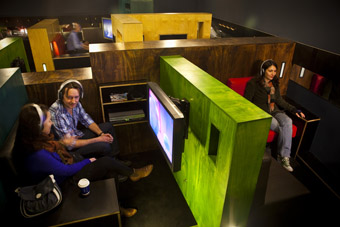
ACMI Mediatheque, photo courtesy of Australian Centre for the Moving Image
MELBOURNE’S RECENTLY OPENED MEDIATHEQUE (LOCATED AT THE AUSTRALIAN CENTRE FOR THE MOVING IMAGE) IS THE FIRST ESTABLISHMENT OF ITS KIND IN AUSTRALIA. IT WON’T, I EXPECT, BE THE LAST. OPENED IN SEPTEMBER LAST YEAR, IT’S A FREE AND VERY WELCOMING PUBLIC RESOURCE FACILITY DESIGNED WITH A CONSPICUOUSLY CLEAR PURPOSE IN MIND.
Collections Manager Nick Richardson says it’s a “shopfront” for the nation’s two largest archive collections. A collaboration between the state funded ACMI and the federally funded National Film and Sound Archive, the Mediatheque provides unprecedented access and assistance for anyone interested in viewing archival material from both collections.
To walk inside the Mediatheque is to get the feeling that an intelligent idea is at work in Melbourne’s home for screen culture. Laid out in a cosy but not restrictive space, the centre incorporates 11 very comfortable booths (each seating two to five people, some with universal access), a research desk area and an adjoining room with a 35mm/16mm flatbed Steinbeck for celluloid viewing. Each booth is equipped with a 42” or 32” digital touch screen television, a dual format VHS/DVD player and multiple headphones. With assistance from the collection desk (located at the Mediatheque’s entrance) visitors can access and view any of the 35,000 DVD or VHS films stored on site. To view celluloid archives (none of which are stored on site), visitors place a request with the centre’s retrieval service which can take between one day (for film kept in Melbourne) and 10 days (for film in the NFSA’s Canberra collection).
For the specialist researcher, postgraduate student or film aficionado, the Mediatheque could hardly present more desirable facilities. Using the online catalogue, a researcher can easily locate relevant materials and order them through the Mediatheque staff (by phone or email) for viewing at the centre. If your needs are less clear—you know what you want, but don’t know how to find it or even what the film is called—the centre’s experienced archival staff are more than able to assist. Nick Richardson is immensely proud of his team’s wide-ranging knowledge and abilities. “The value of the Mediatheque,” he emphasises, “is as much the expertise of the staff as the breadth of the collection.” He was very pleased to tell me of many instances when, on the basis of only a few snippets of contextual detail, he and other members of staff have quickly located the film in question. By continually developing the collection’s catalogue in response to these experiences, the Mediatheque team is establishing multiple categories under which any given film is listed, providing different access pathways for different users.
Catering so efficiently to the particular interests of film specialists is, however, not the Mediatheque’s only intended function. The centre also offers much for the wider public. This is perhaps what most markedly distinguishes the Mediatheque as an access and viewing space from conventional archival spaces: it makes a previously exclusive domain more public and inclusive. For so long the dominion of blurry-eyed film initiates, archival collections have now been placed above ground, in the visible world. For the many visitors to Federation Square, for school students, or for those less experienced university students who are only beginning to appreciate the educational possibilities of archival footage, the centre’s digitised collection offers a user-friendly interactive introduction to the historical universe of the ACMI and NFSA archives. Drifting into the archival space, perhaps out of curiosity from a nearby cafe, the visitor can sit down and immediately begin to interact with the touch screen digital collection (which is continuously being added to as more of the archives are digitised).
Richardson has noticed a recurring pattern in such fortuitous unplanned visits. Typically, he told me, the first-time visitor will begin by watching something familiar and comfortable (like Queen Elizabeth’s 1958 visit to Melbourne, or the first episode of Neighbours, or the “Up There Cazaly” commercial). Ten minutes later, however, they have usually moved from the well-known material to engage in something far less familiar, and perhaps far more challenging (historical footage of Aboriginal slave workers for example, or a film by Len Lye). In a few minutes then, history for these visitors assumes a fresh, more complex, open and tangible form. No longer dictated to by an author or commentator, as active participants in the Mediatheque experience their position in history, not in relationship to history, here becomes subject to a sometimes profound revision.
In many cases, says Richardson, such unplanned visits result in an individual returning to the Mediatheque with far more deliberate intentions, to assume a lay role as cultural historian. The effect that such individual conversions have on a culture sorely lacking in historical identity will no doubt come to light gradually, as more and more people discover the Mediatheque and more and more cultural institutions follow its lead. But the effect is equally likely, I think, to be very significant for the development of historical consciousness in the Australian public.
Listening to Richardson explaining the importance that public feedback and viewer statistics have for the Mediatheque’s continued development, what strikes me most is the underlying coherence his responsive approach has with the ever-evolving participatory aesthetic of the moving image. This coherence is, I suggest, a strong indicator of the Mediatheque’s practicality and intelligence of design as a cultural institution. As individual viewers, we see, as many theoreticians of cinema have claimed, what we choose to see in a moving image (though the degree of that choice is dependent on the context in which we view the image).
In the Mediatheque this aesthetic of interactive choice is becoming clearer and more explicit. In the centre’s digitised facilities the moving image is increasingly determined by the eyes, and hands, of the beholder. Not only the interpretation, not even just the perception, but the very selection of what is seen and heard is now far more subject to the viewer’s active control. Call it the death of the author, or the birth of the digital viewer, it seems that recent digital developments in the history of the moving image are now established, refined and reliable enough to constitute the premise of a highly functional and, let us hope, seminal cultural establishment.
Mediatheque, Australian Centre for the Moving Image, Federation Square, Melbourne, www.acmi.net.au/australian_mediatheque.htm
RealTime issue #96 April-May 2010 pg. 18
© Tom Redwood; for permission to reproduce apply to realtime@realtimearts.net
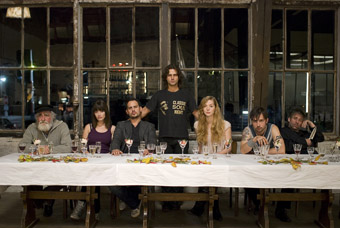
Soul Kitchen
THE FESTIVAL OF GERMAN FILM LOOKS PARTICULARLY STRONG THIS YEAR, WITH CONTRIBUTIONS FROM MICHAEL HANEKE (THE EAGERLY ANTICIPATED THE WHITE RIBBON: VILLAGE LIFE UNRAVELLED BY STRANGE EVENTS BEFORE WORLD WAR I), MARGARETHE VON TROTTA (VISION—AUS DEM LEBEN DER HILDEGARD VON BINGEN; A BIOPIC OF THE MEDIAEVAL COMPOSER AND VISIONARY) AND THE BRILLIANT TURKISH-GERMAN DIRECTOR FATIH AKIN WITH AN UNEXPECTED COMIC TURN, SOUL KITCHEN (THE TALE OF A RESTAURANT THAT ENJOYS UNLIKELY SUCCESS).
fatih akin
Akin, best known for Head-On (2003) and The Edge of Heaven (2007), both available on Madman DVD, receives warranted special attention in this year’s festival with the screening of his rarely seen early film Short Sharp Shock (1998) and, a personal favourite, the freewheeling documentary Crossing The Bridge—The Sound of Istanbul (2005) which explores Turkish music in many of its permutations—from various traditional forms to street music and punk. The musical diversity is astonishing, capturing the essence of Istanbul as a meeting point of cultures. Young musicians are voluble about their art in casual interviews while the more formal engagements with the elder statesmen and women of traditional and popular music are framed by fascinating historical footage and excerpts from old movies. The Bridge is impressive on the Madman DVD, replete with hours of additional music, but the big screen is the film’s real home, Akin excelling in conveying a vivid sense of the city. With adroit camera work and editing and German musician Alexander Hacke (formerly of Einstürzende Neubauten) as our guide the sense of a personal journey deep into this east-west culture is embracing.
Akin’s Short Sharp Shock follows three men, a Turk, a Greek and a Serbian struggling to survive in Germany by whatever means until fatally entangled with a gangster. The film, nominated for Best Film at the 1998 German Film Awards, will doubtless contrast sharply with Akin’s latest, Soul Kitchen (2009), described in the festival’s program guide as offering “the audience exquisite cuisine in this comedic look at a German-Greek chef running a Hamburg eatery who upsets regular customers when a new chef presents his nouvelle cuisine.” But the run-down restaurant becomes a success. To see how Akin has adapted his skill at carefully developed, closely observed drama with explosions of emotion to the substantial demands of comedy will doubtless provide a special festival pleasure. One thing is certain, Akin hasn’t abandoned his intercultural concerns.
Food, under the banner of Culinary Comedies, is one of the festival’s themes. Others in the category include Anno Saul’s popular Kebab Connection “about a German-Turkish aspiring filmmaker who dreams of making the first German Kung Fu movie while shooting commercials promoting his uncle’s kebab restaurant in Hamburg.” In his fourth contribition to the festival, Fatih Akin co-wrote the script.
shooting the past
The past plays a considerable role as content in the festival, from the middle ages to Haneke’s pre-World War I White Ribbon and an account of the young Hitler after that war in Urs Odermatt’s Mein Kampf, to Jewish sporting stars denied involvement in the Berlin Olympics in Kaspar Heidelbach’s Berlin’ 36, and a 1943 lesbian relationship in Max Färberböck’s Aimee & Jaguar. It’s then on to more recent times with films addressing life in Berlin in Friedemann Fromm’s three-part The Wolves of Berlin, the long-term personal consequences of Baader-Meinhoff-type terrorism in Susan Schneider’s The Day Will Come and the limits of Bosnian-Serbian war crimes trials in Hans-Christian Schmid’s impressive Storm.
Mediaeval history is addressed not only in von Trotta’s Vision (with the excellent Barbara Sukowa starring) but also Sönke Wortmann’s Pope Joan: “A ninth century woman of English extraction born in the German city of Ingelheim disguises herself as a man and rises through the Vatican ranks.” This fiction, based on the Donna Cross novel, features Johanna Wokalek (Gudrun Ensslin in The Baader Meinhof Complex). The big budget, the English-language shoot and a cast including David Wenham, John Goodman and Iain Glenn suggest the film is squarely aimed at the international market. Prominent German director Sönke Wortmann is one of the festival’s special guests.
The 20th century comes into focus with Haneke’s White Ribbon and then Kaspar Heidelbach’s Mein Kampf, based on a play by George Tabori. The young Hitler in 1910 shares a room with a Jewish bookseller, is rejected by an art school, feels suicidal and, at the bookseller’s suggestion, looks to a future in politics. Doubtless, as with Downfall (2004) there will be complaints about another attempt to ‘humanise’ the fuhrer. Kaspar Heidelbach’s Berlin ‘36 offers an intriguing ‘true story’ of a champion Jewish high jumper forced to return from Britain to train with the German Olympic team. In this way she will save her threatended family and the Nazis will minimise American government opposition to a games without German Jews. The Nazis add a newcomer to their team, a peculiarly masculine young woman on whom they pin their hopes to oust the Jew. It’s a rather plain, plodding film, if occasionally suspenseful and, in the end, rather surprising when you see images of the film’s actual subjects. For an alternative to Nazi machinations, there’s Florian Gallenberger’s John Rabe, “the true story of a German businessman who saved more than 200,000 Chinese lives during the Nanjing massacre in 1937-38.”
Max Färberböck’s Aimée & Jaguar, Germany’s official entry for the 1999 Academy Award for Best Foreign Language Film, is set in 1943 and is another ‘true story’ again focused on women, this time lesbians, one a wife with four children and a husband at war and the other Jewish and in the resistance. Berlin-based Erica Fischer, the author of the widely published non-fiction book Aimée & Jaguar, is a leading feminist and another special guest of the festival.
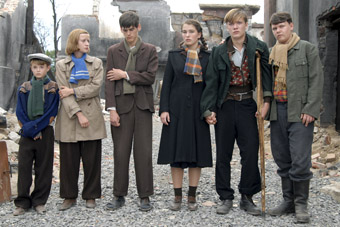
The Wolves of Berlin
Friedemann Fromm’s three-part The Wolves of Berlin, originally made for television, covers three periods of the city’s history at critical moments in 1948, 1961 and 1989 by focusing on a teen clique as they age and the world changes radically. Susanne Schneider’s The Day Will Come brings us close to the present. Like a good thriller the film initially makes its audience work at piecing together clues of all kinds about a female farmer and an aggressive young woman who seeks her out. A certain rhythmic sameness and a later inclination to melodrama don’t prevent the film from being an interesting study of how a 1970s terrorist can live in denial and face the challenge of exposure. I liked it better on reflection and as a companion work to the very different Baader Meinhoff Complex.
hans-christian schmid’s storm
Hans-Christian Schmid’s Storm is an impressive inclusion in the program. I was lucky to see a preview of this largely English language film starring Kerry Fox as a War Crimes Tribunal prosecutor thrown at short notice into the trial of a Serbian commander turned popular politician. What seems straightforward becomes quickly and dangerously complex in the manner of a good political thriller. But Schmid pays consistent attention to the realpolitik of the European Union’s attempts to defuse murderous local tensions by overriding ordinary citizens’ need to recount their war experiences.
Storm effectively addresses the big political picture while focussing on the pain of players and victims, with Kerry Fox excellent as a lawyer who finds her own life trapped in these contradictions. Fox creates a laid back persona, droll, determined, often blunt, but increasingly alert to political and emotional nuances that will test her own morality as events unfold. The fine widescreen cinematography embraces both intimate scenes and varied location choices.
One pointer: as Storm unleashes its series of climactic events you certainly need to pay attention to the political and legal machinations as they play out. Storm is suspenseful, moving and memorable, its story an unusual and admirable choice.
There’s much more to the 2010 Festival of German Film: more films on cuisine, thrillers (Anno Saul The Door; Maximilian Erlenwein’s Gravity starring festival guest Jürgen Vogel), more engagements with German multiculturalism (Burhan Qurbani’s Faith; Feo Aladag’s When We Leave) and films for younger audiences. German press and radio film critic Anke Sternborg, another of the festival’s guests, will provide the context in which to understand the diversity, themes and successes of the German film industry.
Audi Festival of German Films: Chauvel Cinema/Palace Norton Street, Sydney, April 21-May 2; Palace Cinema Como/Palace Brighton Bay, Melbourne, April 22-May 2; Cinema Paradiso, Perth, April 22–26; Palace Centro, Brisbane, April 28–May 4; Palace Nova, Eastend Cinemas, Adelaide, May 7-May 9; www.goethe.de/australia
RealTime issue #96 April-May 2010 pg. 22
© Keith Gallasch; for permission to reproduce apply to realtime@realtimearts.net
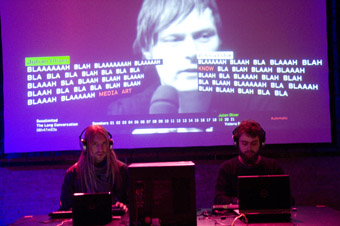
Sosolimited, The Long Conversion
photo Jonathan Gröger/transmediale
Sosolimited, The Long Conversion
THIS YEAR’S EDITION OF TRANSMEDIALE MARKED A NEW COLLABORATION BETWEEN THE FESTIVAL AND ITS SISTER EVENT CLUB TRANSMEDIALE. THE RESULTING PROGRAM, OVERLAP—SOUND & OTHER MEDIA, BROUGHT A SERIES OF EXPERIMENTAL AUDIOVISUAL PERFORMANCES TO TRANSMEDIALE’S MAIN HUB, THE HOUSE OF WORLD CULTURES IN BERLIN.
Probably the most anticipated performance was the much-hyped live AV set from Japan’s Ryoki Ikeda. Having been impressed by his immense, exquisitely designed installation data.tron [3 SXGA version] (2007-9) I was hoping Ikeda’s performance would elevate his sublime, yet somehow unsatisfying graphics to a more meaningful level. What a disappointment then, that Test Pattern actually delivered something far less. Against a large square projection, Ikeda stood at his laptop and set loose an onslaught of driving percussion, the minimal beats occasionally disrupted by bleeps and bursts of static and noise. On the screen behind, horizontal black and white lines flickered up and down across two vertical panels—the lines, their frequency and shade constituting a direct conversion of Ikeda’s audio signal. Initially the perfectly synchronised beats and stark graphics made an impressive impact, however as the minutes passed by the effect wore thin. The screen eventually subdividing into smaller sections did little to reinvigorate the relentless, flickering graphics.
Stylistically similar, but infinitely more intriguing was POWEr by Canadian duo Artificiel, a commissioned AV work developed around a Tesla coil. Two cameras and a microphone relay video and audio to Artificiel’s laptops where it is processed and played back live. For the performance the Tesla coil stood to the front left of the stage under a soft spotlight. A large screen hung vertically at the back and Artificiel themselves were as far offstage as to be effectively invisible. The piece started simply, just the coil and the wonderfully powerful, amplified electric current. After this small tribute, a pause and the real show commenced. In a slow, deliberate rhythm Artificiel fired off the Tesla. With each beat a stark black and white still shot of the electricity burst onto screen. The milky white arc was captured in stunning quality, complex rivers and veins set beautifully against black. As the soundtrack progressed and grew more complex, the images started to overlap, replace, repeat, eventually inverting and breaking into smaller panels. Artificiel at times confused the integrity of the ‘live’ footage by mixing in time-delayed samples or continuing playback while the Tesla stood silent.
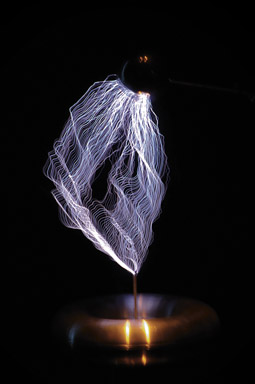
POWEr, Artificiel
photo © de_buurman
POWEr, Artificiel
Continuing the dominant black and white theme, I caught a nice performance, A Cable Plays, at Club Transmediale using openFrameworks open source software. Two artists, Chris Sugrue (US) and Damian Stewart (NZ), both part of the openFrameworks development group, sat cross-legged opposite each other at a black, square board decorated with a tight grid of pins. The artists took turns threading white string through the grid, building up interesting, minimal geometries. Meanwhile a live overhead camera transmitted the scene to a large screen for the audience. The position and movement of the string was analysed in openFrameworks to trigger, warp and distort a live electronic soundtrack. Additional graphics and animations popped onto the main screen occasionally and were ‘pushed aside’ or otherwise affected by the threading of the string. A simple piece, “inspired by the hidden codes of human behaviour and the hidden logic of games,” but well executed.
Another highlight for me was The Long Conversion by American MIT graduates, Sosolimited. Soso hijacked the audiovisual stream of Transmediale’s eight-hour keynote discussion and presented their own subversive remix. Two volunteer typists sat at computers under a large screen and entered the spoken conversation in real time. This text data was then scanned, analysed, and playfully repositioned over the top of the original feed. Presented as info-graphics, the piece subverted the content of the discussion, charting the frequency of particular words, finding ‘hidden’ syntax clues and otherwise messing with the signal. The actual video and audio streams were also manipulated and distorted to render the discussion at times comical, threatening, dream-like or plain false. It was clever, funny and beautifully designed.
In celebration of Transmediale’s new partnership with eArts Festival Shanghai, the festival closed with a special showcase from contemporary Chinese media artists. The first of the two performances started promisingly, with sound artist Zhang Jian hidden behind a screen at the front left of the stage on which a large golden ‘sun’ was rear-projected. He and his instrument appeared only as shadows against the golden orb. Visual artist Aaajiao stood at a console at the right of the stage and controlled a projection of generative cloud formations onto the back wall. Zhang Jian stepped in and out of the projected sun, augmenting the sound from his mysterious instrument (which through later research I discovered to be several of his Buddha Machines placed on a ‘wooden-man’ martial-arts training structure). Meanwhile Aaajiao played with the volume, texture and speed of his ever-drifting clouds, the most interesting moments coming when he amped up the pace of these transformations to build some kind of rhythm. For the most part however, these changes felt awkward and off-time. Also questionable was the decision to generate the clouds onscreen. Watching the little puffs obviously being clicked into existence was disconcerting. The main problem with this show, however, was that nothing really happened before it abruptly ended 30 minutes later.
Next Feng Mengbo took the stage, games console in hand. Immediately we were hit with the bright colour and bouncing electronic soundtrack of his self-developed computer game in which a Chinese character in Communist greens takes over the world country by country (level by level), armed with Coke cans for ammunition. After claiming America, he heads to the moon—at which point, unforutnately, the game got stuck in an irrecoverable loop and, after sitting through two restarts, the impatient crowd forced the performance to be abandoned. The game was really quite good and there was a certain audacity in closing the festival with a Nintendo console performance, but the programming seemed questionable rather than being about maverick artistic intervention.
While it had looked good on paper, Overlap was not exactly successful. Despite some highlights, the works generally felt safe and often just a bit dull. It was disheartening to witness the shortage of fun, poetry and adventure. This is particularly disappointing in Berlin, a mecca for experimental electronic arts of all imaginable forms. Perhaps Transmediale had decided their festival was not the place for a sound performance using algae-generated electricity to search radio frequencies for interdimensional beings. (No, I didn’t make this up.)
Overlap—Sound & Other Media, Transmediale, 2010, various venues, Berlin, Jan 28-Feb 7, www.clubtransmediale.de/ctm-festival
RealTime issue #96 April-May 2010 pg. 23
© Lucy Benson; for permission to reproduce apply to realtime@realtimearts.net
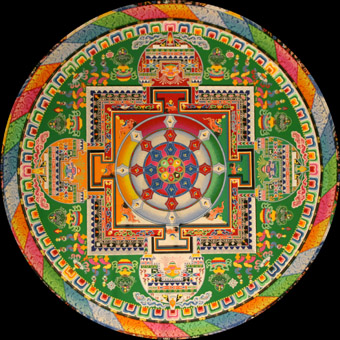
Nanomandala, Victoria Vesna, James Gimzewski
courtesy the artists
Nanomandala, Victoria Vesna, James Gimzewski
IN A BLACKED-OUT ROOM, AS PART OF JOHN CURTIN GALLERY’S ART IN THE AGE OF NANOTECHNOLOGY EXHIBITION, THE TIBETAN BUDDHIST SAND MANDALA OF CHAKRASAMVARA GLOWS IN SATURATED COLOURS, PROJECTED FROM ABOVE ONTO A TWO-METRE DIAMETER SANDPIT.
The intricately rendered geometric patterns, human figures, tiny creatures and curling clouds are readable in their entirety for just a few seconds before the image zooms back towards the grains of sand from which the original mandala is constructed.
Quickly the detail recedes into areas of bright colour, localising towards the centre of the mandala, and soon we are looking at ever-growing grains of brightly coloured sand, filling more and more of the circular field of vision. They morph into a micro-landscape of boulders and edges before the rich hues fade and we begin to ‘see’ at the nano-level—a scale at which colour itself ceases to exist and the sandscape becomes flakes and mounds of rippled grey and white. From here begins the slow, meditative return to the macro scale: the looped projection is a 15-minute journey from the visible to the unimaginable and back, across a realm encompassing aesthetic, scientific and spiritual dimensions.
Artist Victoria Vesna and scientist James Gimzewski have collaborated on several projects involving nanotechnology, a field that extends what is ‘seen’ to its outer limits, using instruments that don’t photograph but gather physical data by ‘touching’ molecular surfaces—data that is algorithmically interpreted to produce visual images. Four monks from the Tibetan Gaden Lhopa Khangtsen monastery in India worked full time for a month to create the original mandala for the Los Angeles County Museum of Art. Vesna and Gimzewski then photographed it at a range of scales from wide-angle to macro lens. The mandala’s central motif was recreated in the laboratory, where it was imaged firstly with an optical microscope and then a Scanning Electron Microscope. To create a seamless video projection that would zoom down to the nanoscale took 300,000 individual frames—around 900GB of data. Rendering the final composition took 36 computers two full days to complete.
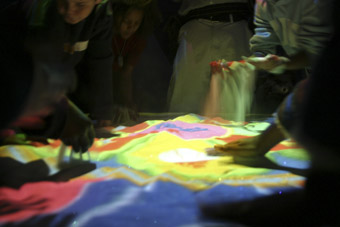
Nanomandala, Victoria Vesna, James Gimzewski
courtesy the artists
Nanomandala, Victoria Vesna, James Gimzewski
The intensity of the lab-work resonates with the Buddhist practice of creating the mandala: a process involving extreme finesse and patience in which finely corrugated, sand-filled cones are gently rubbed so that grain-by-grain the image is built into being. The link is not arbitrary: Vesna’s relationship with Tibetan Buddhism goes back to her college days, when she first read Robert Thurman’s translation of the Tibetan Book of the Dead. “Buddhism and meditation were always informing my practice,” says Vesna, “and to be participating in the creation of the Chakrasamvara was a great teaching and transmission for me.”
The themes of life, death and transition seem to lend themselves to an artistic engagement with nanotechnology: other works in the Art in the Age of Nanotechnology exhibition explore these themes in several ways, creating human interactions at the borderline between the known and the unknowable of objects that are measured in billionths of metres.
The creation of Nanomandala in 2003, says Vesna, has influenced her subsequent work (see Blue Morph or Quantum Tunnel, also collaborations with Gimzewski) both in terms of its interactivity and the sense that the artwork is “manifested” rather than directed, with a specific energy and path of its own. At face value, the ‘interactivity’ of Nanomandala is limited—viewers can sculpt the sand while the image creeps across it, or sift it through their fingers—but in the context of the scale and delicacy of Nanomandala, this seems an almost clumsy interaction with a work that otherwise operates at high precision and high resolution. Watching the entire 15-minute loop, however, is a commitment to a kind of meditation and exchange; and this meditative interaction seems much more to the point.
Nanomandala’s aural component, by sound artist Anne Niemetz, runs parallel in scale to the shifting images: a collage that by turns includes the deep, harmonics-soaked throat-singing of the Tibetan meditation chant and the highly amplified sounds of the monks’ sand-sculpting tools—vibrating, cricket-like rubs and taps that accompany the image as it approaches nano-scale.
The sheer, vivid beauty of Nanomandala—though Vesna points out that terror is equally a part of the mandala image—sets it apart from the other works in this exhibition, as does an engagement with the spiritual that does not look to conceptualism for its validity. Despite both an immense degree of technical production, and its strong engagement with Tibetan Buddhist practice, Nanomandala has an aesthetic simplicity and spaciousness that leaves abundant room for individual response and contemplation.
Perth International Arts Festival: Victoria Vesna and James Gimzewski, Nanomandala (2003), exhibited in Art in the Age of Nanotechnology, John Curtin Gallery, Curtin University of Technology, Perth, Feb 5-April 30
Read about other works in this exhibition here.
RealTime issue #96 April-May 2010 pg. 23
© Urszula Dawkins; for permission to reproduce apply to realtime@realtimearts.net
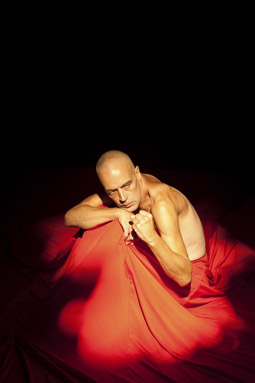
Brian Lucas, Performance Anxiety
photo Fiona Cullen
Brian Lucas, Performance Anxiety
BRIAN LUCAS’ NEW SOLO WORK, PERFORMANCE ANXIETY, WAS A SEAMLESS 90 MINUTES OF LACERATING PERFORMANCE THAT OFTEN HAD YOU WITH YOUR MOUTH HANGING OPEN AT THE SHEER BRAVURA OF THE BEAST.
Reeling away after the event, the expansive realisation began to seep in that you had attended an undoubted master work. Lucas has long held a national reputation for his intelligent physical performance works sedulously crafted by a mature artist from his considerable background skills in both theatre and dance. Now he literally leaps onto the world stage at the World Theatre Festival at the Brisbane Powerhouse, the venue which had commissioned his first major one man show, Monster, in 2000.
This is not to say Lucas has summarily trumped himself. He emerged fully fledged with most of his salient moves intact. Having followed him along the way, I can say that his earlier, more autobiographical pieces had the same rueful insights. His best talent has always been to describe being in motion, to depict who he was always becoming, vulnerable to himself but also portraying a sense of multiple selves simmering beneath his skin. Hence it was a bit off-putting at first to see him wearing contemporary clothes in his latest work. This break into costume came earlier, in Underbelly (2006), a baroque piece that interrupted Lucas’s plans to complete his personal trilogy, and was vomited forth in response to the media spin of the Howard years. Not much has changed from that perspective, so Lucas has gone on to meet his audience by unleashing other selves fitting for the times and exposing his own fears, his own performance anxieties amidst the moral ambiguities of the media-hyped post-9/11 world.
In line with Lucas’s continual experimenting with form, The Turbine Rehearsal Room has been tricked up for a cabaret performance in the round at “The Loser Bar” by designer Kieran Swann. The ambient success of this integrated vision is also a measure of Lucas’s collaborators. Swann has created a dais fitted out with hidden lights and exits for smoke to create a plethora of effects. It also has a special floor which enables Lucas in an initial moment to rise like a curtain with sheets draped around his waist and to metamorphically extend into the audience through his dance reach. Andrew Meadow’s superb lighting extends from a hermetic bed-chamber to a flare-lit war zone to framing a stunning mise-en-scene of interrogation rooms illuminated by single lightbulbs among the audience. Unfortunately Lucas can’t sing, so he informs us, “although he would like to” (just as he would “like to be an American”, or that he “was more driven to achieve” etc). This point was ironically underscored with an elegant and evocative sound collage by Brett Collery—Handel’s Largo, a baroque chorale, a modern classical boys’ choir, a female dolorosa and, finally, the big band version of “I’d like to teach the world to sing.”
Lucas has his own vibrant tones, of course. As poet-cum-dramatist he decides not to present a case study, but to respond to a quote from James Joyce: “Within the particular is contained the universal.” He presents four different characters who share a sense of anxiety despite the substantial differences in their circumstances: L’Amour, the Torch Singer; Limbo, the War Correspondent; Lunacy, the Orator; and Lachrymosa, the Stand-Up Comedian. And there is the diffident and dyspeptic performance persona named Brian Lucas.
As the audience enters, Lucas is lying down, covered in rose petal sheets and tossing and turning, uncomfortable in his own skin and unable to perform sexually with his partner. Eventually he rises in female guise with sheets clinging to his hips and sweeps into a dance of romantic desire for the Falling Man from the Twin Towers. She tells her psychiatrist, “I had fallen, just as the man had fallen.” Lachrymosa comments in a vocal loop back that, “She finally takes off her skin and lays herself bare—and it’s all in a lost cause.” The next scenario after interval is pure 60 Minutes. Limbo represents the sort of correspondent who can only read his teleprompter: “That’s what they want. So I give it to them.” Captured by the other side, he similarly parrots the script that has been given to him. Lunacy the Orator and an old man ambiguously share sadomasochistic rites. Lachrymosa is a shocker who dies of a heart attack. Lucas brilliantly represents them all at a rapid pace, for good and for evil and beyond both.
Brian Lucas has ever been aware of the daunting trial of self-consciousness and self-creation that is attributed to the artist, but which he rightly regards as our common lot. He genuinely sees himself as an ordinary person who goes through ordinary motions in the world in common with his audience, which perhaps accounts for his immense crowd-pleasing capacity in this unlikely format. What did we take away from his performance that strengthened us, as it undoubtedly did? Beneath the diffidence, beyond the chronic dyspepsia, Lucas’s tacit approach seemed to embody a panacea for the human condition recommended by the poet Rainer Maria Rilke: “Be patient toward all that is unsolved in your heart and try to love the questions themselves…Live the questions now. Perhaps you will gradually, without noticing it, live along some distant day into the answer.” Not the least aspect of Lucas’s heterogeneous art is that it seems designed to reinstate the magical arts and crafts of remembrance employed by Mnemosyne and her daughters to keep us safe from Lethe’s fatal river of media-induced forgetfulness.
Performance Anxiety, created & performed by Brian Lucas, sound designer Brett Collerym designer Kieran Swann, lighting Andrew Meadows; Turbine Rehearsal Room, Brisbane Powerhouse, Feb 9-13
RealTime issue #96 April-May 2010 pg. 30
© Douglas Leonard; for permission to reproduce apply to realtime@realtimearts.net
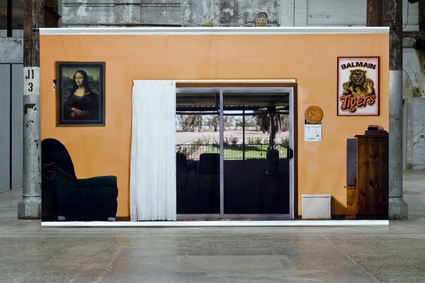
Habits & Habitat, Patrick Ronald and Shannon McDonell, courtesy the artists
WASHED ASHORE ON THE ISLAND OF BROBDINGNAG, FINDING HIMSELF DWARFED AMONG “ENORMOUS BARBARIANS,” SWIFT’S INTREPID SURGEON LEMUEL GULLIVER UTTERS A TELLING OBSERVATION. “UNDOUBTEDLY PHILOSOPHERS ARE IN THE RIGHT,” HE SAYS, “WHEN THEY TELL US THAT NOTHING IS GREAT OR LITTLE OTHERWISE THAN BY COMPARISON.”
Exploring the artworks recently presented as part of Performance Space’s You Are Here program, I found myself channelling Gulliver on more than one occasion, my certainty of place unravelling before works that playfully turned the familiar into the unfamiliar. Swift’s satirical treatise on geographic and cultural relativity also came to mind as something of a blueprint for some of the driving concerns of Australian art practice today. These concerns are set to intensify in coming months, as David Elliot’s provocative theme for the 17th Biennale of Sydney: The Beauty of Distance, Songs of Survival in a Precarious Age [see p10] brings the politics of place firmly back into focus. And although not connected to the Biennale in any way, the works presented here in fact made quite a neat forerunner to that event.
The title of the program, You Are Here, suggested a more matter-of-fact take on the subject of place than Elliot’s normative statement on geographic extremity, clearly intended to challenge. Still, the questions raised are similar. From among the three media works installed in the gallery and foyer space at CarriageWorks in Sydney emerged common concerns for the relational nature of place, history and memory in the Australian landscape, both urban and rural. And while each work proved markedly different in its realisation, taken as a whole the program was highly effective in dislocating fixed ideas about where we are situated in space and time.
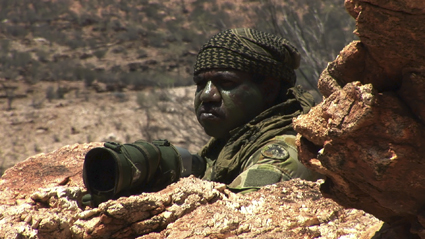
One of Several Centres, Alex Kershaw, courtesy Grant Pirrie
Photographer and video artist Alex Kershaw turned his attention to the desert town of Alice Springs, Australia’s mythic ‘red centre,’ in the multi-screen video installation, One of Several Centres, presented in the gallery space. Kershaw’s videos appeared to eschew a documentary or ethnographic approach, instead favouring a kind of topographical collage in their cumulative tracking of sites both within the town and the outlying bush and scrub areas. Further defying expectations, Kershaw mocks the touristic gaze and its attraction to monuments, homing in on the more mundane or seemingly insignificant features of the landscape while at the same time capturing locals performing a series of Fluxus-style follies. A number involved delineating or marking up space, from a man laying a narrow strip of lawn on a concrete roundabout to a woman walking her dog around the inside perimeter of a disused water tank.
In a nod to Jon Rhodes’ project Whichaway? [documenting the photographer’s extended interaction with the Aboriginal community of Kiwikura, 1974-96, Eds], cited by the artist as an influence, Kershaw draws on the strategy of using sequences charged with absurdity to image new relationships between space and time in the desert. Ultimately, the videos succeed in using play and whimsy to engage audiences while also making a more serious point about the need to move beyond fixed notions of ‘here’ and ‘there’ in the Australian landscape. From this focus on geographic relativity also emerges the realisation that, in true Swiftian fashion, many of the mental constructs which shape our perception of the world around us may be equally contingent; the difference between wild and domesticated, inside and outside, tourist and local, habited and uninhabited, traditional and contemporary, all little more than matters of the mind.
Stepping outside the gallery space and into CarriageWorks’ soaring industrial foyer, evidence of its former life as a hub for the construction of Sydney’s rail network is still visible on the building’s skin. At the time of writing, politicians, urban planners and architects were in a wrangle over the future of a more controversial former industrial site, the concrete apron at Sydney Harbour’s Barangaroo, with Paul Keating waging war against the city’s alleged “industrial determinism.” With so much focus on the city’s architectural fabric, it was refreshing to encounter Nigel Helyer’s haunting site-specific sonic sculpture, GhosTrain, which dealt with a far more ephemeral, and hence easily overlooked, form of heritage: the sounds of the city. As Helyer puts it, “the acoustic ecologies of industrial landscapes are prime examples of our extraordinary capacity for amnesia.”
Referencing CarriageWorks’ former use, Helyer’s 60-second sound installation, to be repeated in the forthcoming May-June program, plays the recorded sounds of a steam locomotive starting up, pumping out steam and then quickly accelerating to enact a sonic transportation to another era, another time. Beyond its nostalgic qualities, the work proved interesting for the questions it raised about whether urban sounds should be preserved and archived for future generations. This would entail a broadening of our concept of heritage to embrace senses other than sight and an acknowledgment of the link between sound and embodied space, for sounds signify activity and hence lived presence. A big ask, yet by neglecting soundscapes we risk preserving buildings as empty architectural shells.
While Helyer’s GhosTrain offered a site-specific sonic reading of the foyer space, photomedia artists Patrick Ronald and Shannon McDonell brought an apparent slice of rural life to the site in their installation, Habits & Habitat. In a life-sized, 1:1 photographic diorama of a domestic interior, the glimpse of dry scrub through a window, a kitsch rooster clock on the kitchen wall, a pair of Blundstone boots by the laundry door all lend what otherwise appears a typical family home the context of a rural setting.
But just as the manipulation of scale in Gulliver’s Travels leads the narrator to probe his surroundings as if under a microscope, here slight tweaks in the images lead us to question their authenticity as photographic documents (is that print of the Mona Lisa on the wall, for example, not actually a jigsaw puzzle?). In fact, the artists have applied a unique brand of photogrammetry to the images, a process of intricate digital manipulations which results in seamless composite images. This insertion of unexpected details and the juxtaposition between real and unreal elements results in an uncanny sense of displacement. At the same time the accumulation of detail, writes Performance Space Director Daniel Brine, “investigates cultural transfer, the connection (and disconnections) between country and city, and the ways that the ‘bush’ continues to inform Australian culture and identity.”
Taken literally, visitors to Performance Space’s You Are Here program might have expected to encounter artworks that presented fixed, or even instructive, interpretations of place and landscape. Far from it, a sense of journey emerged from the works that was unconventional in its focus on ‘in-between’ spaces and movement between various cultural signposts. In less skillful hands, concerns over Australia’s geographic and cultural relativities can too easily slide into tedious and repetitive neuroses. One hopes that in upcoming events we will continue to dwell in its fruitful and generative possibilities.
You Are Here: Alex Kershaw, One of Several Centres, Feb 11–March 6, Nigel Helyer, GhosTrain, Feb 11–March 17, May 13-June 5, Patrick Ronald and Shannon McDonell, Habits & Habitat, Feb 11-March 17; Performance Space, CarriageWorks, Sydney
RealTime issue #96 April-May 2010 pg. 44
© Ella Mudie; for permission to reproduce apply to realtime@realtimearts.net









































































